

IELTS AC Reading: Cambridge 13 Test 4; Reading Passage 3: Book Review; with best solutions and detailed explanations
This IELTS Reading post deals with Cambridge 13 Reading Test 4 Passage 3 which is entitled ‘Book Review’ . This post discusses all the answers and solutions for Reading Passage 3. This is another intended post for candidates who have the most difficulties in finding and understanding IELTS Reading Answers. This post can simply guide you the best to figure out every Reading answer without trouble. Finding IELTS Reading answers is a step-by-step routine and I hope this post can assist you in this topic.
Cambridge 13 Reading Test 4 Passage 3 :
The headline of the passage: book review.
Questions 27-29: (Multiple Choice Questions)
[ Multiple choice questions are a common type of question set in the IELTS Reading test. It is also found in the Listening test. Most of the time, they come with four options but sometimes there are three options. Candidates need to work hard for this type of question because this may confuse them easily in passage 2 or passage 3. There will be long answers for each question, so they may kill valuable time. So, a quick reading or skimming technique might come handy here. Remember that answers in 3 options out of 4 will be very close. So, vocabulary power will help a lot to choose the best answer.]
[ TIPS: Skimming is the best reading technique. You need not understand every word here. Just try to gather the gist of the sentences. That’s all. Read quickly and don’t stop until you finish each sentence.]
Question 27: What is the reviewer’s attitude to advocates of positive psychology?
Keywords for this question: reviewer’s attitude, advocates of positive psychology
We can find the reference to ‘positive psychology’ in line 6 of paragraph no. 1. Here, the writer defines ‘positive psychology’. However, the mention of ‘advocates of positive psychology’ is found in line 12 of paragraph no. 2. The writer says in lines 2-5 about them, “Those who think in this way are oblivious to the vast philosophical literature in which the meaning and value of happiness have been explored and questioned, and write as if nothing of any importance had been thought on the subject until it came to their attention .”
Here, as if nothing of any importance had been thought on the subject until it came to their attention means they are actually ignorant about the ideas which they should consider.
*The word oblivious also means unaware or ignorant .
So, the answer is: D
Question 28: The reviewer refers to the Greek philosopher Aristotle in order to suggest that happiness
Keywords for this question: Aristotle,
We find the mention of Greek philosopher Aristotle in line 7 of paragraph no. 2. So, we need to scan the lines carefully. Here, the writer says in lines 6-10, “For Bentham it was obvious that the human good consists of pleasure and the absence of pain. The Greek philosopher Aristotle may have identified happiness with self-realisation in the 4th century,. .. . .. .. . but for Bentham all this was mere metaphysics or fiction.” The writer discusses here that Bentham considers happiness as only with pleasure and with the absence of pain. But for Aristotle it was not only pleasure and absence of pain. Rather, it was something that could be identified by self-realisation, which may not seem correct all the time.
So, the answer is: A
Question 29: According to Davies, Bentham’s suggestion for linking the price of goods to happiness was significant because
Keywords for this question: Davies, Bentham’s suggestion, linking, price of goods,
The answer is in the fourth paragraph, where the writer talks about price of goods. Here, in the last few lines, the writer says, “By associating money so closely to inner experience, Davies writes, Bentham ‘ set the stage for the entangling of psychological research and capitalism that would shape the business practices of the twentieth century’.” The writer explains here that Bentham had associated money or price of goods with inner experience and thus made a connection between work and human psychology.
So, the answer is: B
Questions 30-34: (Summary completion with NO MORE THAN ONE WORD)
[In this kind of question candidates are given a summary for one, two or three paragraphs with some fill in the blanks questions. As these are fill in the blanks or gaps, there is a condition of writing no more than ONE, TWO, or THREE words for each answer and candidates must maintain this condition. Candidates need to find out the related paragraphs by correctly studying the keywords form the questions. Then, they should follow the steps of finding answers to fill in the gaps.]
Title of the summary: Jeremy Bentham
Question 30: In the 1790s he suggested a type of technology to improve _________ for different Government departments.
Keywords for this question: 1790s, technology, to improve, different Government departments
The answer to this question lies in paragraph no. 3, lines 6-7 where the author writes, “In the 1790s, he wrote to the Home Office suggesting that the departments of government be linked together through a set of ‘conversation tubes’.”
These lines indicate that Bentham proposed to the Home office that Governmental departments should establish communication with Home office through ‘conversation tubes’.
So, the answer is: F (communication)
Question 31: He developed a new way of printing banknotes to increase ________
Keywords for this question: developed, new way, printing banknotes
In paragraph no. 3, the author says in lines 8-9, “… and to the Bank of England with a design for a printing device that could produce unforgeable banknotes ”. Here, unforgeable means something that cannot be forged or falsified or falsified. So, this means that Bentham actually developed a new way of printing banknotes to increase safety or security .
So, the answer is: B (security)
Question 32: and also designed a method for the ________ of food.
Keywords for this question: designed, method, food
The reference to food can be found in lines 9-10 of paragraph no. 3. “He drew up plans for a “frigidarium” to keep provisions such as meat, fish, fruit and vegetables fresh.” These lines directly refer to the preservation of food .
So, the answer is: G (preservation)
Question 33: He also drew up plans for a prison which allowed the _______ of prisoners at all times, … .. . .
Keywords for this question: drew up plans, prison, allowed, prisoners
The answer is in lines 10-12 of paragraph no. 3. Here, the author writes, “He celebrated design for a prison to be known as ‘Panoptieon’, in which prisoners would be kept in solitary confinement while being visible at all time to the guards, ….” Here, while being visible = under observation
So, the answer is: E (observation)
Question 34: when researching happiness, he investigated possibilities for its ________, and suggested some methods of doing this.
Keywords for this question: investigated, possibilities, suggested some methods
The answer to this question is also found in lines 1-2 of Paragraph no. 4. “If happiness is to be regarded as a science, it has to be measured ,….” This means Bentham suggested the methods of taking measurement .
So, the answer is: A (measurement)
Questions 35-40 (YES/NO/NOT GIVEN):
[In this type of question, candidates are asked to find out whether:
The statement in the question matches the claim of the writer in the text- YES The statement in the question contradicts the claim of the writer in the text- NO The statement in the question has no clear connection with the account in the text- NOT GIVEN ]
[TIPS: For this type of question, you can divide each statement into three independent pieces and make your way through with the answer.]
Question 35: One strength of The Happiness Industry is its discussion of the relationship between psychology and economics.
Keywords for this question: The Happiness Industry, discussion, relationship, psychology, economics
The answer can be found in the first few lines of paragraph no. 5 “The Happiness Industry describes how the project of a science of happiness has become integral to capitalism . We learn much that is interesting about how economic problems are being redefined and treated as psychological maladies ”. So, it is clear from these lines that there is a strong relationship between psychology and economics.
So, the answer is: YES
Question 36: It is more difficult to measure some emotions than others.
Keywords for this question: difficult to measure, some emotions,
The answer cannot be found in this passage. There is a sentence in paragraph 5 about the feeling of pleasure and displeasure that can be measured which gives further information for research management and advertising. “In addition, Davies shows how the belief that inner states of pleasure and displeasure can be objectively measured has informed management studies and advertising.” But it is not related to this question.
So, the answer is : NOT GIVEN
Question 37: Watson’s ideas on behaviourism were supported by research on humans he carried out before 1915.
Keywords for this question: Watson’s ideas, behaviuorism, supported, research, humans, before 1915
The answer is found in lines 7-9 of paragraph no. 5 which directly contradicts the given question. “When he became president of the American Psychological Association in 1915, he had never even studied a single human being: his research had been confined to experiments on white rats.”
This means Watson’s experiments were on rats , not on humans.
So, the answer is: NO
Question 38: Watson’s ideas have been most influential on governments outside America.
Keywords for this question: Watson’s ideas, most influential, governments outside America
In paragraph 5 there is no information about the impact of Watson’s ideas on countries outside the USA.
So, the answer is: NOT GIVEN
Question 39: The need for happiness is linked to industrialization.
Keywords for this question: need for happiness, linked, industrialization
The answer to this question can be found in the opening sentence paragraph no. 6 which talks about the need for happiness that is connected with labour market. “ Modern industrial societies appear to need the possibility of ever-increasing happiness to motivate them in their labours.” This is a clear match with the question.
Question 40: A main aim of government should be to increase the happiness of the population.
Keywords for this question: main aim, government, increase, happiness of the population
The writer says in lines 2-3 in paragraph no. 6, “But whatever its intellectual pedigree, the idea that governments should be responsible for promoting happiness is always a threat to human freedom .”
Our question asks to find out the aim. But we find out that this is a comment from the author, not a statement on the aim of government.
So, the answer is: NO
Please leave your comments if you like this post or have any queries about it.
Click here for solutions to Cambridge 13 Test 4 Reading Passage 1
Click here for solutions to Cambridge 13 Test 4 Reading Passage 2
36 thoughts on “ IELTS AC Reading: Cambridge 13 Test 4; Reading Passage 3: Book Review; with best solutions and detailed explanations ”
- Pingback: IELTS academic Reading: Cambridge 13 Test 4, Reading passage 2; Saving the soil, with best solutions and easy explanations | IELTS Deal
Why the answer of 40 is not “Not Given”? In the sentence, it doesn’t mention government’s aim at all
I agree with you 🙂 The question designers of IELTS tests design the tests in a way that even the natives connot answer them correctly!!! I don’t understand it is an analytical test or a test for assessment of our English! I don’t comprehend why they are taking so hard! How many languages except their mother language do they know which expect us know English as well as our mother tongue?!
Sorry:( I am a little angry about the vain rigidity that the world has considered for people!
Hahahahhaha, wonderful???
Totally agree!
Initially, I also struggled to understand the explanation for question 40. After carefully scanning again, I finally found out the problem. We suppose to find the synonym of the key word ‘main aim of the government’ which is located in Paragraph 5, line 10 – ‘the goal of governments’. Reading that sentence, we’ll see that the main aim here is to change the behaviour of the population , not to increase their happiness.
Omg thank u
Government has several aims, and even if one of them is changing the behavior of the population, we still can not be sure whether increasing their happiness is their main aim or not, so the detail cant be in that passage
Just to for fun I guess, cause’ it is wrong answer to make a student have a mistake they say the answer is wrong!
- Pingback: IELTS Academic Reading: Cambridge 13 Test 4, Reading passage 1; Cutty Sark: the fastest sailing ship of all time; with best solutions and easy explanations | IELTS Deal
2 mistakes on ques 6 and 40 🙂
May I ask about the mistakes in details please?
I also found some difficulty in que 6 bcz I think it’s a true but it is false..!
Thanks for explanation But why the q 38 is notgiven ? It is obviously said that :In Britain
But it doesn’t mention ‘most influential’
Why some of the passage 3 in book 12 and 13 are too hard?
Hi thank you for all your information with nice flow to compare frequentist vs bayesian approach. I will look forward to next part of the tutorials!!
You’re most welcome!
The ans of third question should be false
Can you explain que no 37 ..here, they are talking about’ before 1915′ also.. But in passage ,it is mentioned that ‘ he became president in 1915’..
This means Watson’s experiments were on rats, not on humans.
I am from Vietnam and I wish I could do something for you. Since I started to do the tests, this web has helped me a lot
Hello, Thank you for your kind thoughts. My son is extremely sick. As a father, it gives me such a pain to watch him go through this. Please pray for my son.
According to the author’s analysis, the answer 40 seems like a ‘NG’. However, in the last paragraph, the writer gives his own comment that he is not agree with the idea that government should be responsible for promoting happiness, which is just what the question 40 claims. That’s why the answer 40 is a ‘N’ not a ‘NG’, cuz it contradicts the claims of the writer.
How the answer of 35 is yes? AND does it has mentioned that discussing relationship between psychology and economics is the strenght part of The happiness industry?
Thanks a lot.This was helpful
Good day! I always use your system to check my mistakes. The system is perfectly organised. Please, can you give me some advice about reading? I do most of the reading practices but the score is always the same 5.5 or 6.
Hello, I think you can register for some 1-to-1 classes with me. Here, I can help you solve your problems directly. If that sounds good, let me know. Here’s my email: [email protected]
- Pingback: Book Review Reading Answers? The 117 Top Answers - vi-magento.com
- Pingback: IELTS academic Reading: Cambridge 13 Test 4, Reading passage 2; Saving the soil, with best solutions and easy explanations - IELTS Deal
Many thanks.
Could you explain why the answer for 36 question isn’t No. Could you explain why the answer for 36 isn’t No
because there did not mentioned about emotions, only emphasized pleasure and displeasure
Leave a Reply Cancel reply
Your email address will not be published. Required fields are marked *

Academic IELTS Reading: Test 2 Passage 1; The Dead Sea Scrolls; with top solutions and best explanations
This Academic IELTS Reading post focuses on solutions to an IELTS Reading Test 2 passage 1 that has a passage titled ‘The Dead Sea Scrolls’. This is a targeted post for Academic IELTS candidates who have major problems locating and understanding Reading Answers in the AC module. This post can guide you the best to understand […]

Academic IELTS Reading: Test 1 Reading passage 3; To catch a king; with best solutions and explanations
This Academic IELTS Reading post focuses on solutions to an IELTS Reading Test 1 Reading Passage 3 titled ‘To catch a king’. This is a targeted post for IELTS candidates who have great problems finding out and understanding Reading Answers in the AC module. This post can guide you the best to understand every Reading answer […]
Book Review - IELTS Reading Answers
Table of Contents
Book review - ielts reading passage, book review - question and answers.
The "Book Review" passage of the IELTS reading section includes a reading passage related to task 2 with three distinct question types, appropriate answers, and explanations. By utilising this practice exam, you can evaluate your performance, correct your mistakes, and devise a plan to complete the reading test in the allocated time. So, let’s begin with the blog!
The reading test has 60 minutes to finish. To complete the 1–14 questions in this section, allow yourself 20 minutes. Before answering the questions, thoroughly read the passage. Book Review IELTS reading answers are provided for you to compare with your responses and assess your performance.
Book Review
The Happiness Industry: How the Government and Big Business Sold Us Well-Being By William Davies
Richard Layard, an economist and advocate of "positive psychology," has summarised the ideologies and faith of various people nowadays in his proclamation that "happiness is the ultimate goal because it is self-evidently good. If we are asked why happiness matters, we can give no further external reason. It is just evident that it matters." For Layard and others like him, the goal of government is to foster an environment of shared prosperity. The only issue is how to attain it, and here positive psychology—a purported science that not only detects what makes individuals happy but also lets their happiness be quantified - may indicate the way. With the guidance of this study, governments, as per theorists, are currently more capable than ever before of ensuring harmony in society.
It is an incredibly primitive and simplistic style of thinking, yet it is rising in popularity due to this. The huge philosophical literature that has studied and challenged the meaning and worth of happiness is neglected by those who embrace this mind-set, and they write as if no significant ideas had been studied on the subject prior to their realisation. The emergence of this method of thinking was due in large part to the work of philosopher Jeremy Bentham (1748–1832). For Bentham, it was apparent that happiness and the lack of misery constitute the human good. In the 4th century BC, the Greek philosopher Aristotle connected happiness with self-realisation, and scholars throughout the years attempted to combine the goal of happiness with other human virtues, although all of this was just metaphysics or fiction to Bentham. Modern proponents of positive psychology follow in his footsteps, condemning as obsolete and unnecessary almost the entire ethical reflection on human pleasure to date, despite knowing nothing about him or the school of moral theory he founded—as they are ignorant in the history of ideas due to education and philosophical conviction.
However, as William Davies points out in his new book, The Happiness Industry, assuming that happiness is the prime self-evident good restricts moral analysis. This rich, clear, and compelling book's ability to contextualise the modern cult of happiness inside a precisely defined historical context is one of its many merits. Davies was correct in his assessment of Bentham, recognising that he was significantly more than just a philosopher. According to Davies, Bentham engaged in activities that modern-day management consultants serving the public sector may partake in. In the 1790s, he addressed letters to the Bank of England with a model for a printing machine that could generate unforgeable banknotes and to the Home Office with a suggestion that the government's various departments be interlinked by a system of "conversation tubes." To preserve food like meat, fish, fruit, and vegetables, he designed a "frigidarium." His renowned plan for a jail known as a "Panopticon," in which inmates would be confined in solitary while always being monitored by the guards, came extremely close to being implemented. (Interestingly, Davies does not address the fact that Bentham envisioned his Panopticon to serve as a model for both a jail and a control mechanism that could be utilised in both schools and factories.)
Also read: What is the IELTS Vocabulary?
Bentham also established the "science of happiness." If happiness is to be considered a science, then it must be quantified. Bentham presented two methods for measuring happiness. He proposed that pleasure might be measured by taking the average heart rate of a person and seeing happiness as a complex of pleasant emotions. As an alternative, the value of money might be used as the criterion for quantification: if the cost of two distinct products is the same, it can be stated that both give the customer the same amount of happiness. The latter attribute grabbed Bentham's eye more. According to Davies, Bentham "established the foundation for the combination of psychological study and capitalism, which would influence the activities of the twentieth century," by associating money so intimately with inner experience.
In the book The Happiness Industry, it is explained how the pursuit of a science of pleasure has merged with business. We learn a lot of interesting information on the redefining and treatment of economic concerns as psychological conditions. Additionally, Davies demonstrates how management studies and advertising have been influenced by the idea that inner joy and dissatisfaction can be assessed objectively. The inclination of philosophers like J. B. Watson, the pioneer of behaviourism*, was that managers and politicians could mould or influence people. Watson's theories on human nature were not backed by any facts. He had only conducted studies on white rats when he was appointed president of the American Psychological Association in 1915. He had "never really examined a fellow human being." The government in Britain has founded a "Behaviour Insights Team" to research how individuals might be motivated to live in ways that are thought to be socially desirable while incurring the lowest expenses to the public purse. However, Watson's reductive model has already been extensively adopted.
To keep people motivated in their work, modern industrial nations seem to require the potential for ever-increasing happiness. But regardless of its conceptual heritage, the theory that authorities ought to be in charge of fostering happiness is always hazardous to people's freedom.
* behaviourism: a field of psychology in which focus is on observable behaviour
Also checkout: 15 Best IELTS Preparation books in 2024
Questions 1-3
Choose the correct letter, A,B,C or D.
Write the correct letter in the boxes 1-3 on your answer sheet.
1. The critic mentions the Greek philosopher Aristotle, to state that happiness ______.
Is not something that should be fought for.
May not be just pleasure and the absence of pain.
Is not just an abstract concept.
Should not be the main goal of humans.
2. In Davies' opinion, the suggestion that was given by Bentham’s to link the prices to happiness was remarkable because _____.
It established a connection between work and psychology.
It involved consideration of the rights of consumers.
It was the first successful way of assessing happiness.
It was the first successful example of psychological research.
3. What is the reviewer’s opinion on the proponents of positive psychology?
They have a fresh new approach to ideas on human happiness.
They are wrong to reject the ideas of Bentham.
They are ignorant about the ideas they should be considering.
They are over-influenced by their study of Bentham’s theories.
Answer 1: B
Explanation 1: According to the 2nd paragraph, 6th line, For Bentham, it was apparent that happiness and the lack of misery constitute the human good. In the 4th century BC, the Greek philosopher Aristotle connected happiness……….. This was just metaphysics or fiction to Bentham. These lines discuss Bentham's belief that happiness is solely about pleasure and lacks pain. On the other hand, Aristotle held the opposite view, contending that happiness is more complex than mere contentment and absence of suffering. Thus, the correct option is B.
Answer 2: A
Explanation 2: In the 5th line of the 4th paragraph, the beliefs put forward by Jeremy Bentham are described by author Davies. There was also a link made between the costs and happiness. He clarifies Bentham's theory, according to which "the joy received from both of them would be equal if the price of two items is the same." He says that Bentham was the first to establish the link between psychology and business. Thus, the response is yes.
Answer 3: C
Explanation 3: In the 1st line of the 2nd paragraph, they have clarified that this specific concept of happiness was quite well-known despite being incredibly basic and impolite. It is further said that these proponents frequently exhibit obliviousness, which is the tendency to reject the research's explanation of the literal meaning and worth of happiness before they even acknowledge the concept.
Also read: Preface to how the other half thinks - IELTS Reading Answers
Questions 4-8
Complete the summary using the list of words A-G below.
Write the correct letter, A-G, in the boxes 4-8 on your answer sheet.
Jeremy Bentham
Jeremy Bentham was active in other areas besides philosophy. In the 1970s he suggested a type of technology to improve 4…………. for different Government departments. He developed a new way of printing banknotes to increase 5…………. and also designed a method for the 6……….. of food. He also drew up plans for a prison which allowed the 7…………. of prisoners at all times, and believed the same design could be used for other institutions as well. When researching happiness, he investigated possibilities for its 8………… and suggested some methods of doing this.
communication
preservation
implementation
measurement
observation
Answer 4: B
Explanation 4: In the 8th line of the 3rd paragraph, in the 1790s, he addressed letters to the Bank of England with a model for a printing machine that could generate unforgeable banknotes and to the Home Office with a suggestion that the government's various departments be interlinked by a system of "conversation tubes."
Answer 5: C
Explanation 5: According to the 8th line of the 3rd paragraph, he suggested the Bank of England develop a printing press that could create unforgeable banknotes. In other words, since the notes wouldn't be copied, the security will be enhanced. Security is the solution as a result.
Answer 6: D
Explanation 6: In the 12th line of the 3rd paragraph, “To preserve food like meat, fish, fruit, and vegetables, he designed a "frigidarium." This statement suggests that he had prepared strategies and techniques for preserving perishable foods. Thus, option D—preservation—is the correct response.
Answer 7: G
Explanation 7: According to the 13th line of the 3rd paragraph, This line describes how Bentham designed a prison called ‘Panopticon’, a celebrated design. He had built it so the jailer could see the inmates from every angle when confined in a cell. Thus, option G, observation, is the correct response.
Answer 8: F
Explanation 8: In the 1st line, 4th paragraph, “Bentham also established the "science of happiness." If happiness is to be considered a science, then it must be quantified.” the author claims to be the father of the science of happiness and holds the view that anything that might be deemed scientific could potentially be measured. Therefore, F is the correct option.
Also read: Is passing the IELTS reading test too tough?
Questions 9-14
Do the following statements agree with the claims of the writer in the Reading Passage?
In the boxes 9-14 on your answer sheet, write
YES if the statement agrees the claims of the writer
NO if the statement contradicts the claims of the writer
NOT GIVEN if it is impossible to say what the write thinks about this
9. Industrialisation is connected to the requirement of happiness.
10. Prior to 1915, Watson conducted study on people that supported his theories of behaviourism.
11. Government’s main objective should be to increase the population’s happiness.
12. The Happiness Industry’s strength is the discussion of the connection between psychology and commerce.
13. The theories by Watson had immense influence on the governments outside America.
14. Certain emotions are more challenging to measure than others.
Answer 9: Yes
Explanation 9: According to the 1st line, 6th paragraph, “To keep people motivated in their work, modern industrial nations seem to require the potential for ever-increasing happiness.” It is said that happiness is necessary to inspire employees, and it is related to the business sector. The answer is true since the statement and the passage's line are consistent.
Answer 10: No
Explanation 10: According to the 5th paragraph, 8th line, “Watson's theories on human nature were not backed by any facts. He had only conducted studies on white rats when he was appointed president of the American Psychological Association in 1915.” All of the rats he experimented on were white. As a result, the assertion does not agree. So, the answer is no.
Answer 11: No
Explanation 11: According to the 2nd line of the 6th paragraph, “But regardless of its conceptual heritage, the theory that authorities ought to be in charge of fostering happiness is always hazardous to people's freedom.” The author believes that people's freedom is in jeopardy if the government decides to enhance individuals' happiness. He disagrees with the notion that it should be the goal of the state.
Answer 12: Yes
Explanation 12: In the 1st line of the 5th paragraph, “In the book The Happiness Industry, it is explained how the pursuit of a science of pleasure has merged with business. We learn a lot of interesting information on the redefining and treatment of economic concerns as psychological conditions.” The assertion is consistent with the scripture. Therefore, the answer is yes.
Answer 13: Not Given
Explanation 13: The passage's 5th paragraph explains how the governments adopted many of Watson's concepts in an effort to effect "behaviour change." It does not mention their influence or that only governments outside of America have accepted it, though.
Answer 14: Not Given
Explanation 14: In Paragraph 5th, the topic of measuring emotions is brought up, but no details are given about how or even where different emotions should be measured. As a result, no response is provided.
Also Check: What's the right study plan for IELTS preparation?
In conclusion, we would like to say that consistent practice with various reading passage types can improve your comprehension of the text's actual content and quicken your reading pace, which will improve your exam results.
If you want to get further details on how to prepare for IELTS or, particularly, the IELTS Reading section, you can contact the Prepare IELTS exam (PI) expert counsellors for additional guidance. Our team of education experts is dedicated to providing you with the best test material and guidance to ace the IELTS exam . You can get a one-on-one counselling session and an IELTS online practice test via our platform. Contact us at [email protected] or call us at +91 9773398388 for further queries.

Boost your IELTS Speaking score
Latest News
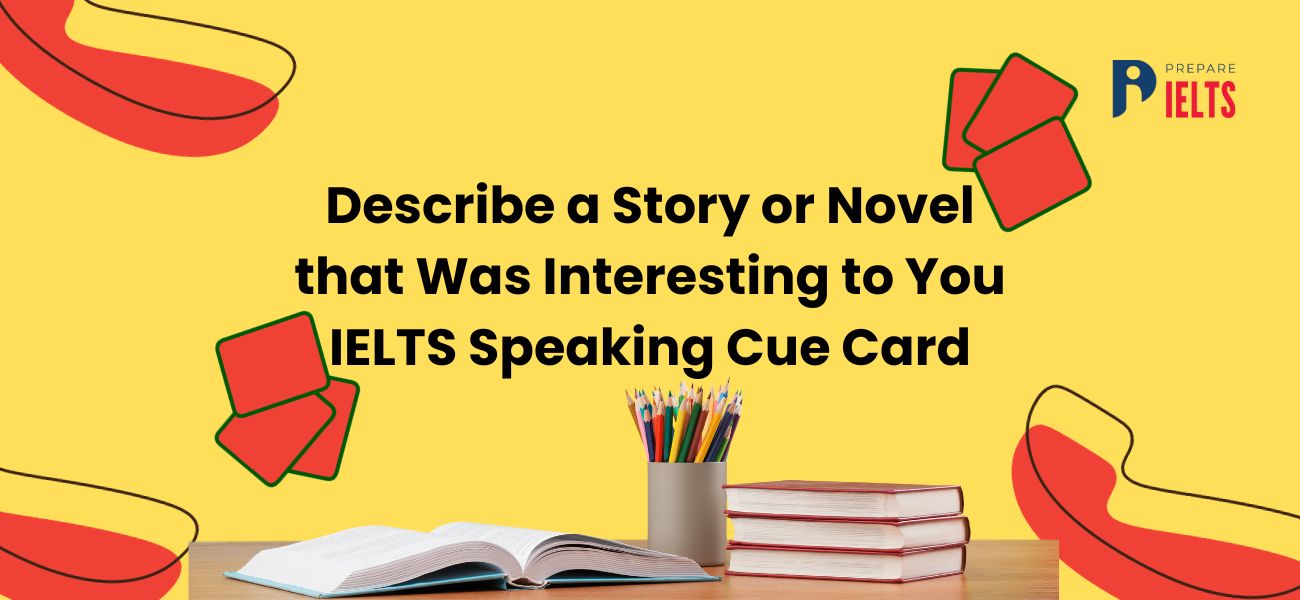
Describe a Story or Novel that was Interesting for you- IELTS Speaking Cue Card
2024-05-02 16:00:42

Describe an Interesting Song IELTS speaking cue card
2024-05-02 16:00:06

Describe a Time You Moved to a New Home/School - IELTS Speaking Cue Card
2024-05-02 15:59:32
_(1)_(1).png)
Describe a Creative Person You Admire - IELTS Speaking Cue Card
2024-05-02 15:58:58
.png)
Describe a Daily Routine that You Enjoy (IELTS Cue Card)
2024-05-02 15:58:13

Describe a park or a garden in your city - IELTS cue card
2024-05-02 15:51:12
.jpg)
Talk about an Article which you have Read about Health IELTS speaking cue card
2024-05-02 15:43:18

Describe a successful person who you once studied or worked with - IELTS cue card
2024-05-01 15:40:54

Describe Your Dream House - IELTS Speaking Cue Card
2024-04-30 15:50:29

IELTS Test Centers in India: Check city-wise IELTS exam Center
2024-04-29 14:53:57

Related Blogs
A php error was encountered.
Severity: Notice
Message: Undefined variable: tips_category
Filename: Blog/blog_detail.php
Line Number: 383
File: /home/prepareieltsexam/public_html/application/views/frontend/Blog/blog_detail.php Line: 383 Function: _error_handler
File: /home/prepareieltsexam/public_html/application/controllers/Tips.php Line: 545 Function: view
File: /home/prepareieltsexam/public_html/index.php Line: 316 Function: require_once
Severity: Warning
Message: Invalid argument supplied for foreach()

Describe a park or a garden in your city - IELTS cue card Since Indian students are writing and speaking in English with Indian accent, with not much exposure to foreign accent, it can be the cause of
- (5.0 /152 votes)

Describe a successful person who you once studied or worked with - IELTS cue card Since Indian students are writing and speaking in English with Indian accent, with not much exposure to foreign accent, it can be the cause of

Describe Your Dream House - IELTS Speaking Cue Card Since Indian students are writing and speaking in English with Indian accent, with not much exposure to foreign accent, it can be the cause of

IELTS Test Centers in India: Check city-wise IELTS exam Center Since Indian students are writing and speaking in English with Indian accent, with not much exposure to foreign accent, it can be the cause of
Registration Now

Share Your Feedback
Free 1 day ielts class with our head of ielts program nick carey.
Register on the spot and get 10% Discount on IELTS fee!
Achieve IELTS Success with Our Comprehensive Classes, proven teaching methodology, and Experienced Teachers.
Affordable Fee Structure
Experienced & Certified Trainers
Interactive Class Activities
Friday, 2nd Feb 2024
11:00 AM - 4:00 PM
Book Review: IELTS Reading Answers
IELTS Academic Test – Passage 12: Book Review reading with answers explanation, location and pdf. This IELTS reading paragraph has been taken from our huge collection of Academic & General Training (GT) Reading practice test PDFs.
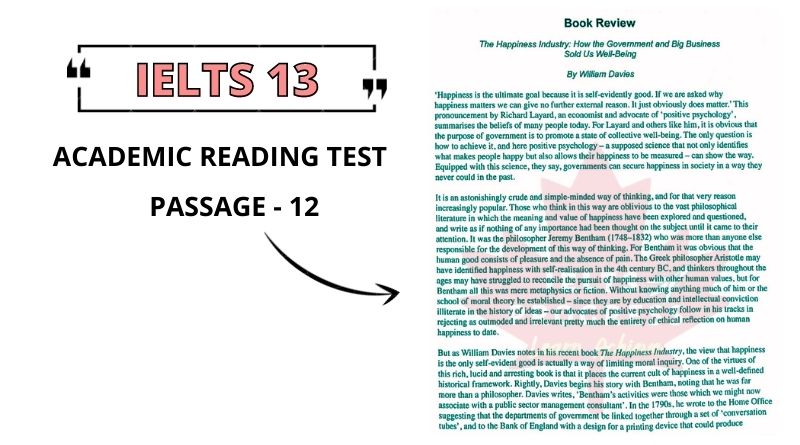
Book Review
The Happiness Industry: How the Government and Big Business Sold Us Well-Being
– By William Davies
‘Happiness is the ultimate goal because it is self-evidently good. If we are asked why happiness matters we can give no further external reason. It just obviously does matter.’ This pronouncement by Richard Layard, an economist and advocate of ‘positive psychology’, summarises the beliefs of many people today. For Layard and others like him, it is obvious that the purpose of government is to promote a state of collective well-being. The only question is how to achieve it, and here positive psychology – a supposed science that not only identifies what makes people happy but also allows their happiness to be measured – can show the way. Equipped with this science, they say, governments can secure happiness in society in a way they never could in the past.
It is an astonishingly crude and simple-minded way of thinking, and for that very reason increasingly popular. Those who think in this way are oblivious to the vast philosophical literature in which the meaning and value of happiness have been explored and questioned, and write as if nothing of any importance had been thought on the subject until it came to their attention. It was the philosopher Jeremy Bentham (1748-1832) who was more than anyone else responsible for the development of this way of thinking. For Bentham it was obvious that the human good consists of pleasure and the absence of pain. The Greek philosopher Aristotle may have identified happiness with self-realisation in the 4th century BC, and thinkers throughout the ages may have struggled to reconcile the pursuit of happiness with other human values, but for Bentham all this was mere metaphysics or fiction. Without knowing anything much of him or the school of moral theory he established – since they are by education and intellectual conviction illiterate in the history of ideas – our advocates of positive psychology follow in his tracks in rejecting as outmoded and irrelevant pretty much the entirety of ethical reflection on human happiness to date.
But as William Davies notes in his recent book The Happiness Industry , the view that happiness is the only self-evident good is actually a way of limiting moral inquiry. One of the virtues of this rich, lucid and arresting book is that it places the current cult of happiness in a well-defined historical framework. Rightly, Davies his story with Bentham, noting that he was far more than a philosopher. Davies writes, ‘Bentham’s activities were those which we might now associate with a public sector management consultant’. In the 1790s, he wrote to the Home Office suggesting that the departments of government be linked together through a set of ‘conversation tubes’, and to the Bank of England with a design for a printing device that could produce unforgeable banknotes. He drew up plans for a ‘frigidarium’ to keep provisions such as meat, fish, fruit and vegetables fresh. His celebrated design for a prison to be known as a ‘Panopticon’, in which prisoners would be kept in solitary confinement while being visible at all times to the guards, was very nearly adopted. (Surprisingly, Davies does not discuss the fact that Bentham meant his Panopticon not just as a model prison but also as an instrument of control that could be applied to schools and factories.)
Bentham was also a pioneer of the ‘science of happiness’. If happiness is to be regarded as a science, it has to be measured, and Bentham suggested two ways in which this might be done. Viewing happiness as a complex of pleasurable sensations, he suggested that it might be quantified by measuring the human pulse rate. Alternatively, money could be used as the standard for quantification: if two different goods have the same price, it can be claimed that they produce the same quantity of pleasure in the consumer. Bentham was more attracted by the latter measure. By associating money so closely to inner experience, Davies writes, Bentham ‘set the stage for the entangling of psychological research and capitalism that would shape the business practices of the twentieth century’.
The Happiness Industry describes how the project of a science of happiness has become integral to capitalism. We learn much that is interesting about how economic problems are being redefined and treated as psychological maladies. In addition, Davies shows how the belief that inner of pleasure and displeasure can be objectively measured has informed management studies and advertising. The tendency of thinkers such as J B Watson, the founder of behaviourism*, was that human beings could be shaped, or manipulated, by policymakers and managers. Watson had no factual basis for his view of human action. When he became president of the American Psychological Association in 1915, he ‘had never even studied a single human being’: his research had been confined to experiments on white rats. Yet Watson’s reductive model is now widely applied, with ‘behaviour change’ becoming the goal of governments: in Britain, a ‘Behaviour Insights Team’ has been established by the government to study how people can be encouraged, at minimum cost to the public purse, to live in what are considered to be socially desirable ways.
Modern industrial societies appear to need the possibility of ever-increasing happiness to motivate them in their labours. But whatever its intellectual pedigree, the idea that governments should be responsible for promoting happiness is always a threat to human freedom.
———————– * ‘behaviourism’: a branch of psychology which is concerned with observable behaviour
Questions 27-29
Choose the correct letter, A , B , C or D .
Write the correct letter in boxes 27-29 on your answer sheet.
27. What is the reviewer’s attitude to advocates of positive psychology?
A ) They are wrong to reject the ideas of Bentham.
B ) They are over-influenced by their study of Bentham’s theories.
C ) They have a fresh new approach to ideas on human happiness.
D ) They are ignorant about the ideas they should be considering.
28. The reviewer refers to the Greek philosopher Aristotle in order to suggest that happiness
A ) may not be just pleasure and the absence of pain.
B ) should not be the main goal of humans.
C ) is not something that should be fought for.
D ) is not just an abstract concept.
29. According to Davies, Bentham’s suggestion for linking the price of goods to happiness was significant because
A ) it was the first successful way of assessing happiness.
B ) it established a connection between work and psychology.
C ) it was the first successful example of psychological research.
D ) it involved consideration of the rights of consumers.
Questions 30-34
Complete the summary using the list of words A-G below.
Write the correct letter, A-G , in boxes 30-34 on your answer sheet.
Jeremy Bentham
Jeremy Bentham was active in other areas besides philosophy. In the 1970s he suggested a type of technology to improve 30 ……………………… for different Government departments. He developed a new way of printing banknotes to increase 31 ………………………… and also designed a method for the 32 …………………………. of food. He also drew up plans for a prison which allowed the 33 …………………………. of prisoners at al times, and believed the same design could be used for other institutions as well. When researching happiness, he investigated possibilities for its 34 ……………………….., and suggested some methods of doing this.
A measurement B security C implementation D profits E observation F communication G preservation
Questions 35-40
Do the following statements agree with the claims of the writer in Reading Passage 3?
In boxes 35-40 on your answer sheet, write
YES if the statement agrees with the claims of the writer
NO if the statement contradicts the claims of the writer
NOT GIVEN if it is impossible to say what the writer thinks about this
35 . One strength of The Happiness Industry is its discussion of the relationship between psychology and economics.
36 . It is more difficult to measure some emotions than others.
37 . Watson’s ideas on behaviourism were supported by research on humans he carried out before 1915.
38 . Watson’s ideas have been most influential on governments outside America.
39 . The need for happiness is linked to industrialisation.
40 . A main aim of government should be to increase the happiness of the population.
________________
1) IELTS 13 READING PASSAGE – HOW BABY TALK BOOST INFANT BRAINS ↗
2) IELTS 13 READING PASSAGE – HARAPPAN CIVILISATION ↗
3) IELTS 13 READING PASSAGE – CUTTY SARK: THE FASTEST SAILING SHIP ↗
4) IELTS 13 READING PASSAGE – SAVING THE SOIL ↗
5) IELTS 13 READING PASSAGE – THE COCONUT PALM ↗
Book Review Answers
Check out Book Review reading answers below with explanations and locations given in the text.
36. NOT GIVEN
38. NOT GIVEN
1 thought on “Book Review: IELTS Reading Answers”
Good afternoon, I’d like a copy of the “Book Review” pdf. And if possible material related to writing book reviews. Thank you so very much, Teacher Gis
Leave a Comment Cancel reply
Save my name, email, and website in this browser for the next time I comment.
IELTS TEST TYPES
✓ IELTS Academic
✓ IELTS General Training
USEFUL LINKS
✓ IELTS Full Form
✓ IELTS Band Score
✓ IELTS Vocabulary
✓ IELTS Grammar
CONNECT WITH US
Pinterest ↗
IELTS® is a registered trademark of The British Council, IDP- IELTS Australia and the University of Cambridge ESOL Examinations (Cambridge ESOL). This site and its owners are not affiliated, approved or endorsed by the University of Cambridge ESOL, the British Council, IELTS Progress Check, and IDP Education Australia. "IELTS Progress Check" is the name of the official IELTS online practice test and is in no way affiliated with this website. To find out more about the official IELTS online practice test please visit https://www.ieltsprogresscheck.com/.
ABOUT US | PRIVACY POLICY | DISCLAIMER | TERMS | CONTACT US
© 2023 IELTSPROGRESS.COM | All Rights Reserved
Study Abroad
Scholarships
Book Review Reading Answers: IELTS Reading Practice Test
Updated on Mar 08, 2024, 06:58
Welcome to this IELTS Academic Reading Practice Test for Book Review Reading Answers. In this test, you can practice your reading skills and test your comprehension abilities through a book review passage.
The test will include a set of three types of questions: multiple-choice, summary completion, and yes/no/not given. You will have 18-20 minutes to answer questions based on the passage and receive general instructions before beginning the test.
On this page

1. Book Review Reading Passage
You should spend approximately 20 minutes answering Questions 1 - 14 based on the Reading Passage below.

2. Book Review Reading Questions and Answers
Discover exciting and informative IELTS reading answers about Book Review.
More for you
Boost your IELTS Reading score
See how to score 8+ in Speaking.
Get proven strategies to ace your IELTS Speaking test.
Book Review Reading Passage
- You will have 60 minutes to complete the entire reading test.
- The test consists of three reading passages with a total of 40 questions.
- The texts may be taken from books, magazines, journals, or newspapers.
- You will receive an answer sheet and should write your answers on it.
- The questions will be in different formats, such as multiple-choice, matching, sentence completion, and summary completion.
- The reading passages will increase in difficulty as you progress through the test.
- You cannot bring any electronic devices, including mobile phones, into the test room.
Book Review
The Happiness Industry: How the Government and Big Business Sold Us Well-Being By William Davies
Paragraph 1
Richard Layard, an economist and advocate of "positive psychology," has summarised the ideologies and faith of various people nowadays in his proclamation that "happiness is the ultimate goal because it is self-evidently good. If we are asked why happiness matters, we can give no further external reason. It is just evident that it matters." For Layard and others like him, the goal of government is to foster an environment of shared prosperity. The only issue is how to attain it, and here, positive psychology—a purported science that not only detects what makes individuals happy but also lets their happiness be quantified—may indicate the way. With the guidance of this study, governments, as per theorists, are currently more capable than ever before of ensuring harmony in society.
Paragraph 2
It is an incredibly primitive and simplistic style of thinking, yet it is rising in popularity due to this. The huge philosophical literature that has studied and challenged the meaning and worth of happiness is neglected by those who embrace this mindset, and they write as if no significant ideas had been studied on the subject prior to their realisation. The emergence of this method of thinking was due in large part to the work of philosopher Jeremy Bentham (1748–1832). For Bentham, it was apparent that happiness and the lack of misery constitute the human good. In the 4th century BC, the Greek philosopher Aristotle connected happiness with self-realisation, and scholars throughout the years attempted to combine the goal of happiness with other human virtues, although all of this was just metaphysics or fiction to Bentham. Modern proponents of positive psychology follow in his footsteps, condemning as obsolete and unnecessary almost the entire ethical reflection on human pleasure to date, despite knowing nothing about him or the school of moral theory he founded—as they are ignorant in the history of ideas due to education and philosophical conviction.
Paragraph 3
However, as William Davies points out in his new book, The Happiness Industry, assuming that happiness is the prime self-evident good restricts moral analysis. This rich, clear, and compelling book's ability to contextualise the modern cult of happiness inside a precisely defined historical context is one of its many merits. Davies was correct in his assessment of Bentham, recognising that he was significantly more than just a philosopher. According to Davies, Bentham engaged in activities that modern-day management consultants serving the public sector may partake in. In the 1790s, he addressed letters to the Bank of England with a model for a printing machine that could generate unforgeable banknotes and to the Home Office with a suggestion that the government's various departments be interlinked by a system of "conversation tubes." To preserve food like meat, fish, fruit, and vegetables, he designed a "frigidarium." His renowned plan for a jail known as a "Panopticon," in which inmates would be confined in solitary while always being monitored by the guards, came extremely close to being implemented. (Interestingly, Davies does not address the fact that Bentham envisioned his Panopticon to serve as a model for both a jail and a control mechanism that could be utilised in both schools and factories.)
Paragraph 4
Bentham also established the "science of happiness." If happiness is to be considered a science, then it must be quantified. Bentham presented two methods for measuring happiness. He proposed that pleasure might be measured by taking the average heart rate of a person and seeing happiness as a complex of pleasant emotions. As an alternative, the value of money might be used as the criterion for quantification. If the cost of two distinct products is the same, it can be stated that both give the customer the same amount of happiness. The latter attribute grabbed Bentham's eye more. According to Davies, Bentham "established the foundation for the combination of psychological study and capitalism, which would influence the activities of the twentieth century" by associating money so intimately with inner experience.
Paragraph 5
In the book The Happiness Industry, it is explained how the pursuit of a science of pleasure has merged with business. We learn a lot of interesting information on the redefining and treatment of economic concerns as psychological conditions. Additionally, Davies demonstrates how management studies and advertising have been influenced by the idea that inner joy and dissatisfaction can be assessed objectively. The inclination of philosophers like J. B. Watson, the pioneer of behaviourism*, was that managers and politicians could mould or influence people. Watson's theories on human nature were not backed by any facts. He had only conducted studies on white rats when he was appointed president of the American Psychological Association in 1915. He had "never really examined a fellow human being." The government in Britain has founded a "Behaviour Insights Team" to research how individuals might be motivated to live in ways that are thought to be socially desirable while incurring the lowest expenses to the public purse. However, Watson's reductive model has already been extensively adopted.
Paragraph 6
To keep people motivated in their work, modern industrial nations seem to require the potential for ever-increasing happiness. But regardless of its conceptual heritage, the theory that authorities ought to be in charge of fostering happiness is always hazardous to people's freedom.
* behaviourism: a field of psychology in which the focus is on observable behaviour
Book Review Reading Questions and Answers
Questions and answers 1-3.
- Choose the correct letter A, B, C, or D.
- Write the correct letter in the boxes 1-3 on your answer sheet
1. The critic mentions the Greek philosopher Aristotle to state that happiness ______.
- is not something that should be fought for.
- may not be just pleasure and the absence of pain.
- is not just an abstract concept.
- should not be the main goal of humans.
2. In Davies' opinion, the suggestion that was given by Bentham’s to link the prices to happiness was remarkable because _____.
- It established a connection between work and psychology.
- It involved consideration of the rights of consumers.
- It was the first successful way of assessing happiness.
- It was the first successful example of psychological research.
3. What is the reviewer’s opinion on the proponents of positive psychology?
- They have a fresh new approach to ideas on human happiness.
- They are wrong to reject the ideas of Bentham.
- They are ignorant about the ideas they should be considering.
- They are over-influenced by their study of Bentham’s theories.
Book Review Reading Answers with Explanations
Type of questions: Multiple Choice Questions (one answer)
This is the typical MCQ type. You just need to select one answer out of the 4 options.
- Multiple Choice Questions (one answer)
- You just need to select one answer out of the 4 options.
How to best answer the questions
- Skim through the questions and identify the keywords
- Use the elimination method and recognise options that include inaccurate or false information as per the given passage
- Match each option with the passage and choose an answer most accurately supported by the information in the passage.
- Cross-check your answers and finalise them
From paragraph 2: ‘In the 4th century BC, the Greek philosopher Aristotle connected happiness with self-realisation, and scholars throughout the years attempted to combine the goal of happiness with other human virtues, although all of this was just metaphysics or fiction to Bentham.’
Explanation:
According to the paragraph, Aristotle and Bentham had different views on happiness. Aristotle believed that happiness couldn't be reduced to just pleasure and the absence of misery, while Bentham thought that happiness was simply the absence of pain and the presence of pleasure. It's fascinating to see how different philosophers have defined happiness throughout history.
From paragraph 4: ‘If the cost of two distinct products is the same, it can be stated that both give the customer the same amount of happiness.’
Explanation
As per the reference, Davies describes Bentham's theory that happiness should be quantified and connected to business and psychology. Bentham believed that if two items had the same price, the happiness received from both would be equal. Bentham's ideas paved the way for modern-day management consultants, as he engaged in activities similar to theirs, such as designing a system of "conversation tubes" and a printing machine for unforgeable banknotes.
From paragraph 2: ‘It is an incredibly primitive and simplistic style of thinking, yet it is rising in popularity due to this.’
As explained by the paragraph, the idea of happiness had been very simple and surprisingly unpleasant, yet it was quite famous. Moreover, it is argued that these advocates are unaware of the real meaning and value of happiness explained by research before their acceptance.
Questions and Answers 4-8
- Complete the summary using the list of words A-G below.
- Write the correct letter, A-G , in the boxes 4-8 on your answer sheet.
Jeremy Bentham
Jeremy Bentham was active in other areas besides philosophy. In the 1970s he suggested a type of technology to improve 4…………. for different Government departments. He developed a new way of printing banknotes to increase 5…………. and also designed a method for the 6……….. of food. He also drew up plans for a prison which allowed the 7…………. of prisoners at all times and believed the same design could be used for other institutions as well. When researching happiness, he investigated possibilities for its 8………… and suggested some methods of doing this.
- communication
- preservation
- implementation
- measurement
- observation
- Summary Completion (selecting from a list of words or phrases)
- Go through the summary, focusing on the missing information
- Identify keywords that can help you find answers
- Use a method of elimination while going through the list of words/phrases
- Review and finalise your answers
From paragraph 3: ‘ In the 1790s, he addressed letters to the Bank of England with a model for a printing machine that could generate unforgeable banknotes and to the Home Office with a suggestion that the government's various departments be interlinked by a system of "conversation tubes."’
According to the passage it is stated that Bentham suggested a system of "conversation tubes" to interlink the government's various departments and enhance communication between them. This was one of his many innovative ideas that aimed to improve the efficiency of government operations.
From paragraph 3: ‘In the 1790s, he addressed letters to the Bank of England with a model for a printing machine that could generate unforgeable banknotes and to the Home Office with a suggestion that the government's various departments be interlinked by a system of "conversation tubes."’
As per the passage, Bentham proposed a design for a printing machine that could generate unforgeable banknotes for the Bank of England, which would increase security as the notes could not be duplicated.
From paragraph 3: ‘His renowned plan for a jail known as a "Panopticon," in which inmates would be confined in solitary while always being monitored by the guards, came extremely close to being implemented.’
Bentham's celebrated design for a prison, known as the 'Panopticon,' allowed for constant surveillance of prisoners. The design ensured that inmates were confined in cells that could be viewed from all sides by the jailer, making it an innovative and effective approach to prison management.
From paragraph 4: ‘Bentham also established the "science of happiness." If happiness is to be considered a science, then it must be quantified.’
Bentham is credited with establishing the "science of happiness," he believed that if happiness was considered a science, it must be quantifiable. This shows his vision and forward-thinking approach to happiness as a measurable concept.
Also Read: IELTS Reading Tips & Tricks
Questions and Answers 9-14
- YES if the statement agrees with the information
- NO if the statement contradicts the information
- NOT GIVEN if there is no information on this
9. Industrialisation is connected to the requirement of happiness.
10. Prior to 1915, Watson conducted study on people that supported his theories of behaviourism.
11. Government’s main objective should be to increase the population’s happiness.
12. The Happiness Industry’s strength is the discussion of the connection between psychology and commerce.
13. The theories by Watson had immense influence on the governments outside America.
14. Certain emotions are more challenging to measure than others.
Book Review Reading Answers with E xplanations
- Identifying Information or True/False/Not Given
How to best answer the question
- Read the given question statements carefully and note down the keywords
- With the help of the keywords, locate them in the passage, which will help you decide whether the given statement is yes or no .
- Your answer will not be given if the information is not in the passage .
From paragraph 6: ‘To keep people motivated in their work, modern industrial nations seem to require the potential for ever-increasing happiness.’
It is mentioned in the book review that modern industrial nations require the potential for ever-increasing happiness to keep people motivated in their work. The need for happiness is also linked to the corporate world as it is necessary to motivate the workers. Therefore, the answer is yes .
From paragraph 5: ‘He had only conducted studies on white rats when he was appointed president of the American Psychological Association in 1915.’
As per the given statement, Watson's theories on human nature lacked factual evidence. When he was appointed as the president of the American Psychological Association in 1915, he had only conducted studies on white rats. Therefore, the answer is no .
From paragraph 6: ‘But regardless of its conceptual heritage, the theory that authorities ought to be in charge of fostering happiness is always hazardous to people's freedom.’
The answer is no because the author of this text is advocating against the idea of the government being responsible for promoting happiness among its citizens. The author believes that this approach could potentially harm people's freedom and, therefore, should be avoided. The author seems to suggest that this idea is risky and should not be pursued.
From paragraph 5: ‘In the book The Happiness Industry, it is explained how the pursuit of a science of pleasure has merged with business.’
The author agrees with the idea presented in the book "The Happiness Industry" that the pursuit of science to increase pleasure and happiness has merged with business, and economic issues have been redefined as psychological problems and treated as such. Therefore, the answer is yes .
From paragraphs 1 to 6: ‘Richard Layard, an economist and advocate…….. happiness is always hazardous to people's freedom.’
The answer is not given because there is no information in the passage that theories of Watson had an influence outside of America. Instead, his ideas regarding behaviour change were applied by the American government. So, the concept of behaviour change remains an important consideration in many different fields today.
The passage does not provide specific information on the measurement of a variety of emotions or how they should be measured. Though there is little information regarding the measurement of emotions in paragraph 5, it does not go into detail on the methodology or tools used for this measurement. Hence, the answer is not given .
IELTS Reading Practice Test
IELTS Speaking Practice Test
IELTS Practice Test
IELTS Writing Practice Test
IELTS Listening Practice Test
IELTS Important Information
IELTS Exam Date
IELTS Exam Fee
IELTS Modules
IELTS Test Centres
IELTS Results
Types of IELTS
IELTS Pattern
IELTS Exam Eligibilty
IELTS Slot Booking
IELTS Band Score
IELTS Registration
IELTS Books
IELTS Preparation
IELTS Accepting Countries
Study In USA
Study In Canada
Study In UK
Study In Australia
Study In Ireland
IELTS Accepting Universities
Massachusetts Institute Of Technology
The University Of British Columbia
Harvard University
University Of Toronto
Conestoga College
University Of East London
Stanford University
University Of Alberta
Coventry University
New York University
Read More about IELTS Practice Test
IELTS Speaking Cue Card
IELTS Speaking Part 1
IELTS Writing Task 1
IELTS Writing Task 2
Task 1 Pie Chart
Task 1 Table Chart
Task 1 Bar Graph
Task 1 Line Graph
Task 1 Diagram
Top Reading Samples with Answers
The Origins of Laughter Reading Answers
The Innovation of Grocery Stores Reading Answers
All About the Otter Reading Answers
The Triune Brain Reading Answers
Saving the Soil Reading Answers
Trans Fatty Acids Reading Answers
Book Review Reading Answers
Tea Times Reading Answers
Animal Minds Parrot Alex Reading Answers
What's so Funny Reading Answers:
Glaciers Reading Answers
Stepwells Reading Answers
IELTS Test Centre and Dates in India
IELTS Test Centre and Dates in Hyderabad
IELTS Test Centre and Dates in Bangalore
IELTS Test Centre and Dates in Chennai
IELTS Test Centre and Dates in Amritsar
IELTS Centre and Dates in Ludhiana
IELTS Test Centre and Dates in Mumbai
IELTS Test Centres and Dates in Ahmedabad
IELTS Centre and Dates in Delhi
IELTS Test Centres and Dates in Chandigarh
IELTS Center and Dates in Pune
Related Articles

The Development of Travel Under the Ocean Reading Answers: IELTS Reading Practice Test
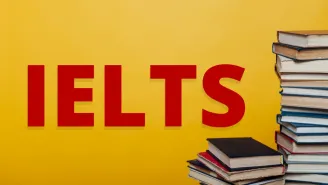
Trans Fatty Acids Reading Answers: IELTS Reading Practice

All About the Otter Reading Answers: IELTS Reading Practice
Q. What are some common mistakes to avoid in the IELTS Reading test?
A. Common mistakes to avoid in the IELTS Reading test are spending too much time on a single question, not reading instructions carefully, focusing on details, not skimming the passage first, not using context clues, not checking answers, and trying to memorize the passage.
Q. How can I improve my reading speed for the IELTS Reading test?
A. To improve your reading speed for the IELTS Reading test, practice regularly, skim and scan, focus on main ideas, predict answers, increase vocabulary, read regularly, use a timer, take breaks, and avoid reading when tired.
Q. What are some effective reading strategies for the IELTS Reading test?
A. Effective reading strategies for the IELTS Reading test include skimming and scanning, previewing questions, highlighting keywords, reading actively, managing time, staying focused, using context clues, avoiding overthinking, and checking answers.
Q. Can I use a highlighter or take notes during the IELTS Reading test?
A. For the paper-based IELTS Reading test, you can use a pencil to take notes and underline important information in the passage. You are not allowed to use a highlighter, pen or any other type of writing instrument. For the computer-based IELTS Reading test, you can use the highlighter and note-taking feature on the computer to take notes and highlight important information.
Q. How can I manage my time effectively during the IELTS Reading test?
A. To manage your time effectively during the IELTS Reading test, pace yourself, preview the questions, skim and scan, manage difficult questions, avoid overthinking, and check your answers. Remember to take breaks during the test and avoid rushing through the questions. Practice these strategies before the test to get a hold of managing your time accordingly.
Q. What are some good sources for practice materials for the IELTS Reading test?
A. Good sources for IELTS Reading practice materials include official IELTS practice materials, Cambridge IELTS books, online courses, IELTS preparation books, and IELTS preparation websites. Practice regularly with materials that suit your level.
Q. What are the criteria for determining the IELTS Reading score?
A. The IELTS Reading test is scored on a scale of 0-9 based on four criteria: Task Achievement, Coherence and Cohesion, Lexical Resource, and Grammatical Range and Accuracy. Each criterion is given a band score from 0-9, and the scores are averaged to give an overall score. The overall score is then rounded up or down to the nearest 0.5.
Q. Are spelling mistakes penalised for the IELTS Reading test?
A. Spelling mistakes are penalised in the IELTS Reading test. If you spell a word incorrectly, you will lose marks for that question, even if your answer is otherwise correct. Therefore, it is important to double-check your spelling before moving on to the next question. If you are unsure of the spelling of a word, try to write it in a way that looks correct or use synonyms to avoid spelling errors.
Q. Is grammar necessary for the IELTS Reading test?
A. While the IELTS Reading test primarily assesses your reading comprehension skills, grammar is still an important aspect of the test. The test assesses your ability to understand and use grammar structures in context, as well as your ability to communicate effectively in writing. In addition, the Grammatical Range and Accuracy criterion is one of the four criteria used to determine your overall score in the IELTS Reading test.
Q. Can I retake the IELTS Reading test alone?
A. No, you cannot retake the IELTS Reading test alone. The IELTS test assesses all four language skills (listening, reading, writing, and speaking), and you must take all four tests together. If you want to retake the Reading test, you will need to retake the entire IELTS test. It is important to note that your scores are valid for two years from the date of your test, and you cannot choose to retake only one section of the test to improve your score.
Q. What are good tips/practices for IELTS Reading preparation?
A. Good tips for IELTS Reading preparation include familiarising yourself with the test format, reading widely, practicing regularly, using a timer, building vocabulary, taking notes, reviewing grammar rules, focusing on main ideas, and double-checking your answers.

‘Book Review’- Reading Answer Explanation- CAM- 13

Here are explanations of the Questions of passage named ‘Book Review’, which is from the Cambridge 13 book. The Questions that have been asked are ‘MCQs’, Blanks and Yes/No/Not Given. You will find the locations of the Reading Answers, Keywords( highlighted and underlined ) and justifications.
READING PASSAGE 3: Book Review
Questions 27-29
Choose the correct letter, A , B , C or D .
Write the correct letter in boxes 27-29 on your answer sheet.
27 What is the reviewer’s attitude to advocates of positive psychology?
A They are wrong to reject the ideas of Bentham.
B They are over-influenced by their study of Bentham’s theories.
C They have a fresh new approach to ideas on human happiness.
D They are ignorant about the ideas they should be considering.
Location: 2 nd paragraph
Explanation: Though the main keyword ‘positive psychology’ is there in the first line of the paragraph. But the reference of attitudes to advocates is there in the second paragraph. ‘and write as if nothing of any importance had been thought on the subject until it came to their attention.’ and write as if nothing of any importance had been thought on the subject until it came to their attention. Here, ‘nothing of any importance’ means they are ignorant.
28 The reviewer refers to the Greek philosopher Aristotle in order to suggest that happiness
A may not be just pleasure and the absence of pain.
B should not be the main goal of humans.
C is not something that should be fought for.
D is not just an abstract concept.
Explanation: The main keyword ‘Greek philosopher’’ helps to locate the answer in the 5 th line of the paragraph. ‘For Bentham it was obvious that the human good consists of pleasure and the absence of pain. The Greek philosopher Aristotle may have identified happiness with self-realisation…’Here, Aristotle believe that happiness may be identified by self-realisation. Thus, this makes an answer very clear.
29 According to Davies, Bentham’s suggestion for linking the price of goods to happiness was significant because
A it was the first successful way of assessing happiness.
B it established a connection between work and psychology.
C it was the first successful example of psychological research.
D it involved consideration of the rights of consumers.
Location: 5 th paragraph
Explanation: The main keyword ‘Davies, Bentham’s’ helps to locate the answer in the last line of the paragraph. ‘. By associating money so closely to inner experience, Davies writes, Bentham ‘set the stage for the entangling of psychological research and capitalism that would shape the business practices of the twentieth century’. Here, ‘money’ was associated with ‘work’. Thus, this established a connection between work and energy.
Questions 30-34
Complete the summary using the list of words A-G below.
Write the correct letter, A-G , in boxes 30-34 on your answer sheet.
Jeremy Bentham
Jeremy Bentham was active in other areas besides philosophy. In the 1790s he suggested a type of technology to improve 30 ……………………… for different Government departments.
Location: 3 rd paragraph
Explanation: The main keyword ‘1790s’ helps to locate the answer in the last line of the paragraph. ‘. In the 1790s, he wrote to the Home Office suggesting that the departments of government be linked together through a set of ‘conversation tubes…’Here, ‘linked together’ means communication was set through conversation tubes.
He developed a new way of printing banknotes to increase 31 …………………………
Explanation: The main keyword ‘banknotes’ helps to locate the answer in the middle line of the paragraph. ‘to the Bank of England with a design for a printing device that could produce unforgeable banknotes…’Thus, the answer is ‘security’
and also designed a method for the 32 …………………………. of food.
Explanation: The location of the answer is in the last third line of the paragraph. ‘He drew up plans for a ‘frigidarium’ to keep provisions such as meat, fish, fruit and vegetables fresh…’Here, this line indicates that this method was designed for preservation of food. Thus, the answer is G.
He also drew up plans for a prison which allowed the 33 …………………………. of prisoners at all times, and believed the same design could be used for other institutions as well.
Explanation: The answer to this question is in the second last line of the paragraph. ‘His celebrated design for a prison to be known as a ‘Panopticon’, in which prisoners would be kept in solitary confinement while being visible at all times to the guards…’Here, ‘while being visible’ means ‘observation’ Thus, the answer is E.
When researching happiness, he investigated possibilities for its 34 ……………………….., and suggested some methods of doing this.
Location: 4 th paragraph
Explanation: The location of the answer is in the second line of the paragraph. ‘. If happiness is to be regarded as a science, it has to be measured, and Bentham suggested two ways…’Thus, some methods were suggested for measurement.
A measurement B security C implementation D profits E observation F communication G preservation
Questions 35-40
Do the following statements agree with the claims of the writer in Reading Passage 3?
In boxes 35-40 on your answer sheet, write
YES if the statement agrees with the claims of the writer
NO if the statement contradicts the claims of the writer
NOT GIVEN if it is impossible to say what the writer thinks about this
35 One strength of The Happiness Industry is its discussion of the relationship between psychology and economics.
Explanation: The main keyword ‘The Happiness Industry’ helps to locate the answer in the second line of the paragraph. ‘We learn much that is interesting about how economic problems are being redefined and treated as psychological maladies’ .Thus, the question statement is same as the passage statement.
Answer: Yes
36 It is more difficult to measure some emotions than others.
Explanation: The location of the answer is in the third line of the paragraph. ‘In addition, Davies shows how the belief that inner of pleasure and displeasure can be objectively…’Here, pleasure and displeasure are emotions. But there is no information related to difficulty of measuring emotions. Thus, no information available.
Answer: Not Given
37 Watson’s ideas on behaviourism were supported by research on humans he carried out before 1915.
Explanation: The main keyword ‘1915’ helps to locate the answer in the seventh line of the paragraph. ‘in 1915, he ‘had never even studied a single human being’: his research had been confined to experiments on white rats…’Here, the writer says, his experiments were on rats not on humans. Hence, the answer is clear.
38 Watson’s ideas have been most influential on governments outside America.
Explanation: The main keyword ‘Watson ideas’ of the question is in the second last line of the paragraph. But there is no information about the impact of Watson ideas on government outside the USA. Thus, no information available.
39 The need for happiness is linked to industrialization.
Location: 6 th paragraph
Explanation: The location of the answer is in the first line of the paragraph. ‘Modern industrial societies appear to need the possibility of ever-increasing happiness to motivate them in their labours…’Thus, this statement is same as the passage statement.
40 A main aim of government should be to increase the happiness of the population.
Explanation: The answer to this question is in the last line of the paragraph. ‘the idea that governments should be responsible for promoting happiness is always a threat to human freedom…’Here, this was just an idea not an aim.Hence, the answer is No.
‘Saving the Soil’- Reading Answer Explanation – CAM- 13
My Journey of Getting 6.5 Band in IELTS!! Books and Study material I followed | Daljit’s Story. Click here
Leave a Reply Cancel reply
Your email address will not be published. Required fields are marked *
Save my name, email, and website in this browser for the next time I comment.
You cannot copy content of this page

- Getting Started
- Start a Book Club
- Book Club Ideas/Help▼
- Our Featured Clubs ▼
- Popular Books
- Book Reviews
- Reading Guides
- Blog Home ▼
- Find a Recipe
- About LitCourse
- Course Catalog
Find a Reading Guide
LitLovers © 2024
A Book Review – Reading Questions and Answers
The Blog post contains the following IELTS Reading Questions :
- IELTS reading Summary Completion
- IELTS reading Yes/No/Not Given
Stay informed and prepared for success – Explore our comprehensive Reading Test Info page to get valuable insights, exam format details, and expert tips for mastering the IELTS Reading section .
A BOOK REVIEW – DOG WILL HAVE HIS DAY BY FRED VARGAS (TRANSLATED BY SIAN REYNOLDS)
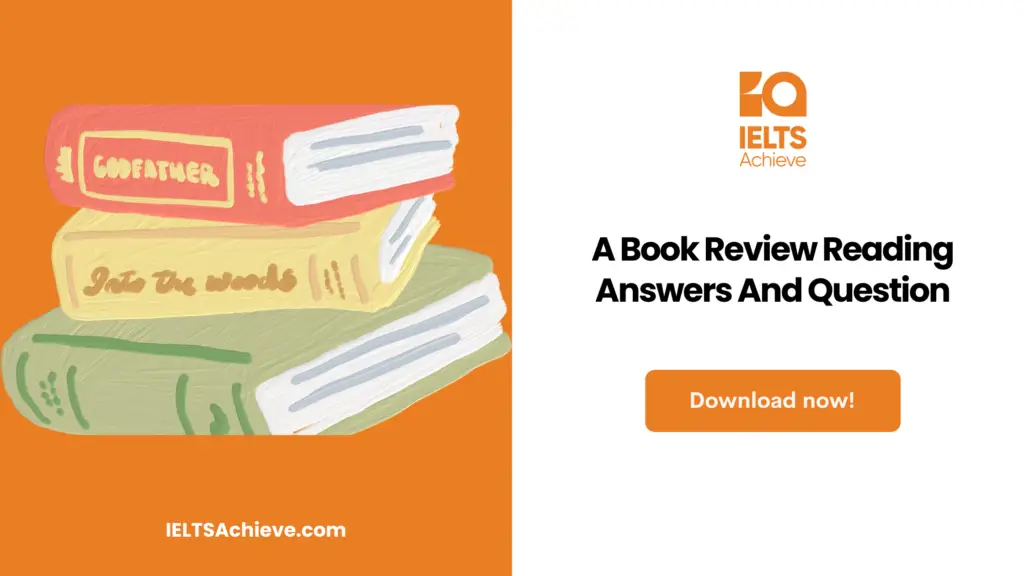
This is another crime thriller from the prize-winning novelist Fred Vargas. Despite the misleading first name and Spanish surname, the author is actually a French woman – Frédérique Audoin-Rouzeau. She adopted her nom de plume from the Ava Gardner character, the Spanish dancer Maria Vargas, in the 1954 film The Barefoot Contessa . Although a writer of crime fiction, Frederique Audoin-Rouzeau is primarily a medieval historian and archaeologist.
Her detective books are immensely popular: over 10 million copies have been sold worldwide and they have been translated into 45 languages. She is a little mystified by her success – after all, it is just a hobby – and finds it quite amusing. As an archaeologist specialising in epidemiology, she produced the definitive study on the transmission of the bubonic plague – a book that she says “after seven years of intensive work trying to find the real vector of the plague” sold only a thousand copies. It is even more paradoxical to learn that she wrote each of her novels in three weeks flat, during her annual summer holidays. Even when she took a break from archaeology to work full-time on her fiction, the first draft was still finished within the same time frame. She uses the ensuing months to polish and tidy the prose.
Perhaps by virtue of Vargas’ archaeological background, Dog Will Have His Day starts with a bone. It turns out to be the top joint of a woman’s big toe, found by chance in Paris by Louis Kehlweiler, a former special investigator for the Ministry of Justice. He presents his findings to the local police, who declines to do anything about it. However, Louis, convinced that a murder has taken place, decides to focus on finding the body to which the toe belongs.
Most of Vargas’ characters are eccentrics in some way and Louis is no exception. He carries a toad named Bufo around in his pocket and consults it on matters of importance, although Louis says: “You have to keep it simple with Bufo, just basic ideas … He can’t cope with anything else. Sometimes I try a bit harder, a bit of philosophy even, to improve his mind … He was much more stupid when I first got him.” Louis recruits the assistance of Marc Vandoosler, one of the ‘evangelists’ of a previous novel The Three Evangelists . The evangelists, actually unemployed historians, share a rundown house and Marc is the medieval researcher among them. Later, another of the evangelists, Mathias, the hunter-gatherer (a prehistoric specialist), joins the undertaking.
As the bone fragment had obviously passed through a dog’s digestive system, Louis’ first mission is to track down the dog in question. Ringo, a pit bull, is eventually identified as the culprit and his owner is tracked to a tiny Breton fishing village. There, Marc and Louis establish that the corpse of an old woman missing her big toe had been discovered on the beach a few days earlier. The investigation takes in some interesting characters, including a collector of antique typewriters. Although initially suspecting just one murder, Louis, with the help of Marc and Mathias, manages to solve three homicides and unmask a would-be mayoral candidate who is in fact wanted for crimes against humanity dating from the Second World War.
As an aficionado of crime fiction, I find Vargas’ prose far from conventional. It is original, enthralling and witty, occasionally whimsical and surreal, but always with a delightful simplicity. The main characters have their little catchphrases such as “I could do with a beer” (Louis) which makes them endearingly human. She has a cast of quirky provincial characters expertly portrayed; far removed from the darkly humorous, brutally violent, hard-edged Scandinavian realism which is so widely admired these days. Vargas definitely swims against the tide of realism – there is a lack of elaborate description – no detailed depictions of the meals eaten, clothes worn, music listened to or cars driven. This is enormously refreshing: frankly, how essential is it to know the make of a vehicle or the brand of beer? Unless, of course, it is inextricably linked to the unravelling of the plot.
Comparatively speaking, the plot of this book appears at first to be a little on the light side although her bizarre characters and inventiveness keep the reader well entertained. However, the story suddenly becomes convoluted towards the end and the denouement rapidly ensues, leaving the reader feeling short-changed. It is not as ingenious or inspired as The Three Evangelists – one of her finest novels and a hard act to follow – but the well-judged inclusion of Marc leaves the reader wanting to see more of the other two evangelists. Despite some shortcomings, it is still a brilliant read and I remain a steadfast fan.
Unlock your full potential in the IELTS Reading section – Visit our IELTS Reading Practice Question Answer page now!
Recommended Questions:
Renewable Energy IELTS Reading Question with Answer
Questions 28-36
Complete the summary below. Choose NO MORE THAN THREE WORDS AND/OR A NUMBER from the text for each answer. Write your answers in boxes 28–36 on your answer sheet.
Fred Vargas is the 28 ……………. of Frédérique Audoin-Rouzeau. She has two main professions, and writing crime novels is her 29 ……………. . She thinks it is funny that her fiction is so popular, in contrast to her academic writing, which does not sell so well. It took many years of research before she published her book about the 30 ……………. whereas she can write the first draft of a detective story in just 31 ……………., although it takes quite a bit longer to correct and change the 32 ……………. . Dog Will Have His Day is a story about a piece of human bone, and Louis Kehlweiler’s attempts to solve a murder mystery. Kehlweller is a typical example of Vargas’ heroes, many of whom are 33 …………….; in his case, he has a pet toad who he chats to regularly. He enlists the help of Marc and Mathias, both 34 ……………. who had featured as evangelists in an earlier Vargas novel. They end up in a small 35 ……………. where they learn that a woman’s body had recently been found on the beach. In the course of their investigation, they uncover more murders and 36 ……………. a war criminal.
Boost your performance in Summary, Notes, Table, and Flowchart Completion tasks . Click here to explore our detailed guide and learn how to effectively complete summaries, notes, tables, and flowcharts in the IELTS Reading section.
Questions 37-40
Do the following statements agree with the views of the writer in SECTION 3?
In boxes 37–40 on your answer sheet, write
YES if the statement agrees with the views of the writer NO if the statement contradicts the views of the writer NOT GIVEN if it is impossible to say what the writer thinks about this
37. Vargas’ style of writing is typical of crime fiction. 38. The style has much in common with Scandinavian crime novels. 39. Detailed descriptions are only useful to the reader when they develop the storyline. 40. ‘The Three Evangelists’ is Vargas’ best selling novel.
Want to excel in identifying the writer’s views and claims? Click here to explore our in-depth guide on how to accurately determine Yes, No, or Not Given in the IELTS Reading section .
28. nom de plume 29. hobby 30. (bubonic) plague 31. three weeks/3 weeks 32. prose 33. eccentrics 34. (unemployed) historians 35. (Breton) fishing village 36. unmask 37. NO 38. NO 39. YES 40. NOT GIVEN
We hope you found this post useful in helping you to study for the IELTS Test . If you have any questions please let us know in the comments below or on the Facebook page.
The best way to keep up to date with posts like this is to like us on Facebook , then follow us on Instagram and Pinterest . If you need help preparing for the IELTS Test, join the IELTS Achieve Academy and see how we can assist you to achieve your desired band score. We offer an essay correction service, mock exams and online courses.
Related Posts

Implementing the Cycle of Success – A Case Study Reading Questions and Answers
The Blog post contains the following IELTS Reading Questions: IELTS Reading Passage – Implementing the…

Internal Market: Selling The Inside Reading Questions and Answers
The Blog post contains the following IELTS Reading Questions: IELTS Reading Passage – Internal Market:…
Welcome Guest!
- IELTS Listening
- IELTS Reading
- IELTS Writing
- IELTS Writing Task 1
- IELTS Writing Task 2
- IELTS Speaking
- IELTS Speaking Part 1
- IELTS Speaking Part 2
- IELTS Speaking Part 3
- IELTS Practice Tests
- IELTS Listening Practice Tests
- IELTS Reading Practice Tests
- IELTS Writing Practice Tests
- IELTS Speaking Practice Tests
- All Courses
- IELTS Online Classes
- OET Online Classes
- PTE Online Classes
- CELPIP Online Classes
- Free Live Classes
- Australia PR
- Germany Job Seeker Visa
- Austria Job Seeker Visa
- Sweden Job Seeker Visa
- Study Abroad
- Student Testimonials
- Our Trainers
- IELTS Webinar
- Immigration Webinar
IELTS Academic Reading ‘A Book Review’ Answers
Updated On Oct 05, 2023

Share on Whatsapp
Share on Email
Share on Linkedin
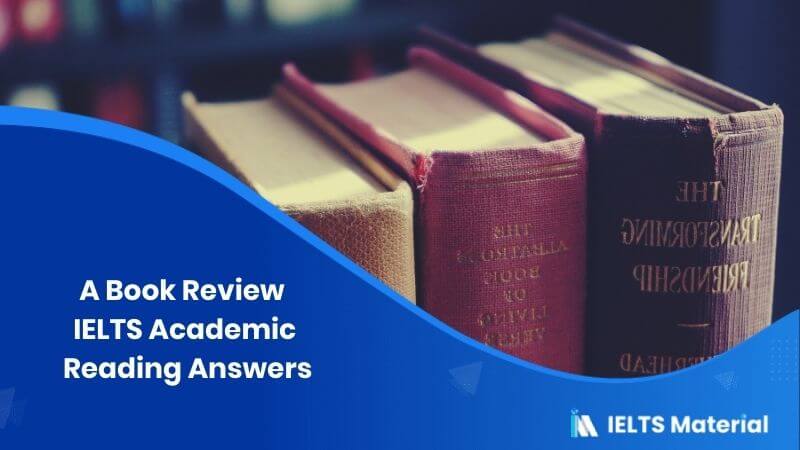
Recent IELTS Reading Test with Answers - Free PDF
The Academic passage ‘A Book Review’ is a reading passage that appeared in an IELTS Test.
Since questions get repeated in the IELTS exam, these passages are ideal for practice. If you want more practice, try taking an IELTS reading practice test.
A Book Review
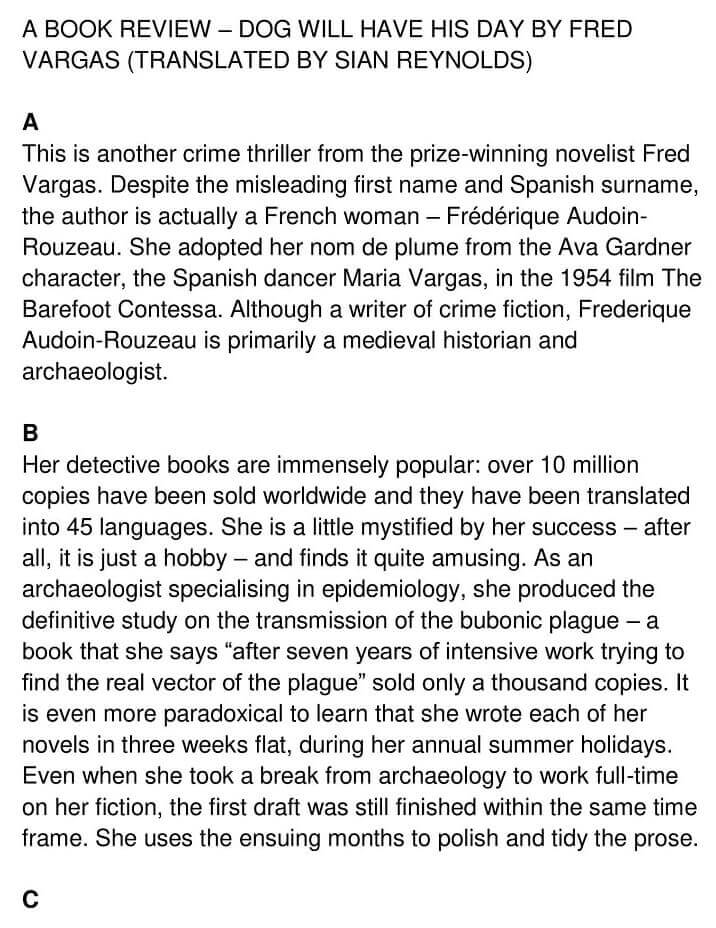
The answers with explanations are given below
Unlock Answers
Check More IELTS Reading Answers
Also check :
- True False Not Given IELTS Reading
- IELTS Reading recent actual test
- Tips to Improve IELTS Reading Skills
- IELTS Academic Reading test papers with answers pdf
Practice IELTS Reading based on question types

Start Preparing for IELTS: Get Your 10-Day Study Plan Today!
Courtney Miller
Courtney is one of our star content writers as she plays multiple roles. She is a phenomenal researcher and provides extensive articles to students. She is also an IELTS Trainer and an extremely good content writer. Courtney completed her English Masters at Kings College London, and has been a part of our team for more than 3 years. She has worked with the British Council and knows the tricks and tips of IELTS.
Explore other Reading Topics
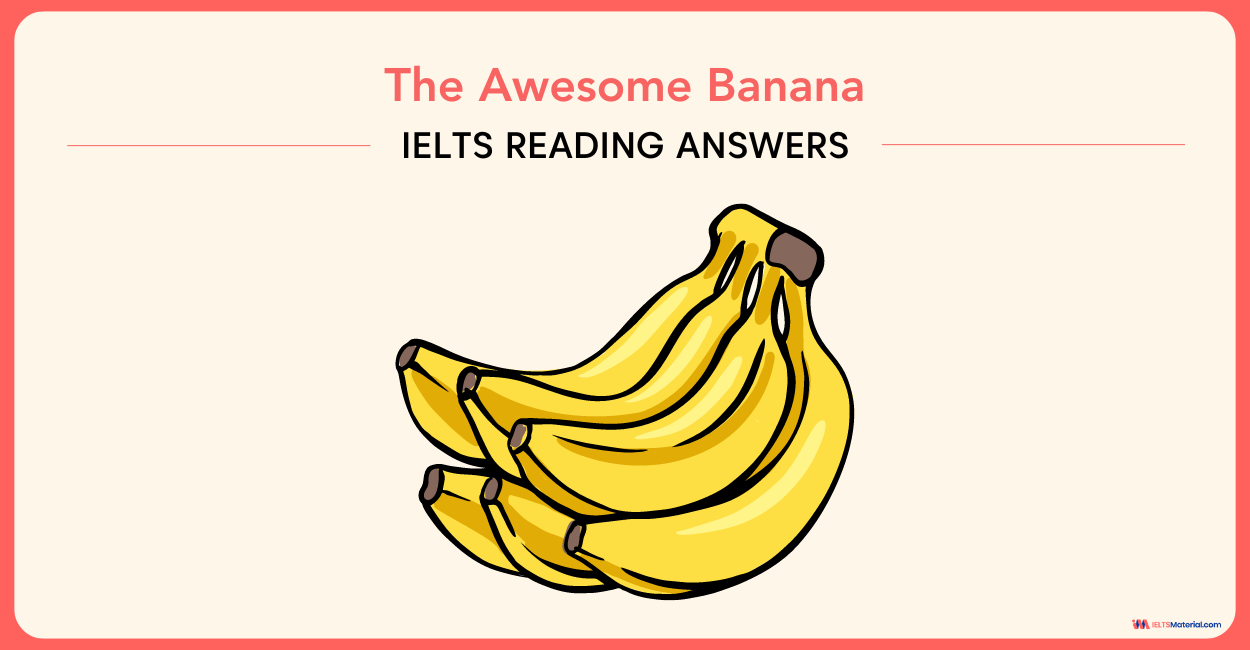
Raajdeep Saha
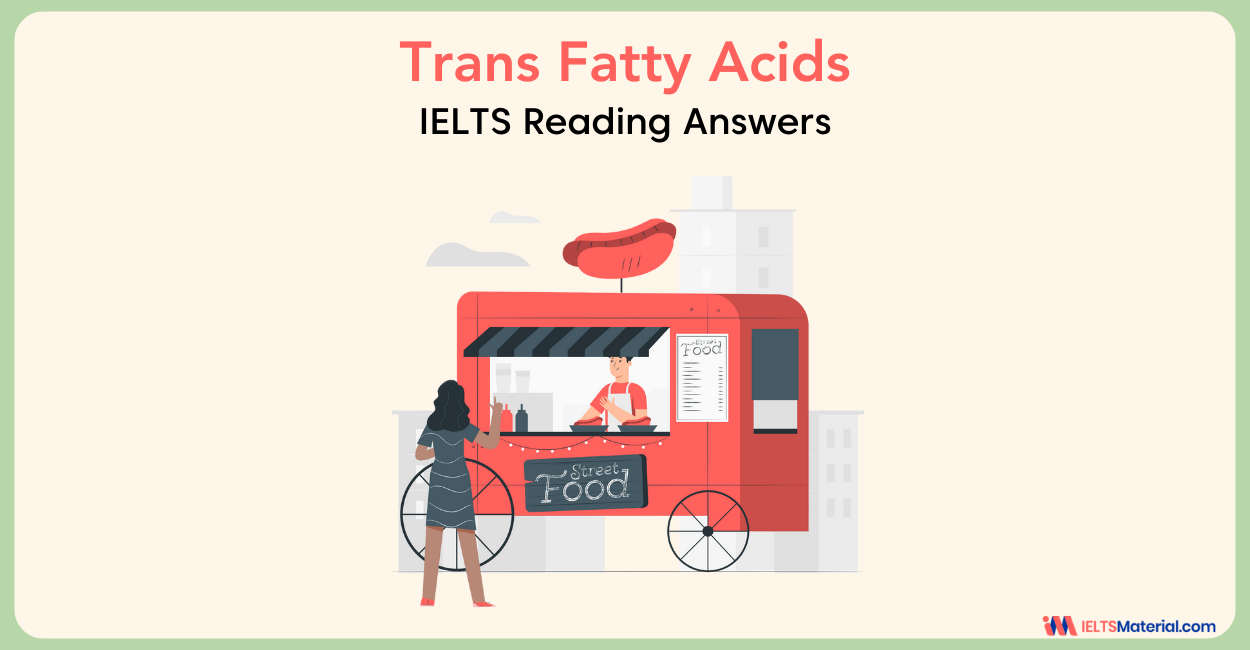
Kasturika Samanta
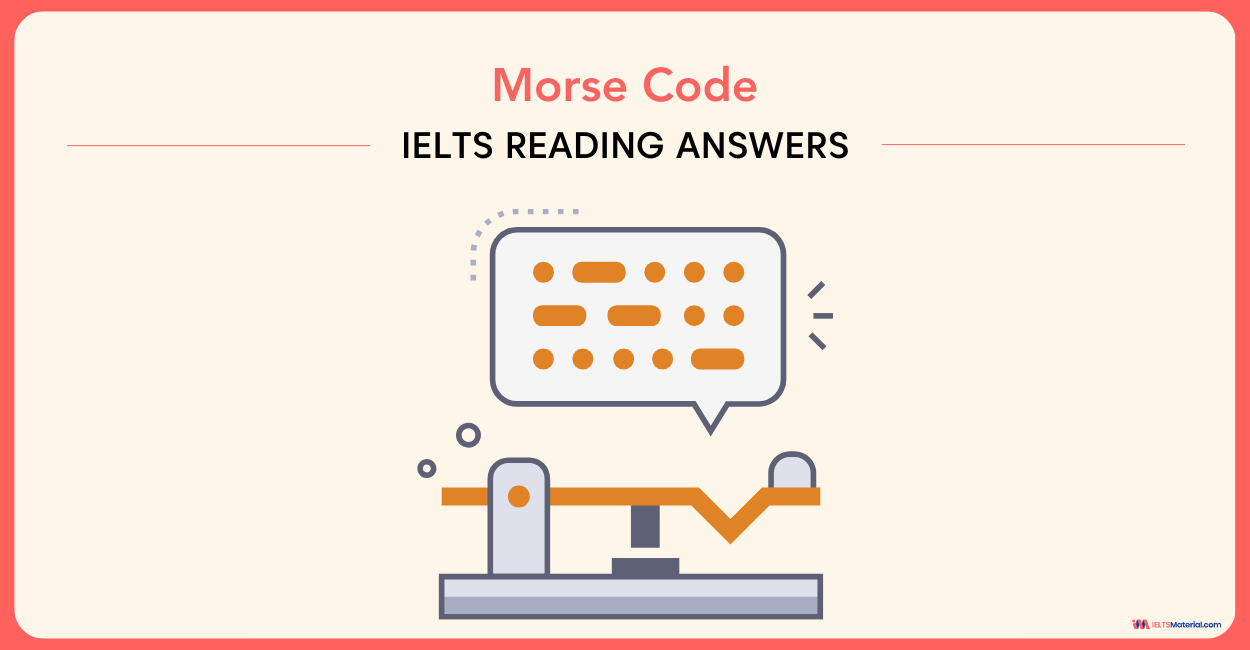
Post your Comments
Recent articles.
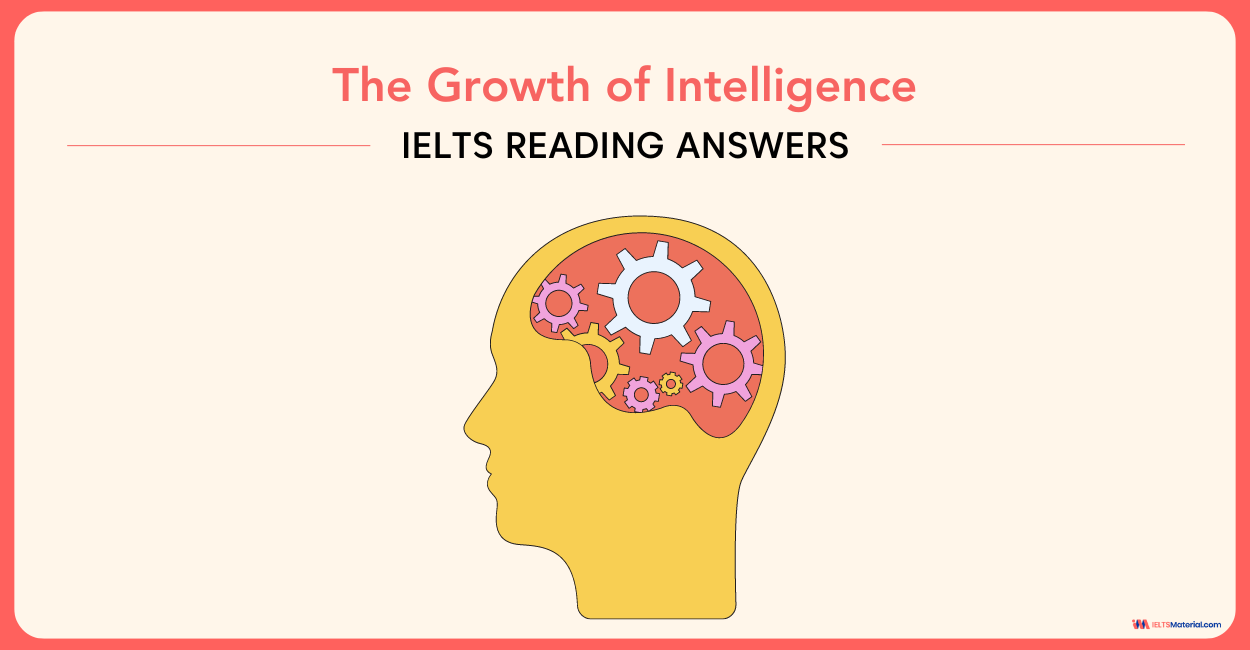
Nehasri Ravishenbagam
Our Offices
Gurgaon city scape, gurgaon bptp.
Step 1 of 3
Great going .
Get a free session from trainer
Have you taken test before?
Please select any option
Get free eBook to excel in test
Please enter Email ID
Get support from an Band 9 trainer
Please enter phone number
Already Registered?
Select a date
Please select a date
Select a time (IST Time Zone)
Please select a time
Mark Your Calendar: Free Session with Expert on
Which exam are you preparing?
Great Going!
Fulfilling Your Dreams
Cambridge IELTS 13 Academic Reading Test 4 Answer Key
Cambridge 13 reading test 4 answers, reading passage - 1, cutty sark: the fastest sailing ship of all time.
Cutty Sark: the fastest sailing ship of all time reading answers
Reading Passage - 2
Saving the soil.
Saving the soil reading answers
- agriculture
Reading Passage - 3
Book review.
Book Review reading answers
Essay questions Join our one to one IELTS online classes Follow us on Instagram Essay model answers IELTS listening answer key
Note: The above content is copyrighted by Cambridge University Press and Cambridge English Language Assessment. We posted this content at the request of IELTS students.
Privacy Overview

Reading Actual Tests
Download PDF ielts reading test
Listening Recent Tests
Download PDF ielts listening test
english-practice.net
Practice English Exercises to Improve Your Skills
english-exercises.net
Practice More English Exercises to Improve Your Skills
englishpracticetest.net
Practice More English Tests to Improve Your Skills
Cambridge Practice Test
Practice Cam Listening Test with Answer & Transcript
Listening Practice Test
Practice Listening Test with Answer & Transcript
Practice Cambridge Reading Test with Answer
Practice Reading Test
Practice Reading Test with Answer
Practice Reading Mock Test with Answer
Speaking Practice Test
Speaking Practice Test with with Band 8-9 Samples
42 Common Topics for ielts Speaking Part 1
100 TOPICS for ielts Speaking Part 2 with Band 8 Sample
70 TOPICS for ielts Speaking Part 2 with Band 8+ Sample Recordings
Vocabulary Words
Most Common Vocabulary Topics for ielts Speaking
Writing Practice Test
Writing Practice Test with Band 8-9 Samples
Writing Mock Test with Band 8-9 Samples
Writing Task 2 Topics with Band 7-8-9 Samples
General Reading Tests
Practice General Reading Test with Answer
Answers and Explanations for Cam 13 Reading Test 4
Cambridge ielts reading with explanations
Question: Clippers were originally intended to be used as passenger ships
Key words: clippers, originally, passenger
At the beginning of paragraph 2, we find the statement: “The fastest commercial sailing vessels of all time were clippers, three-masted ships built to transport goods around the world, although some also took passengers ”.
So, clippers were built/used originally to transport goods, not to carry passengers.
– ships = vessels
The statement is FALSE.
Question: Cutty Sark was given the name of a character in a poem
Key words: name, character, poem
In paragraph 3, the writer explains how the ship was given its name: “Cutty Sark’s unusual name comes from the poem Tam O’Shanter by the Scottish poet, Robert Burns. Tam, a farmer, is chased by a witch called Nannie, who is wearing a ‘cutty sark’ – an oldScottish name for a short nightdress ”.
A cutty sark, therefore, is a short nightdress, not the name of a character in the poem. It was a piece of clothing worn by the witch in the poem.
Question: The contract between John Willis and Scott & Linton favoured Willis
Key words: contract, Willis, Scott & Linton
In paragraph 4, we find the key words: “To carry out construction, Willis chose a new shipbuilding firm, Scott & Linton, and ensured that the contract with them put him in a very strong position . In the end, the firm was forced out of business…”
To be ‘in a strong position’ means that the contract gave Willis an advantage in the business deal. In other words, the contract favoured Willis so much, that the shipbuilding company had to close before the ship was finished.
– favoured ~ put in a very strong position
The statement is TRUE.
Question: John Willis wanted Cutty Sark to be the fastest tea clipper travelling between the UK and China
Key words: Willis, fastest, UK, China
At the beginning of paragraph 5, we find some of the key words: Willis, Britain (the UK) and China. “Willis’s company was active in the tea trade between China and Britain, where speed could bring ship owners both profits and prestige, so Cutty Sark was designed to make the journey more quickly than any other ship ”.
So the idea of Willis was that Cutty Sark would transport the tea between China and the UK faster than any other ship.
– the fastest tea clipper ~ more quickly than any other ship.
Question: Despite storm damage, Cutty Sark beat Thermopylae back to London
Key words: storm damage, beat Thermopylae , London
We need to find information on the race from China to London between these tea clippers. At the end of paragraph 5, we learn that: “…in 1872, the ship and a rival clipper, Thermopylae, left port in China on the same day…”
Although Cutty Sark gained a lead, she was damaged: “…but then her rudder was severely damaged in stormy seas… Cutty Sark reached London a week after Thermopylae ”.
Cutty Sark was damaged by a storm, so she only reached London after Thermopylae.
Question: The opening of the Suez Canal meant that steam ships could travel between Britain and China faster than clippers
Key words: Suez Canal, steam ships, faster
The key words are found at the beginning of paragraph 6: “Steam ships posed a growing threat to clippers, as their speed and cargo capacity increased. In addition, the opening of the Suez Canal in 1869…had a serious impact ”.
The writer then explains why only steam ships could make use of the Suez Canal, and this meant that the steam ships could make the journey faster than clippers, using this short route: “ Steam ships reduced the journey time between Britain and China by approximately two months ”.
– travel faster ~ reduced the journey time
7. NOT GIVEN
Question: Steam ships sometimes used the ocean route to travel between London and China
Key words: ocean route, London and China
Although the writer says in paragraph 6 that only steam ships were able to use the Suez Canal, there is no information whether steam ships sometimes chose to make the journey between London and China using the longer ocean route.
The statement is NOT GIVEN .
Question: Captain Woodget put Cutty Sark at risk of hitting an iceberg
Key words: Captain Woodget, risk, iceberg
Captain Woodget is mentioned in paragraph 8. An excellent navigator, he took Cutty Sark on a route travelling a long way south to take advantage of the winds: “…Woodget took her further south than any previous captain, bringing her dangerously close to icebergs off the southern tip of South America. His gamble paid off , though, and the ship was the fastest vessel in the wool trade for ten years”.
So, Woodget took a risk by travelling this southern route, close to icebergs. However, he was successful.
– risk = gamble
– put Cutty Sark at risk of hitting an iceberg ~ bringing her dangerously close to icebergs
Question: After 1880, Cutty Sark carried ………….. as its main cargo during its most successful time
Key words: 1880, cargo, most successful
Looking for the key words, we find these in paragraph 7. In 1880, two captains of the ship lost their jobs. Then, a new captain was appointed: “This marked a turnaround and the beginning of the most successful period in Cutty Sark’s working life, transporting wool from Australia to Britain”.
Thus, after 1880 the ship had its most successful period, carrying wool.
– carry = transport
– time ~ period
The answer is wool.
10. navigator
Question: As a captain and ……………… , Woodget was very skilled
Key words: captain, Woodget, skilled
The key words are in paragraph 8: “The ship’s next captain, Richard Woodget, was an excellent navigator, who got the best out of both his ship and his crew”.
The writer, therefore, tells us that Woodget was a good captain and a skilled navigator.
The answer is navigator.
Question: Ferreira went to Falmouth to repair damage that a ………… had caused
Key words: Ferreira, Falmouth, repair
In paragraph 9, we find a reference to the Ferreira . The Cutty Sark “…was sold to a Portuguese firm, which renamed her Ferreira ”.
In paragraph 10, we learn what caused the damage: “ Badly damaged in a gale in 1922, she was put into Falmouth harbour, in southwest England, for repairs ”.
A gale (= a strong, stormy wind) damaged the ship.
The answer is gale.
12. training
Question: Between 1923 and 1954, Cutty Sark was used for …………….
Key words: 1923, 1954, used
In paragraph 10, we learn that the ship returned to Falmouth one year after it was repaired: “…the ship returned to Falmouth the following year (= 1923) and had her original name restored”.
Then in paragraph 11, we learn what happened between 1923 and 1954. The new owner, a man named Dowman: “… used Cutty Sark as a training ship, and she continued in this role after his death. When she was no longer required, in 1954 , she was transferred to dry dock at Greenwich to go on public display”.
So, between these years, the ship was used for training.
The answer is training.
Question: Cutty Sark has twice been damaged by ……………. in the 21st century
Key words: twice, damaged, 21st century
In the final paragraph, we find the most recent information about the ship in the 21st century: “ The ship suffered from fire in 2007, and again, less seriously, in 2014 ….”
– damaged by ~ suffered from
The answer is fire.
14. minerals
Question: Healthy soil contains a large variety of bacteria and other microorganisms, as well as plant remains and……………
Key words: healthy, bacteria, microorganisms, plant remains
We need to find information on the contents of healthy soil, using the key words. We find these words in the first part of paragraph B: “ A single gram of healthy soil might contain 100 million bacteria, as well as other microorganisms such as viruses and fungi, living amid decomposing plants and various minerals ”.
Thus, we have a list of the things which healthy soil contains – bacteria, microorganisms, plant remains and minerals.
– plant remains = decomposing plants
The answer is minerals.
Question: It provides us with food and also with antibiotics, and its function in storing …………… has a significant effect on the climate.
Key words: food, antibiotics, storing, climate
The second part of paragraph B gives us the answer: “…soils do not just grow our food , but are the source of nearly all our existing antibiotics , and could be our best hope in the fight against antibiotic-resistant bacteria. Soil is also an ally against climate change: as microorganisms within soil digest dead animals and plants, they lock in their carbon content , holding three times the amount of carbon as does the entire atmosphere”.
In other words, soil holds carbon, preventing its release into the atmosphere and so helping to prevent global warming.
– provides us with ~ are the source of
– store = lock in
– a significant effect on the climate ~ an ally against climate change.
The answer is carbon.
Question: In addition, it prevents damage to property and infrastructure because it holds …………….
Key words: prevents, damage, property and infrastructure, holds
Continuing to look for key words in paragraph B, we find the answer: “Soils also store water, preventing flood damage: in the UK, damage to buildings, roads and bridges from floods caused by soil degradation costs £233 million every year”.
Soils hold water. This reduces the problem of flooding and the damage which is caused by flooding.
– hold = store
– buildings, roads and bridges ~ property and infrastructure
The answer is water.
17. agriculture
Question: The main factor contributing to soil degradation is the ……………… carried out by humans
Key words: main factor, degradation, humans
We find the answer in paragraph C: “ Agriculture is by far the biggest problem ……Humans tend not to return unused parts of harvested crops directly to the soil to enrich it, meaning that the soil gradually becomes less fertile ”.
So, agriculture is the biggest problem. The way that it is practiced/carried out means that the soil becomes less fertile.
– main factor ~ biggest problem
– soil degradation ~ the soil gradually becomes less fertile
The answer is agriculture.
Question: Nutrients contained in the unused parts of harvested crops
Key words: nutrients, unused, harvested crops
We find these key words in the second part of paragraph C: “…when the plants die and decay these nutrients are returned directly to the soil. Humans tend not to return unused parts of harvested crops directly to the soil to enrich it, meaning that the soil gradually becomes less fertile”.
Ending C gives us the following sentence: ‘Nutrients contained in the unused parts of harvested crops may not be put back into the soil ’.
– may not be put back ~ tend not to return
Therefore, the answer is C .
Question: Synthetic fertilisers produced with the Haber-Bosch process
Key words: synthetic fertilisers, Haber-Bosch
Paragraph D contains these key words: “A solution came in the early 20th century with the Haber-Bosch process for manufacturing ammonium nitrate. Farmers have been putting this synthetic fertiliser on their fields ever since.”
Continuing to read, we find out the problems of using these synthetic fertilisers: “Chemical fertilisers can release polluting nitrous oxide into the atmosphere and excess is often washed away with rain, releasing nitrogen into rivers. More recently, we have found that indiscriminate use of fertilisers hurts the soil itself, turning it acidic and salty…”
Ending E gives us the following sentence: ‘Synthetic fertilisers produced with the Haber-Bosch process may cause damage to different aspects of the environment ’. These different aspects are the atmosphere, rivers and the soil.
– damage =hurt
The answer is E.
Question: Addition of a mixture developed by Pius Floris to the soil
Key words: addition, mixture, Pius Floris
The name Pius Floris is mentioned in paragraph E. He “…developed a cocktail of beneficial bacteria, fungi and humus”.
Researchers then “…used this cocktail on soils destroyed by years of fertiliser overuse. When they applied Floris’s mix to the desert-like plots, a good crop of plants emerged that were not just healthy at the surface, but had roots strong enough to pierce dirt as hard as rock. The few plants that grew in the control plots, fed with traditional fertilisers, were small and weak”.
Ending A gives us the following sentence: ‘Addition of a mixture developed by Pius Floris to the soil may improve the number and quality of plants growing there ’.
This is exactly what took place on the plots (= the soil) to which Floris’s mixture/mix was added – more plants grew there, and the plants were stronger.
– mixture = cocktail
The answer is A.
Question: The idea of zero net soil degradation
Key words: idea, zero, degradation
In paragraph G, we find a reference to ‘zero net land degradation’. It is a goal which policymakers can easily understand, like “…the idea of carbon neutrality”. Scientists have therefore proposed this goal to “…shape expectations and encourage action”: “We need ways of presenting the problem that bring it home to governments and the wider public’, says Pamela Chasek at the International Institute for Sustainable Development, in Winnipeg, Canada”.
Ending D gives us the following sentence: ‘The idea of zero net soil degradation may help governments to be more aware of soil-related issues ”.
– be more aware of soil-related issues ~ bring the problem home to governments
The answer is D .
Question: A reference to one person’s motivation for a soil-improvement project
Key words: motivation, soil-improvement project
In paragraph E, Pius Floris is mentioned. His motivation to improve the soil came from “…running a tree-care business in the Netherlands”. The writer tells us that: “He came to realise that the best way to ensure his trees flourished was to take care of the soil , and has developed a cocktail of beneficial bacteria, fungi and humus to do this”.
Therefore, the ‘one person’ referred to is Pius Floris.
The answer is E .
Question: An explanation of how soil stayed healthy before the development of farming
Key words: explanation, soil, healthy, before, farming
We find the answer in paragraph C: “Humans tend not to return unused parts of harvested crops directly to the soil to enrich it, meaning that the soil gradually becomes less fertile. In the past we developed strategies to get around the problem, such as regularly varying the types of crops grown, or leaving fields uncultivated for a season ”.
So, two different strategies are described to explain how – before farming became very developed – the problem of keeping the soil healthy was solved.
The answer is C .
Question: Examples of different ways of collecting information on soil degradation
Key words: ways, collecting information, soil degradation
In paragraph F, we learn that: “…the UN has created the Global Soil Map Project. Researchers from nine countries are working together to create a map linked to a database that can be fed measurements from field surveys, drone surveys, satellite imagery, lab analyses and so on to provide real-time data on the state of the soil ”.
Several different ways of collecting information (measurements) are given as examples of ways to determine the state of the soil, and how much it has been degraded.
– information ~ real-time data
The answer is F .
Question: A suggestion for a way of keeping some types of soil safe in the near future
Key words: soil, safe, near future
In the final paragraph, we find the following statement: “Several researchers are agitating for the immediate creation of protected zones for endangered soils ”.
The suggestion of the researchers is to keep some soil types safe by creating protected zones.
– keeping some types of soil safe ~ creation of protected zones
– the near future = immediate
The answer is G.
Question: A reason why it is difficult to provide an overview of soil degradation
Key words: difficult, overview, soil degradation
We find the answer in paragraph F: “To assess our options on a global scale we first need an accurate picture of what types of soil are out there, and the problems they face. That’s not easy. For one thing, there is no agreed international system for classifying soil ”.
Therefore, we need to have an accurate picture of soil types and the dangers to them. The reason that is difficult is that we have no agreed way of doing this.
– overview = accurate picture
– difficult ~ not easy
– a reason ~ for one thing
Question: What is the reviewer’s attitude to advocates of positive psychology?
Key words: attitude, advocates, positive psychology
In paragraph 1, the reviewer introduces the beliefs of the ‘advocates of positive psychology’. At the beginning of paragraph 2, we find the reviewer’s opinion of these beliefs: “It is an astonishingly crude and simple-minded way of thinking, and for that very reason increasingly popular. Those who think in this way are oblivious to the vast philosophical literature in which the meaning and value of happiness have been explored , and write as if nothing of any importance had been thought on the subject until it came to their attention”.
The attitude of the reviewer is that advocates of positive philosophy are completely ignorant of all that has been thought and written about happiness by earlier thinkers.
– ignorant about = oblivious to
The answer is D.
Question: The reviewer refers to the Greek philosopher Aristotle in order to suggest that happiness
Key words: Greek, Aristotle
Also in paragraph 2, we find a reference to Aristotle: “ For Bentham it was obvious that the human good consists of pleasure and the absence of pain. The Greek philosopher Aristotle may have identified happiness with self-realisation in the 4th century BC and thinkers throughout the ages may have struggled to reconcile the pursuit of happiness with other human values”.
Thus, the reviewer, contrasts the views of Bentham with those of Aristotle. For Aristotle, happiness was not simply the experience of pleasure and the absence of pain – it also consisted of ideas such as self-realisation.
Question: According to Davies, Bentham’s suggestion for linking the price of goods to happiness was significant because
Key words: linking, price, significant
In paragraph 4, Davies writes about Bentham’s views on the connection between price and pleasure/happiness: “…if two different goods have the same price, it can be concluded that they produce the same quantity of pleasure in the consumer… By associating money so closely to inner experience, Davies writes, Bentham ‘ set the stage for the entangling of psychological research and capitalism that would shape the business practices of the twentieth century ”.
– linking the price of goods to happiness ~ associating money so closely to inner experience
– linking = associating
– a connection between work and psychology ~ the entangling of psychological research and capitalism
– work ~ capitalism/business
– was significant ~ set the stage for
The answer is B.
Question: In the 1790s he suggested a type of technology to improve ………….. for different government departments.
Key words: 1790s, technology, improve, government departments
In paragraph 3, Davies writes about Bentham’s active interest in other areas, outside philosophy. “ In the 1790s, he wrote to the Home Office suggesting that the departments of government be linked together through a set of ‘conversation tubes ’….”
In other words, these ‘conversation tubes’ would ‘link together’ government departments, and improve communication between them.
– conversation ~ communication
Question: He developed a new way of printing banknotes to increase………..
Key words: printing banknotes, increase.
The reference to ‘printing’ and ‘banknotes’ is also in paragraph 3. Bentham suggested a design to the Bank of England: “… for a printing device that could produce unforgeable banknotes ”.
If banknotes cannot be forged, then the purpose is to make them more difficult to copy by criminals. This will increase security.
The answer is B .
Question: …and also designed a method for the ……………… of food.
Key words: method, food
In paragraph 3, we learn that Bentham “…drew up plans for a ‘frigidarium’ to keep provisions such as meat, fish, fruit and vegetables fresh ”.
Thus, in order to keep food fresh, the frigidarium was designed to preserve food in cold storage.
– designed ~ drew up plans
– food = provisions
The answer is G .
Question: He also drew up plans for a prison which allowed the …………… of prisoners at all times, and believed the same design could be used for other institutions as well.
Key words: prison, same design, other institutions
The writer continues in paragraph 3: “His celebrated design for a prison to be known as a ‘Panopticon’, in which prisoners would be kept in solitary confinement while being visible at all times to the guards , was very nearly adopted”. The writer tells us that this ‘Panopticon’ was also designed as an instrument of control that could be used in schools and factories, not only prisons. As the prisoners were visible to the guards, the guards would be able to observe the prisoners at all times. The word required is ‘observable’.
Question: When researching happiness, he investigated possibilities for its …………. , and suggested some methods of doing this.
Key words: researching, possibilities, methods
At the beginning of paragraph 4, the writer tells us: “Bentham was also a pioneer of the ‘science of happiness’. If happiness is to be regarded as a science, it has to be measured, and Bentham suggested two ways in which this might be done ”.
– possibilities ~ ways in which this might be done
– methods = ways
Thus, Bentham suggested ways in which to measure happiness. The word required is ‘measurement’.
The answer is A .
Question: One strength of The Happiness Industry is its discussion of the relationship between psychology and economics
Key words: strength, relationship, psychology and economics
At the beginning of paragraph 5, we are told about this book in terms of psychology and economics: “ The Happiness Industry describes how the project of a science of happiness has become integral to capitalism. We learn much that is interesting about how economic problems are being redefined and treated as psychological maladies ”.
So, this book discusses how, in capitalist societies, an attempt has been made to consider economic problems as simply psychological problems. The book is interesting because it shows how this has been done by writers trying to make a ‘science of happiness’. In other words, this is one strong point of the book.
The answer is YES.
36. NOT GIVEN
Question: It is more difficult to measure some emotions than others
Key words: more difficult, measure, emotions
The only reference in the passage to measurement and emotions is in paragraph 5. Here, we only learn that: “In addition, Davies shows how the belief that inner states of pleasure and displeasure can be objectively measured has informed management studies and advertising”.
There is no information about the measurement of different emotions and how such measurements can be compared.
– emotions = inner states
The answer is NOT GIVEN.
Question: Watson’s ideas on behaviourism were supported by research on humans he carried out before 1915.
Key words: Watson, behaviourism, humans, before 1915.
The ideas of Watson are discussed in paragraph 5. “The tendency of thinkers such as J.B. Watson, the founder of behaviourism, was that human beings could be shaped, or manipulated, by policymakers and managers. Watson had no basis for his view of human action. When he became president of the American Psychological Association in 1915 he ‘had never even studied a single human being’: his research had been confined to experiments on white rats ”.
Thus, before 1915, Watson had conducted no research on humans, only on white rats.
The answer is NO.
38. NOT GIVEN
Question: Watson’s ideas have been most influential on governments outside America
Key words: Watson, influential, outside America
The influence of Watson’s ideas are discussed in paragraph 5. “…Watson’s reductive model is now widely applied, with ‘behaviour change’ becoming the goal of governments”.
Although the writer then continues, giving the example of Britain, there is no reference to Watson’s ideas becoming most influential on governments outside America – we only know that his ideas are ‘widely applied’.
The answer is NOT GIVEN .
Question: The need for happiness is linked to industrialisation
Key words: need, linked, industrialisation
In the last paragraph, the writer states: “ Modern industrial societies appear to need the possibility of ever-increasing happiness to motivate them in their labours ”.
Thus, the need for more and more happiness is linked to industrial societies and motivation to work.
– industrialisation ~ industrial societies
Question: A main aim of government should be to increase the happiness of the population
Key words: aim, government, increase, population
It is stated in the last paragraph that: “…whatever its intellectual pedigree, the idea that governments should be responsible for promoting happiness is always a threat to human freedom ”.
The writer believes that if governments take responsibility for increasing the happiness of the population, then people will lose their freedom. The writer is definitely against this aim.
– increase the happiness ~ promoting happiness
Submit a Comment Cancel reply
Your email address will not be published. Required fields are marked *
Save my name, email, and website in this browser for the next time I comment.
Download ebooks
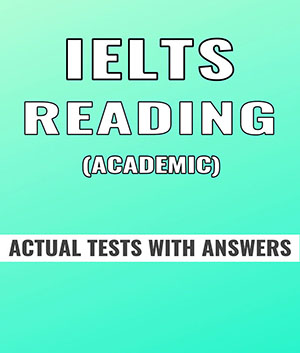

How to Write a Book Review: The Ultimate Guide
WHAT IS A BOOK REVIEW?

Traditionally, book reviews are evaluations of a recently published book in any genre. Usually, around the 500 to 700-word mark, they briefly describe a text’s main elements while appraising the work’s strengths and weaknesses. Published book reviews can appear in newspapers, magazines, and academic journals. They provide the reader with an overview of the book itself and indicate whether or not the reviewer would recommend the book to the reader.
WHAT IS THE PURPOSE OF A BOOK REVIEW?
There was a time when book reviews were a regular appearance in every quality newspaper and many periodicals. They were essential elements in whether or not a book would sell well. A review from a heavyweight critic could often be the deciding factor in whether a book became a bestseller or a damp squib. In the last few decades, however, the book review’s influence has waned considerably, with many potential book buyers preferring to consult customer reviews on Amazon, or sites like Goodreads, before buying. As a result, book review’s appearance in newspapers, journals, and digital media has become less frequent.
WHY BOTHER TEACHING STUDENTS TO WRITE BOOK REVIEWS AT ALL?
Even in the heyday of the book review’s influence, few students who learned the craft of writing a book review became literary critics! The real value of crafting a well-written book review for a student does not lie in their ability to impact book sales. Understanding how to produce a well-written book review helps students to:
● Engage critically with a text
● Critically evaluate a text
● Respond personally to a range of different writing genres
● Improve their own reading, writing, and thinking skills.
Not to Be Confused with a Book Report!
WHAT’S THE DIFFERENCE BETWEEN A BOOK REVIEW AND A BOOK REPORT?

While the terms are often used interchangeably, there are clear differences in both the purpose and the format of the two genres. Generally speaking, book reports aim to give a more detailed outline of what occurs in a book. A book report on a work of fiction will tend to give a comprehensive account of the characters, major plot lines, and themes in the book. Book reports are usually written around the K-12 age range, while book reviews tend not to be undertaken by those at the younger end of this age range due to the need for the higher-level critical skills required in writing them. At their highest expression, book reviews are written at the college level and by professional critics.
Learn how to write a book review step by step with our complete guide for students and teachers by familiarizing yourself with the structure and features.
BOOK REVIEW STRUCTURE
ANALYZE Evaluate the book with a critical mind.
THOROUGHNESS The whole is greater than the sum of all its parts. Review the book as a WHOLE.
COMPARE Where appropriate compare to similar texts and genres.
THUMBS UP OR DOWN? You are going to have to inevitably recommend or reject this book to potential readers.
BE CONSISTENT Take a stance and stick with it throughout your review.

FEATURES OF A BOOK REVIEW
PAST TENSE You are writing about a book you have already read.
EMOTIVE LANGUAGE Whatever your stance or opinion be passionate about it. Your audience will thank you for it.
VOICE Both active and passive voice are used in recounts.
A COMPLETE UNIT ON REVIEW AND ANALYSIS OF TEXTS

⭐ Make MOVIES A MEANINGFUL PART OF YOUR CURRICULUM with this engaging collection of tasks and tools your students will love. ⭐ All the hard work is done for you with NO PREPARATION REQUIRED.
This collection of 21 INDEPENDENT TASKS and GRAPHIC ORGANIZERS takes students beyond the hype, special effects and trailers to look at visual literacy from several perspectives offering DEEP LEARNING OPPORTUNITIES by watching a SERIES, DOCUMENTARY, FILM, and even VIDEO GAMES.
ELEMENTS OF A BOOK REVIEW
As with any of the writing genres we teach our students, a book review can be helpfully explained in terms of criteria. While there is much to the ‘art’ of writing, there is also, thankfully, a lot of the nuts and bolts that can be listed too. Have students consider the following elements before writing:
● Title: Often, the title of the book review will correspond to the title of the text itself, but there may also be some examination of the title’s relevance. How does it fit into the purpose of the work as a whole? Does it convey a message or reveal larger themes explored within the work?
● Author: Within the book review, there may be some discussion of who the author is and what they have written before, especially if it relates to the current work being reviewed. There may be some mention of the author’s style and what they are best known for. If the author has received any awards or prizes, this may also be mentioned within the body of the review.
● Genre: A book review will identify the genre that the book belongs to, whether fiction or nonfiction, poetry, romance, science-fiction, history etc. The genre will likely tie in, too with who the intended audience for the book is and what the overall purpose of the work is.
● Book Jacket / Cover: Often, a book’s cover will contain artwork that is worthy of comment. It may contain interesting details related to the text that contribute to, or detract from, the work as a whole.
● Structure: The book’s structure will often be heavily informed by its genre. Have students examine how the book is organized before writing their review. Does it contain a preface from a guest editor, for example? Is it written in sections or chapters? Does it have a table of contents, index, glossary etc.? While all these details may not make it into the review itself, looking at how the book is structured may reveal some interesting aspects.
● Publisher and Price: A book review will usually contain details of who publishes the book and its cost. A review will often provide details of where the book is available too.

BOOK REVIEW KEY ELEMENTS
As students read and engage with the work they will review, they will develop a sense of the shape their review will take. This will begin with the summary. Encourage students to take notes during the reading of the work that will help them in writing the summary that will form an essential part of their review. Aspects of the book they may wish to take notes on in a work of fiction may include:
● Characters: Who are the main characters? What are their motivations? Are they convincingly drawn? Or are they empathetic characters?
● Themes: What are the main themes of the work? Are there recurring motifs in the work? Is the exploration of the themes deep or surface only?
● Style: What are the key aspects of the writer’s style? How does it fit into the wider literary world?
● Plot: What is the story’s main catalyst? What happens in the rising action? What are the story’s subplots?
A book review will generally begin with a short summary of the work itself. However, it is important not to give too much away, remind students – no spoilers, please! For nonfiction works, this may be a summary of the main arguments of the work, again, without giving too much detail away. In a work of fiction, a book review will often summarise up to the rising action of the piece without going beyond to reveal too much!

The summary should also provide some orientation for the reader. Given the nature of the purpose of a review, it is important that students’ consider their intended audience in the writing of their review. Readers will most likely not have read the book in question and will require some orientation. This is often achieved through introductions to the main characters, themes, primary arguments etc. This will help the reader to gauge whether or not the book is of interest to them.
Once your student has summarized the work, it is time to ‘review’ in earnest. At this point, the student should begin to detail their own opinion of the book. To do this well they should:
i. Make It Personal
Often when teaching essay writing we will talk to our students about the importance of climbing up and down the ladder of abstraction. Just as it is helpful to explore large, more abstract concepts in an essay by bringing it down to Earth, in a book review, it is important that students can relate the characters, themes, ideas etc to their own lives.
Book reviews are meant to be subjective. They are opinion pieces, and opinions grow out of our experiences of life. Encourage students to link the work they are writing about to their own personal life within the body of the review. By making this personal connection to the work, students contextualize their opinions for the readers and help them to understand whether the book will be of interest to them or not in the process.
ii. Make It Universal
Just as it is important to climb down the ladder of abstraction to show how the work relates to individual life, it is important to climb upwards on the ladder too. Students should endeavor to show how the ideas explored in the book relate to the wider world. The may be in the form of the universality of the underlying themes in a work of fiction or, for example, the international implications for arguments expressed in a work of nonfiction.
iii. Support Opinions with Evidence
A book review is a subjective piece of writing by its very nature. However, just because it is subjective does not mean that opinions do not need to be justified. Make sure students understand how to back up their opinions with various forms of evidence, for example, quotations, statistics, and the use of primary and secondary sources.
EDIT AND REVISE YOUR BOOK REVIEW

As with any writing genre, encourage students to polish things up with review and revision at the end. Encourage them to proofread and check for accurate spelling throughout, with particular attention to the author’s name, character names, publisher etc.
It is good practice too for students to double-check their use of evidence. Are statements supported? Are the statistics used correctly? Are the quotations from the text accurate? Mistakes such as these uncorrected can do great damage to the value of a book review as they can undermine the reader’s confidence in the writer’s judgement.
The discipline of writing book reviews offers students opportunities to develop their writing skills and exercise their critical faculties. Book reviews can be valuable standalone activities or serve as a part of a series of activities engaging with a central text. They can also serve as an effective springboard into later discussion work based on the ideas and issues explored in a particular book. Though the book review does not hold the sway it once did in the mind’s of the reading public, it still serves as an effective teaching tool in our classrooms today.

Teaching Resources
Use our resources and tools to improve your student’s writing skills through proven teaching strategies.
BOOK REVIEW GRAPHIC ORGANIZER (TEMPLATE)

101 DIGITAL & PRINT GRAPHIC ORGANIZERS FOR ALL CURRICULUM AREAS

Introduce your students to 21st-century learning with this GROWING BUNDLE OF 101 EDITABLE & PRINTABLE GRAPHIC ORGANIZERS. ✌ NO PREP REQUIRED!!! ✌ Go paperless, and let your students express their knowledge and creativity through the power of technology and collaboration inside and outside the classroom with ease.
Whilst you don’t have to have a 1:1 or BYOD classroom to benefit from this bundle, it has been purpose-built to deliver through platforms such as ✔ GOOGLE CLASSROOM, ✔ OFFICE 365, ✔ or any CLOUD-BASED LEARNING PLATFORM.
Book and Movie review writing examples (Student Writing Samples)
Below are a collection of student writing samples of book reviews. Click on the image to enlarge and explore them in greater detail. Please take a moment to both read the movie or book review in detail but also the teacher and student guides which highlight some of the key elements of writing a text review
Please understand these student writing samples are not intended to be perfect examples for each age or grade level but a piece of writing for students and teachers to explore together to critically analyze to improve student writing skills and deepen their understanding of book review writing.
We would recommend reading the example either a year above and below, as well as the grade you are currently working with to gain a broader appreciation of this text type .

BOOK REVIEW VIDEO TUTORIALS

OTHER GREAT ARTICLES RELATED TO BOOK REVIEWS

Transactional Writing

How to write a text response

How to Write a Compare and Contrast Essay

How to Write Excellent Expository Essays
- Full IELTS Practice Tests
- Practice Tests
Book review on Musicophilia
- View Solution
Solution for: Book review on Musicophilia
Answer table.
Found a mistake? Let us know!
Share this Practice Test
Exam Review

Norman M. Weinberger reviews the latest work of Oliver Sacks on music.
Music and the brain are both endlessly fascinating subjects, and as a neuroscientist specialising in auditory learning and memory, I find them especially intriguing. So I had high expectations of Musicophilia, the latest offering from neurologist and prolific author Oliver Sacks. And I confess to feeling a little guilty reporting that my reactions to the book are mixed.
Sacks himself is the best part of Musicophilia. He richly documents his own life in the book and reveals highly personal experiences. The photograph of him on the cover of the book-which shows him wearing headphones, eyes closed, clearly enchanted as he listens to Alfred Brendel perform Beethoven’s Pathetique Sonata-makes a positive impression that is borne out by the contents of the book. Sacks’ voice throughout is steady and erudite but never pontifical. He is neither self-conscious nor self-promoting.
The preface gives a good idea of what the book will deliver. In it, Sacks explains that he wants to convey the insights gleaned from the “enormous and rapidly growing body of work on the neural underpinnings of musical perception and imagery, and the complex and often bizarre disorders to which these are prone.” He also stresses the importance of “the simple art of observation” and “the richness of the human context.” He wants to combine “observation and description with the latest in technology,” he says, and to imaginatively enter into the experience of his patients and subjects. The reader can see that Sacks, who has been practicing neurology for 40 years, is torn between the “old-fashioned” path of observation and the new-fangled, high-tech approach: He knows that he needs to take heed of the latter, but his heart lies with the former.
The book consists mainly of detailed descriptions of cases, most of them involving patients whom Sacks has seen in his practice. Brief discussions of contemporary neuroscientific reports are sprinkled liberally throughout the text. Part, “Haunted by Music,” begins with the strange case of Tony Cicoria, a nonmusical, middle-aged surgeon who was consumed by a love of music after being hit by lightning. He suddenly began to crave listening to piano music, which he had never cared for in the past. He started to play the piano and then to compose music, which arose spontaneously in his mind in a “torrent” of notes. How could this happen? Was the cause psychological? (He had had a near-death experience when the lightning struck him.) Or was it the direct result of a change in the auditory regions of his cerebral cortex? Electroencephalography (EEG) showed his brain waves to be normal in the mid-1990s, just after his trauma and subsequent “conversion” to music. There are now more sensitive tests, but Cicoria, has declined to undergo them; he does not want to delve into the causes of his musicality. What a shame!
Part II, “A Range of Musicality,” covers a wider variety of topics, but unfortunately, some of the chapters offer little or nothing that is new. For example, chapter 13, which is five pages long, merely notes that the blind often has better hearing than the sighted. The most interesting chapters are those that present the strangest cases. Chapter 8 is about “amusia,” an inability to hear sounds like music, and “dysharmonia,” a highly specific impairment of the ability to hear harmony, with the ability to understand melody left intact. Such specific “dissociations” are found throughout the cases Sacks recounts.
To Sacks’s credit, part III, “Memory, Movement and Music,” brings us into the underappreciated realm of music therapy. Chapter 16 explains how “melodic intonation therapy” is being used to help expressive aphasic patients (those unable to express their thoughts verbally following a stroke or other cerebral incident) once again become capable of fluent speech. In chapter 20, Sacks demonstrates the near-miraculous power of music to animate Parkinson’s patients and other people with severe movement disorders, even those who are frozen into odd postures. Scientists cannot yet explain how music achieves this effect
To readers who are unfamiliar with neuroscience and music behavior, Musicophilia may be something of a revelation. But the book will not satisfy those seeking the causes and implications of the phenomena Sacks describes. For one thing, Sacks appears to be more at ease discussing patients than discussing experiments. And he tends to be rather uncritical in accepting scientific findings and theories.
It’s true that the causes of music-brain oddities remain poorly understood. However, Sacks could have done more to draw out some of the implications of the careful observations that he and other neurologists have made and of the treatments that have been successful. For example, he might have noted that the many specific dissociations among components of music comprehension, such as loss of the ability to perceive harmony but not melody, indicate that there is no music center in the brain. Because many people who read the book are likely to believe in the brain localisation of all mental functions, this was a missed educational opportunity.
Another conclusion one could draw is that there seem to be no “cures” for neurological problems involving music. A drug can alleviate a symptom in one patient and aggravate it in another or can have both positive and negative effects in the same patient. Treatments mentioned seem to be almost exclusively antiepileptic medications, which “damp down” the excitability of the brain in general; their effectiveness varies widely.
Finally, in many of the cases described here the patient with music-brain symptoms is reported to have “normal” EEG results. Although Sacks recognises the existence of new technologies, among them far more sensitive ways to analyze brain waves than the standard neurological EEG test, he does not call for their use. In fact, although he exhibits the greatest compassion for patients, he conveys no sense of urgency about the pursuit of new avenues in the diagnosis and treatment of music-brain disorders. This absence echoes the book’s preface, in which Sacks expresses fear that “the simple art of observation may be lost” if we rely too much on new technologies. He does call for both approaches, though, and we can only hope that the neurological community will respond.
Questions 1-4
Choose the correct letter, A , B , C or D .
Write your answers in boxes 1-4 on your answer sheet.
1. Why does the writer have a mixed feeling about the book?
A The guilty feeling made him so.
B The writer expected it to be better than it was.
C Sacks failed to include his personal stories in the book.
D This is the only book written by Sacks. Answer: B
2. What is the best part of the book?
A the photo of Sacks listening to music
B the tone of voice of the book
C the autobiographical description in the book
D the description of Sacks’ wealth Answer: C
3. In the preface, what did Sacks try to achieve?
A make a herald introduction of the research work and technique applied
B give a detailed description of various musical disorders
C explain why he needs to do away with the simple observation
D explain why he needs to do away with the simple observation Answer: A
4. What is disappointing about Tony Cicoria’s case?
A He refuses to have further tests.
B He can’t determine the cause of his sudden musicality.
C He nearly died because of the lightening.
D His brain waves were too normal to show anything. Answer: A
Questions 5-10
Do the following statements agree with the views of the writer in Reading Passage?
In boxes 5-10 on your answer sheet, write
TRUE if the statement agrees with the views of the writer
FALSE if the statement contradicts with the views of the writer
NOT GIVEN if it is impossible to say what the writer thinks about this
5 TRUE FALSE NOT GIVEN It is difficult to give a well-reputable writer a less than totally favorable review. Answer: YES
6 TRUE FALSE NOT GIVEN Beethoven’s Pathetique Sonata is a good treatment for musical disorders. Answer: NOT GIVEN
7 TRUE FALSE NOT GIVEN Sacks believes technological methods is of little importance compared with traditional observation when studying his patients. Answer: NO
8 TRUE FALSE NOT GIVEN It is difficult to understand why music therapy is undervalued Answer: NOT GIVEN
9 TRUE FALSE NOT GIVEN Sacks held little skepticism when borrowing other theories and findings in describing reasons and notion for phenomena he depicts in the book. Answer: YES
10 TRUE FALSE NOT GIVEN Sacks is in a rush to use new testing methods to do treatment for patients. Answer: NO
Questions 11-14
Complete each sentence with the correct ending, A-F , below.
Write the correct letter, A-F , in boxes 11-14 on your answer sheet.
11 A B C D E F The content covered dissociations in understanding between harmony and melody Answer: F
12 A B C D E F The study of treating musical disorders Answer: B
13 A B C D E F The EEG scans of Sacks’ patients Answer: A
14 A B C D E F Sacks believes testing based on new technologies Answer: D
A show no music-brain disorders.
B indicates that medication can have varied results.
C is key for the neurological community to unravel the mysteries.
D should not be used in isolation.
E indicate that not everyone can receive a good education.
F show a misconception that there is a function centre localized in the brain
Other Tests
- 5 - Matching Headings
- 3 - Sentence Completion
- 5 - Summary, form completion
Aqua Product: New zealand ‘s Algae Biodiesel
- Recent Actual Tests
- 0 unanswered
- 2 - Multiple Choice
- 6 - Matching Information
Facial Expression 1
- 5 - Multiple Choice
- 4 - Matching Headings
- 4 - Summary, form completion
Museum Blockbuster
- 6 - TRUE-FALSE-NOT GIVEN
Mystery in Easter Island
- 4 - TRUE-FALSE-NOT GIVEN
- 5 - Sentence Completion
Communication in Science
- 4 - Matching Information
- 4 - Sentence Completion
Ancient Storytelling
Found a mistake let us know.
Please descibe the mistake as details as possible along with your expected correction, leave your email so we can contact with you when needed.
Describe what is wrong with the practice test:
Please enter description
Enter your name:
Enter your email address:
Please enter a valid email


Join Discovery, the new community for book lovers
Trust book recommendations from real people, not robots 🤓
Blog – Posted on Friday, Mar 29
17 book review examples to help you write the perfect review.

It’s an exciting time to be a book reviewer. Once confined to print newspapers and journals, reviews now dot many corridors of the Internet — forever helping others discover their next great read. That said, every book reviewer will face a familiar panic: how can you do justice to a great book in just a thousand words?
As you know, the best way to learn how to do something is by immersing yourself in it. Luckily, the Internet (i.e. Goodreads and other review sites , in particular) has made book reviews more accessible than ever — which means that there are a lot of book reviews examples out there for you to view!
In this post, we compiled 17 prototypical book review examples in multiple genres to help you figure out how to write the perfect review . If you want to jump straight to the examples, you can skip the next section. Otherwise, let’s first check out what makes up a good review.
Are you interested in becoming a book reviewer? We recommend you check out Reedsy Discovery , where you can earn money for writing reviews — and are guaranteed people will read your reviews! To register as a book reviewer, sign up here.
Pro-tip : But wait! How are you sure if you should become a book reviewer in the first place? If you're on the fence, or curious about your match with a book reviewing career, take our quick quiz:
Should you become a book reviewer?
Find out the answer. Takes 30 seconds!
What must a book review contain?
Like all works of art, no two book reviews will be identical. But fear not: there are a few guidelines for any aspiring book reviewer to follow. Most book reviews, for instance, are less than 1,500 words long, with the sweet spot hitting somewhere around the 1,000-word mark. (However, this may vary depending on the platform on which you’re writing, as we’ll see later.)
In addition, all reviews share some universal elements, as shown in our book review templates . These include:
- A review will offer a concise plot summary of the book.
- A book review will offer an evaluation of the work.
- A book review will offer a recommendation for the audience.
If these are the basic ingredients that make up a book review, it’s the tone and style with which the book reviewer writes that brings the extra panache. This will differ from platform to platform, of course. A book review on Goodreads, for instance, will be much more informal and personal than a book review on Kirkus Reviews, as it is catering to a different audience. However, at the end of the day, the goal of all book reviews is to give the audience the tools to determine whether or not they’d like to read the book themselves.
Keeping that in mind, let’s proceed to some book review examples to put all of this in action.
How much of a book nerd are you, really?
Find out here, once and for all. Takes 30 seconds!
Book review examples for fiction books
Since story is king in the world of fiction, it probably won’t come as any surprise to learn that a book review for a novel will concentrate on how well the story was told .
That said, book reviews in all genres follow the same basic formula that we discussed earlier. In these examples, you’ll be able to see how book reviewers on different platforms expertly intertwine the plot summary and their personal opinions of the book to produce a clear, informative, and concise review.
Note: Some of the book review examples run very long. If a book review is truncated in this post, we’ve indicated by including a […] at the end, but you can always read the entire review if you click on the link provided.
Examples of literary fiction book reviews
Kirkus Reviews reviews Ralph Ellison’s The Invisible Man :
An extremely powerful story of a young Southern Negro, from his late high school days through three years of college to his life in Harlem.
His early training prepared him for a life of humility before white men, but through injustices- large and small, he came to realize that he was an "invisible man". People saw in him only a reflection of their preconceived ideas of what he was, denied his individuality, and ultimately did not see him at all. This theme, which has implications far beyond the obvious racial parallel, is skillfully handled. The incidents of the story are wholly absorbing. The boy's dismissal from college because of an innocent mistake, his shocked reaction to the anonymity of the North and to Harlem, his nightmare experiences on a one-day job in a paint factory and in the hospital, his lightning success as the Harlem leader of a communistic organization known as the Brotherhood, his involvement in black versus white and black versus black clashes and his disillusion and understanding of his invisibility- all climax naturally in scenes of violence and riot, followed by a retreat which is both literal and figurative. Parts of this experience may have been told before, but never with such freshness, intensity and power.
This is Ellison's first novel, but he has complete control of his story and his style. Watch it.
Lyndsey reviews George Orwell’s 1984 on Goodreads:
YOU. ARE. THE. DEAD. Oh my God. I got the chills so many times toward the end of this book. It completely blew my mind. It managed to surpass my high expectations AND be nothing at all like I expected. Or in Newspeak "Double Plus Good." Let me preface this with an apology. If I sound stunningly inarticulate at times in this review, I can't help it. My mind is completely fried.
This book is like the dystopian Lord of the Rings, with its richly developed culture and economics, not to mention a fully developed language called Newspeak, or rather more of the anti-language, whose purpose is to limit speech and understanding instead of to enhance and expand it. The world-building is so fully fleshed out and spine-tinglingly terrifying that it's almost as if George travelled to such a place, escaped from it, and then just wrote it all down.
I read Fahrenheit 451 over ten years ago in my early teens. At the time, I remember really wanting to read 1984, although I never managed to get my hands on it. I'm almost glad I didn't. Though I would not have admitted it at the time, it would have gone over my head. Or at the very least, I wouldn't have been able to appreciate it fully. […]
The New York Times reviews Lisa Halliday’s Asymmetry :
Three-quarters of the way through Lisa Halliday’s debut novel, “Asymmetry,” a British foreign correspondent named Alistair is spending Christmas on a compound outside of Baghdad. His fellow revelers include cameramen, defense contractors, United Nations employees and aid workers. Someone’s mother has FedExed a HoneyBaked ham from Maine; people are smoking by the swimming pool. It is 2003, just days after Saddam Hussein’s capture, and though the mood is optimistic, Alistair is worrying aloud about the ethics of his chosen profession, wondering if reporting on violence doesn’t indirectly abet violence and questioning why he’d rather be in a combat zone than reading a picture book to his son. But every time he returns to London, he begins to “spin out.” He can’t go home. “You observe what people do with their freedom — what they don’t do — and it’s impossible not to judge them for it,” he says.
The line, embedded unceremoniously in the middle of a page-long paragraph, doubles, like so many others in “Asymmetry,” as literary criticism. Halliday’s novel is so strange and startlingly smart that its mere existence seems like commentary on the state of fiction. One finishes “Asymmetry” for the first or second (or like this reader, third) time and is left wondering what other writers are not doing with their freedom — and, like Alistair, judging them for it.
Despite its title, “Asymmetry” comprises two seemingly unrelated sections of equal length, appended by a slim and quietly shocking coda. Halliday’s prose is clean and lean, almost reportorial in the style of W. G. Sebald, and like the murmurings of a shy person at a cocktail party, often comic only in single clauses. It’s a first novel that reads like the work of an author who has published many books over many years. […]
Emily W. Thompson reviews Michael Doane's The Crossing on Reedsy Discovery :
In Doane’s debut novel, a young man embarks on a journey of self-discovery with surprising results.
An unnamed protagonist (The Narrator) is dealing with heartbreak. His love, determined to see the world, sets out for Portland, Oregon. But he’s a small-town boy who hasn’t traveled much. So, the Narrator mourns her loss and hides from life, throwing himself into rehabbing an old motorcycle. Until one day, he takes a leap; he packs his bike and a few belongings and heads out to find the Girl.
Following in the footsteps of Jack Kerouac and William Least Heat-Moon, Doane offers a coming of age story about a man finding himself on the backroads of America. Doane’s a gifted writer with fluid prose and insightful observations, using The Narrator’s personal interactions to illuminate the diversity of the United States.
The Narrator initially sticks to the highways, trying to make it to the West Coast as quickly as possible. But a hitchhiker named Duke convinces him to get off the beaten path and enjoy the ride. “There’s not a place that’s like any other,” [39] Dukes contends, and The Narrator realizes he’s right. Suddenly, the trip is about the journey, not just the destination. The Narrator ditches his truck and traverses the deserts and mountains on his bike. He destroys his phone, cutting off ties with his past and living only in the moment.
As he crosses the country, The Narrator connects with several unique personalities whose experiences and views deeply impact his own. Duke, the complicated cowboy and drifter, who opens The Narrator’s eyes to a larger world. Zooey, the waitress in Colorado who opens his heart and reminds him that love can be found in this big world. And Rosie, The Narrator’s sweet landlady in Portland, who helps piece him back together both physically and emotionally.
This supporting cast of characters is excellent. Duke, in particular, is wonderfully nuanced and complicated. He’s a throwback to another time, a man without a cell phone who reads Sartre and sleeps under the stars. Yet he’s also a grifter with a “love ‘em and leave ‘em” attitude that harms those around him. It’s fascinating to watch The Narrator wrestle with Duke’s behavior, trying to determine which to model and which to discard.
Doane creates a relatable protagonist in The Narrator, whose personal growth doesn’t erase his faults. His willingness to hit the road with few resources is admirable, and he’s prescient enough to recognize the jealousy of those who cannot or will not take the leap. His encounters with new foods, places, and people broaden his horizons. Yet his immaturity and selfishness persist. He tells Rosie she’s been a good mother to him but chooses to ignore the continuing concern from his own parents as he effectively disappears from his old life.
Despite his flaws, it’s a pleasure to accompany The Narrator on his physical and emotional journey. The unexpected ending is a fitting denouement to an epic and memorable road trip.
The Book Smugglers review Anissa Gray’s The Care and Feeding of Ravenously Hungry Girls :
I am still dipping my toes into the literally fiction pool, finding what works for me and what doesn’t. Books like The Care and Feeding of Ravenously Hungry Girls by Anissa Gray are definitely my cup of tea.
Althea and Proctor Cochran had been pillars of their economically disadvantaged community for years – with their local restaurant/small market and their charity drives. Until they are found guilty of fraud for stealing and keeping most of the money they raised and sent to jail. Now disgraced, their entire family is suffering the consequences, specially their twin teenage daughters Baby Vi and Kim. To complicate matters even more: Kim was actually the one to call the police on her parents after yet another fight with her mother. […]
Examples of children’s and YA fiction book reviews
The Book Hookup reviews Angie Thomas’ The Hate U Give :
♥ Quick Thoughts and Rating: 5 stars! I can’t imagine how challenging it would be to tackle the voice of a movement like Black Lives Matter, but I do know that Thomas did it with a finesse only a talented author like herself possibly could. With an unapologetically realistic delivery packed with emotion, The Hate U Give is a crucially important portrayal of the difficulties minorities face in our country every single day. I have no doubt that this book will be met with resistance by some (possibly many) and slapped with a “controversial” label, but if you’ve ever wondered what it was like to walk in a POC’s shoes, then I feel like this is an unflinchingly honest place to start.
In Angie Thomas’s debut novel, Starr Carter bursts on to the YA scene with both heart-wrecking and heartwarming sincerity. This author is definitely one to watch.
♥ Review: The hype around this book has been unquestionable and, admittedly, that made me both eager to get my hands on it and terrified to read it. I mean, what if I was to be the one person that didn’t love it as much as others? (That seems silly now because of how truly mesmerizing THUG was in the most heartbreakingly realistic way.) However, with the relevancy of its summary in regards to the unjust predicaments POC currently face in the US, I knew this one was a must-read, so I was ready to set my fears aside and dive in. That said, I had an altogether more personal, ulterior motive for wanting to read this book. […]
The New York Times reviews Melissa Albert’s The Hazel Wood :
Alice Crewe (a last name she’s chosen for herself) is a fairy tale legacy: the granddaughter of Althea Proserpine, author of a collection of dark-as-night fairy tales called “Tales From the Hinterland.” The book has a cult following, and though Alice has never met her grandmother, she’s learned a little about her through internet research. She hasn’t read the stories, because her mother, Ella Proserpine, forbids it.
Alice and Ella have moved from place to place in an attempt to avoid the “bad luck” that seems to follow them. Weird things have happened. As a child, Alice was kidnapped by a man who took her on a road trip to find her grandmother; he was stopped by the police before they did so. When at 17 she sees that man again, unchanged despite the years, Alice panics. Then Ella goes missing, and Alice turns to Ellery Finch, a schoolmate who’s an Althea Proserpine superfan, for help in tracking down her mother. Not only has Finch read every fairy tale in the collection, but handily, he remembers them, sharing them with Alice as they journey to the mysterious Hazel Wood, the estate of her now-dead grandmother, where they hope to find Ella.
“The Hazel Wood” starts out strange and gets stranger, in the best way possible. (The fairy stories Finch relays, which Albert includes as their own chapters, are as creepy and evocative as you’d hope.) Albert seamlessly combines contemporary realism with fantasy, blurring the edges in a way that highlights that place where stories and real life convene, where magic contains truth and the world as it appears is false, where just about anything can happen, particularly in the pages of a very good book. It’s a captivating debut. […]
James reviews Margaret Wise Brown’s Goodnight, Moon on Goodreads:
Goodnight Moon by Margaret Wise Brown is one of the books that followers of my blog voted as a must-read for our Children's Book August 2018 Readathon. Come check it out and join the next few weeks!
This picture book was such a delight. I hadn't remembered reading it when I was a child, but it might have been read to me... either way, it was like a whole new experience! It's always so difficult to convince a child to fall asleep at night. I don't have kids, but I do have a 5-month-old puppy who whines for 5 minutes every night when he goes in his cage/crate (hopefully he'll be fully housebroken soon so he can roam around when he wants). I can only imagine! I babysat a lot as a teenager and I have tons of younger cousins, nieces, and nephews, so I've been through it before, too. This was a believable experience, and it really helps show kids how to relax and just let go when it's time to sleep.
The bunny's are adorable. The rhymes are exquisite. I found it pretty fun, but possibly a little dated given many of those things aren't normal routines anymore. But the lessons to take from it are still powerful. Loved it! I want to sample some more books by this fine author and her illustrators.
Publishers Weekly reviews Elizabeth Lilly’s Geraldine :
This funny, thoroughly accomplished debut opens with two words: “I’m moving.” They’re spoken by the title character while she swoons across her family’s ottoman, and because Geraldine is a giraffe, her full-on melancholy mode is quite a spectacle. But while Geraldine may be a drama queen (even her mother says so), it won’t take readers long to warm up to her. The move takes Geraldine from Giraffe City, where everyone is like her, to a new school, where everyone else is human. Suddenly, the former extrovert becomes “That Giraffe Girl,” and all she wants to do is hide, which is pretty much impossible. “Even my voice tries to hide,” she says, in the book’s most poignant moment. “It’s gotten quiet and whispery.” Then she meets Cassie, who, though human, is also an outlier (“I’m that girl who wears glasses and likes MATH and always organizes her food”), and things begin to look up.
Lilly’s watercolor-and-ink drawings are as vividly comic and emotionally astute as her writing; just when readers think there are no more ways for Geraldine to contort her long neck, this highly promising talent comes up with something new.
Examples of genre fiction book reviews
Karlyn P reviews Nora Roberts’ Dark Witch , a paranormal romance novel , on Goodreads:
4 stars. Great world-building, weak romance, but still worth the read.
I hesitate to describe this book as a 'romance' novel simply because the book spent little time actually exploring the romance between Iona and Boyle. Sure, there IS a romance in this novel. Sprinkled throughout the book are a few scenes where Iona and Boyle meet, chat, wink at each, flirt some more, sleep together, have a misunderstanding, make up, and then profess their undying love. Very formulaic stuff, and all woven around the more important parts of this book.
The meat of this book is far more focused on the story of the Dark witch and her magically-gifted descendants living in Ireland. Despite being weak on the romance, I really enjoyed it. I think the book is probably better for it, because the romance itself was pretty lackluster stuff.
I absolutely plan to stick with this series as I enjoyed the world building, loved the Ireland setting, and was intrigued by all of the secondary characters. However, If you read Nora Roberts strictly for the romance scenes, this one might disappoint. But if you enjoy a solid background story with some dark magic and prophesies, you might enjoy it as much as I did.
I listened to this one on audio, and felt the narration was excellent.
Emily May reviews R.F. Kuang’s The Poppy Wars , an epic fantasy novel , on Goodreads:
“But I warn you, little warrior. The price of power is pain.”
Holy hell, what did I just read??
➽ A fantasy military school
➽ A rich world based on modern Chinese history
➽ Shamans and gods
➽ Detailed characterization leading to unforgettable characters
➽ Adorable, opium-smoking mentors
That's a basic list, but this book is all of that and SO MUCH MORE. I know 100% that The Poppy War will be one of my best reads of 2018.
Isn't it just so great when you find one of those books that completely drags you in, makes you fall in love with the characters, and demands that you sit on the edge of your seat for every horrific, nail-biting moment of it? This is one of those books for me. And I must issue a serious content warning: this book explores some very dark themes. Proceed with caution (or not at all) if you are particularly sensitive to scenes of war, drug use and addiction, genocide, racism, sexism, ableism, self-harm, torture, and rape (off-page but extremely horrific).
Because, despite the fairly innocuous first 200 pages, the title speaks the truth: this is a book about war. All of its horrors and atrocities. It is not sugar-coated, and it is often graphic. The "poppy" aspect refers to opium, which is a big part of this book. It is a fantasy, but the book draws inspiration from the Second Sino-Japanese War and the Rape of Nanking.
Crime Fiction Lover reviews Jessica Barry’s Freefall , a crime novel:
In some crime novels, the wrongdoing hits you between the eyes from page one. With others it’s a more subtle process, and that’s OK too. So where does Freefall fit into the sliding scale?
In truth, it’s not clear. This is a novel with a thrilling concept at its core. A woman survives plane crash, then runs for her life. However, it is the subtleties at play that will draw you in like a spider beckoning to an unwitting fly.
Like the heroine in Sharon Bolton’s Dead Woman Walking, Allison is lucky to be alive. She was the only passenger in a private plane, belonging to her fiancé, Ben, who was piloting the expensive aircraft, when it came down in woodlands in the Colorado Rockies. Ally is also the only survivor, but rather than sitting back and waiting for rescue, she is soon pulling together items that may help her survive a little longer – first aid kit, energy bars, warm clothes, trainers – before fleeing the scene. If you’re hearing the faint sound of alarm bells ringing, get used to it. There’s much, much more to learn about Ally before this tale is over.
Kirkus Reviews reviews Ernest Cline’s Ready Player One , a science-fiction novel :
Video-game players embrace the quest of a lifetime in a virtual world; screenwriter Cline’s first novel is old wine in new bottles.
The real world, in 2045, is the usual dystopian horror story. So who can blame Wade, our narrator, if he spends most of his time in a virtual world? The 18-year-old, orphaned at 11, has no friends in his vertical trailer park in Oklahoma City, while the OASIS has captivating bells and whistles, and it’s free. Its creator, the legendary billionaire James Halliday, left a curious will. He had devised an elaborate online game, a hunt for a hidden Easter egg. The finder would inherit his estate. Old-fashioned riddles lead to three keys and three gates. Wade, or rather his avatar Parzival, is the first gunter (egg-hunter) to win the Copper Key, first of three.
Halliday was obsessed with the pop culture of the 1980s, primarily the arcade games, so the novel is as much retro as futurist. Parzival’s great strength is that he has absorbed all Halliday’s obsessions; he knows by heart three essential movies, crossing the line from geek to freak. His most formidable competitors are the Sixers, contract gunters working for the evil conglomerate IOI, whose goal is to acquire the OASIS. Cline’s narrative is straightforward but loaded with exposition. It takes a while to reach a scene that crackles with excitement: the meeting between Parzival (now world famous as the lead contender) and Sorrento, the head of IOI. The latter tries to recruit Parzival; when he fails, he issues and executes a death threat. Wade’s trailer is demolished, his relatives killed; luckily Wade was not at home. Too bad this is the dramatic high point. Parzival threads his way between more ’80s games and movies to gain the other keys; it’s clever but not exciting. Even a romance with another avatar and the ultimate “epic throwdown” fail to stir the blood.
Too much puzzle-solving, not enough suspense.
Book review examples for non-fiction books
Nonfiction books are generally written to inform readers about a certain topic. As such, the focus of a nonfiction book review will be on the clarity and effectiveness of this communication . In carrying this out, a book review may analyze the author’s source materials and assess the thesis in order to determine whether or not the book meets expectations.
Again, we’ve included abbreviated versions of long reviews here, so feel free to click on the link to read the entire piece!
The Washington Post reviews David Grann’s Killers of the Flower Moon :
The arc of David Grann’s career reminds one of a software whiz-kid or a latest-thing talk-show host — certainly not an investigative reporter, even if he is one of the best in the business. The newly released movie of his first book, “The Lost City of Z,” is generating all kinds of Oscar talk, and now comes the release of his second book, “Killers of the Flower Moon: The Osage Murders and the Birth of the FBI,” the film rights to which have already been sold for $5 million in what one industry journal called the “biggest and wildest book rights auction in memory.”
Grann deserves the attention. He’s canny about the stories he chases, he’s willing to go anywhere to chase them, and he’s a maestro in his ability to parcel out information at just the right clip: a hint here, a shading of meaning there, a smartly paced buildup of multiple possibilities followed by an inevitable reversal of readerly expectations or, in some cases, by a thrilling and dislocating pull of the entire narrative rug.
All of these strengths are on display in “Killers of the Flower Moon.” Around the turn of the 20th century, oil was discovered underneath Osage lands in the Oklahoma Territory, lands that were soon to become part of the state of Oklahoma. Through foresight and legal maneuvering, the Osage found a way to permanently attach that oil to themselves and shield it from the prying hands of white interlopers; this mechanism was known as “headrights,” which forbade the outright sale of oil rights and granted each full member of the tribe — and, supposedly, no one else — a share in the proceeds from any lease arrangement. For a while, the fail-safes did their job, and the Osage got rich — diamond-ring and chauffeured-car and imported-French-fashion rich — following which quite a large group of white men started to work like devils to separate the Osage from their money. And soon enough, and predictably enough, this work involved murder. Here in Jazz Age America’s most isolated of locales, dozens or even hundreds of Osage in possession of great fortunes — and of the potential for even greater fortunes in the future — were dispatched by poison, by gunshot and by dynamite. […]
Stacked Books reviews Malcolm Gladwell’s Outliers :
I’ve heard a lot of great things about Malcolm Gladwell’s writing. Friends and co-workers tell me that his subjects are interesting and his writing style is easy to follow without talking down to the reader. I wasn’t disappointed with Outliers. In it, Gladwell tackles the subject of success – how people obtain it and what contributes to extraordinary success as opposed to everyday success.
The thesis – that our success depends much more on circumstances out of our control than any effort we put forth – isn’t exactly revolutionary. Most of us know it to be true. However, I don’t think I’m lying when I say that most of us also believe that we if we just try that much harder and develop our talent that much further, it will be enough to become wildly successful, despite bad or just mediocre beginnings. Not so, says Gladwell.
Most of the evidence Gladwell gives us is anecdotal, which is my favorite kind to read. I can’t really speak to how scientifically valid it is, but it sure makes for engrossing listening. For example, did you know that successful hockey players are almost all born in January, February, or March? Kids born during these months are older than the others kids when they start playing in the youth leagues, which means they’re already better at the game (because they’re bigger). Thus, they get more play time, which means their skill increases at a faster rate, and it compounds as time goes by. Within a few years, they’re much, much better than the kids born just a few months later in the year. Basically, these kids’ birthdates are a huge factor in their success as adults – and it’s nothing they can do anything about. If anyone could make hockey interesting to a Texan who only grudgingly admits the sport even exists, it’s Gladwell. […]
Quill and Quire reviews Rick Prashaw’s Soar, Adam, Soar :
Ten years ago, I read a book called Almost Perfect. The young-adult novel by Brian Katcher won some awards and was held up as a powerful, nuanced portrayal of a young trans person. But the reality did not live up to the book’s billing. Instead, it turned out to be a one-dimensional and highly fetishized portrait of a trans person’s life, one that was nevertheless repeatedly dubbed “realistic” and “affecting” by non-transgender readers possessing only a vague, mass-market understanding of trans experiences.
In the intervening decade, trans narratives have emerged further into the literary spotlight, but those authored by trans people ourselves – and by trans men in particular – have seemed to fall under the shadow of cisgender sensationalized imaginings. Two current Canadian releases – Soar, Adam, Soar and This One Looks Like a Boy – provide a pointed object lesson into why trans-authored work about transgender experiences remains critical.
To be fair, Soar, Adam, Soar isn’t just a story about a trans man. It’s also a story about epilepsy, the medical establishment, and coming of age as seen through a grieving father’s eyes. Adam, Prashaw’s trans son, died unexpectedly at age 22. Woven through the elder Prashaw’s narrative are excerpts from Adam’s social media posts, giving us glimpses into the young man’s interior life as he traverses his late teens and early 20s. […]
Book Geeks reviews Elizabeth Gilbert’s Eat, Pray, Love :
WRITING STYLE: 3.5/5
SUBJECT: 4/5
CANDIDNESS: 4.5/5
RELEVANCE: 3.5/5
ENTERTAINMENT QUOTIENT: 3.5/5
“Eat Pray Love” is so popular that it is almost impossible to not read it. Having felt ashamed many times on my not having read this book, I quietly ordered the book (before I saw the movie) from amazon.in and sat down to read it. I don’t remember what I expected it to be – maybe more like a chick lit thing but it turned out quite different. The book is a real story and is a short journal from the time when its writer went travelling to three different countries in pursuit of three different things – Italy (Pleasure), India (Spirituality), Bali (Balance) and this is what corresponds to the book’s name – EAT (in Italy), PRAY (in India) and LOVE (in Bali, Indonesia). These are also the three Is – ITALY, INDIA, INDONESIA.
Though she had everything a middle-aged American woman can aspire for – MONEY, CAREER, FRIENDS, HUSBAND; Elizabeth was not happy in her life, she wasn’t happy in her marriage. Having suffered a terrible divorce and terrible breakup soon after, Elizabeth was shattered. She didn’t know where to go and what to do – all she knew was that she wanted to run away. So she set out on a weird adventure – she will go to three countries in a year and see if she can find out what she was looking for in life. This book is about that life changing journey that she takes for one whole year. […]
Emily May reviews Michelle Obama’s Becoming on Goodreads:
Look, I'm not a happy crier. I might cry at songs about leaving and missing someone; I might cry at books where things don't work out; I might cry at movies where someone dies. I've just never really understood why people get all choked up over happy, inspirational things. But Michelle Obama's kindness and empathy changed that. This book had me in tears for all the right reasons.
This is not really a book about politics, though political experiences obviously do come into it. It's a shame that some will dismiss this book because of a difference in political opinion, when it is really about a woman's life. About growing up poor and black on the South Side of Chicago; about getting married and struggling to maintain that marriage; about motherhood; about being thrown into an amazing and terrifying position.
I hate words like "inspirational" because they've become so overdone and cheesy, but I just have to say it-- Michelle Obama is an inspiration. I had the privilege of seeing her speak at The Forum in Inglewood, and she is one of the warmest, funniest, smartest, down-to-earth people I have ever seen in this world.
And yes, I know we present what we want the world to see, but I truly do think it's genuine. I think she is someone who really cares about people - especially kids - and wants to give them better lives and opportunities.
She's obviously intelligent, but she also doesn't gussy up her words. She talks straight, with an openness and honesty rarely seen. She's been one of the most powerful women in the world, she's been a graduate of Princeton and Harvard Law School, she's had her own successful career, and yet she has remained throughout that same girl - Michelle Robinson - from a working class family in Chicago.
I don't think there's anyone who wouldn't benefit from reading this book.
Hopefully, this post has given you a better idea of how to write a book review. You might be wondering how to put all of this knowledge into action now! Many book reviewers start out by setting up a book blog. If you don’t have time to research the intricacies of HTML, check out Reedsy Discovery — where you can read indie books for free and review them without going through the hassle of creating a blog. To register as a book reviewer , go here .
And if you’d like to see even more book review examples, simply go to this directory of book review blogs and click on any one of them to see a wealth of good book reviews. Beyond that, it's up to you to pick up a book and pen — and start reviewing!
Continue reading
More posts from across the blog.
50 Epistolary Novels to Add to Your TBR List
Explore the unique and creative format of epistolary novels with these 50 timeless books that are written as letters and journals.
The 20 Best Places to Find Cheap Books Online
Finding cheap books online is quick and easy when you know where to look; lucky for you, we’ve done the research to bring you 20 of the best online bookstores.
20 Amazing Dragon Books for Fantasy Fans
With Game of Thrones finally reaching the end of its epic eight-season run, public interest in dragon books (and their adaptations) is arguably at an all-time high. L...
Heard about Reedsy Discovery?
Trust real people, not robots, to give you book recommendations.
Or sign up with an
Or sign up with your social account
- Submit your book
- Reviewer directory

Want to be a book reviewer?
Review new books and start building your portfolio.
Improve your students’ Reading Comprehension It’s free.
Personalized reading comprehension exercises for K-12 and ESL students.

Around the world, millions of students are benefiting from ReadTheory.
- 18,000,000 Students
- 700,000 Teachers
- 40,000 Schools
scroll down to read more
Why use readtheory.
Reach students where they are with adaptive technology that adjusts to each student’s specific reading level.
Improve students’ reading comprehension with proven standards-aligned exercises for grades K-12.
Get up and running in minutes with an easy-to-use interface and human support when you need it.
Build classroom culture with interactive reading exercises and competitions that keep students engaged.
What educators are saying...
“ReadTheory is one of the best web tools out there for English Language Learners! I have ReadTheory to thank for bringing one of my students from a Grade 5 to a Grade 9 reading level in just 12 weeks!”
“Students learn by tracking their data and setting goals. It’s THE BEST comprehension intervention program I’ve used in over 30 years of teaching!”

“We started with a class average of 275 Lexile Level, and with ReadTheory we met our 600 Lexile Level goal!”
“I love the way the program automatically detects the student’s level and adjusts based on performance. I also love being able to track their progress and having solid data of the areas where they're struggling in reading.”
Try it right now
See for yourself how your students will experience ReadTheory!
Personalize learning for every student.

Teach multiple reading levels
Let our A.I driven software take over! We continuously note students’ performance and adapt the level of reading difficulty.
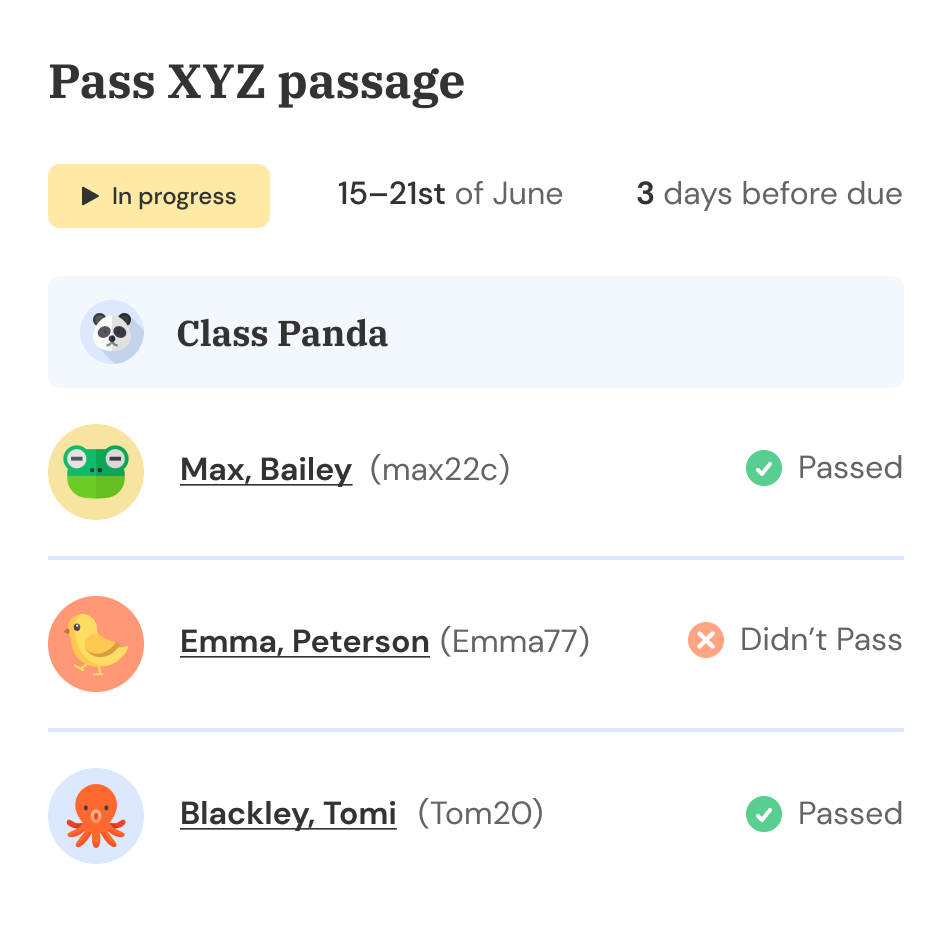
Save time with automatic marking
Put down the red pen, we’ve got you covered! Bonus points – set Recurring Activities once, and you’re good for the year!

Easy-to-use reporting
Track individual student and class progress in real-time. Identify where additional practice is needed.

Access thousands of exercises
With thousands of interactive exercises and worksheets, you can find the perfect activity for your students.

Win prizes and build class culture
Motivate students to read with engaging class competitions, badges, and prizes!
Rooted in research, proven in results
of teachers surveyed reported that ReadTheory contributed to an increase in standardized test scores.

of teachers said students are engaged and interested when using ReadTheory.

ReadTheory is free to use.
Register for an account now and be up and running in a couple of minutes.
Are you an admin looking to bring ReadTheory to your school or district?
Bring readtheory to your school or district.

Are you a learner at B1 English level (intermediate) ? This section offers reading practice to help you understand texts with everyday or job-related language. Texts include articles, travel guides, emails, adverts and reviews.
Each lesson has a preparation task, a reading text and two tasks to check your understanding and to practise a variety of reading skills. Make a start today.
Choose a reading lesson

A conference programme
Read the programme for a management conference to practise and improve your reading skills.
- Read more about A conference programme
- Log in or register to post comments

A flyer for a gym
Read a flyer promoting a new gym to practise and improve your reading skills.
- Read more about A flyer for a gym

A travel guide
Read a travel guide about Bangkok to practise and improve your reading skills.
- Read more about A travel guide

An email request for help
Read an email asking for help from another department to practise and improve your reading skills.
- Read more about An email request for help

Digital habits across generations
Read an article about how people at different ages use computers and smartphones to practise and improve your reading skills.
- Read more about Digital habits across generations

Encyclopedia entry
Read an encyclopedia entry on the Taj Mahal to practise and improve your reading skills.
- Read more about Encyclopedia entry

How to spot fake news
Read some tips for spotting fake news to practise and improve your reading skills.
- Read more about How to spot fake news

Innovation in business
Read a blog post about being innovative in business to practise and improve your reading skills.
- Read more about Innovation in business

Planning an event
Read a dialogue where three people negotiate who does what to achieve a task.
- Read more about Planning an event

Robot teachers
Read an article about robot teachers to practise and improve your reading skills.
- Read more about Robot teachers

Social media influencers
Read a blogpost about the impact of social media influencers in the business world to practise and improve your reading skills.
- Read more about Social media influencers

The legend of fairies
Read a text about the legend of fairies to practise and improve your reading skills.
- Read more about The legend of fairies

The Martian: a book review
Read a review of the book 'The Martian' to practise and improve your reading skills.
- Read more about The Martian: a book review
Learn to read English with confidence
Our online English classes feature lots of useful learning materials and activities to help you develop your reading skills with confidence in a safe and inclusive learning environment.
Practise reading with your classmates in live group classes, get reading support from a personal tutor in one-to-one lessons or practise reading by yourself at your own speed with a self-study course.
Explore courses
Online courses

Group and one-to-one classes with expert teachers.

Learn English in your own time, at your own pace.

One-to-one sessions focused on a personal plan.

Get the score you need with private and group classes.
readingielts.com
Test 4: book review.
This post is exclusively available for READINGIELTS.COM Free Members
Pretty Mess Reading
Book Blog, Unapologetic, Unfiltered, Honest

Book Review Questions You Need To Ask Yourself
I don’t think there is s right way or wrong way to write a book review. I do believe that book review questions prepared before you start writing it helps guide you to write the best review you can.

Up until recently, I would spend hours trying the write the perfect review. Sometimes I would delete a review that I spent hours writing only to start over. Now I have a list of book review questions to help guide me through the process of writing that perfect book review.
The book review questions or guide formula is super easy to follow, and it only takes me about twenty to thirty minutes to write out! So, let’s get straight to it.
Make sure you have your favorite book lover cup ready for your favorite drink. Mine is usually vodka, tea, or water. It depends on my mood.
Book Review Question #1
It’s easy to forget which books we’ve read afterward, that’s why I recommend keeping a log of your books right after you finish reading. You can see at first glance what you’ve read. You’re able to notice if you are missing any books in a series and the order of said series.

List the books you’ve read by title, author, genre and rating.
Often you can compare an author’s work to their latest book. Your ratings are all there to view at once. This gives you the ability to let readers know if the authors’ work has improved over time. You can compare star rating within a series, which will add even more depth to your review. Readers love to know whether they should invest in a long book series before they pick up a book. They want your thoughts.
When you are looking at your star ratings, you can decide if you want readers to learn about your 1 star or 5-star reads. It’s all up to you. I like to use this to give variety to my reviews.
Let’s say the last two books I read were both 3-star reviews but I want to give readers a 5-star book review. I’m able to look back to my list and find a 5-star review on my blog.
Or, if I feel like sharing my favorite author’s book, I can take a glance at my list and write a whole review letting readers know that said author is all about.
Book Review Question #2
Start planning your review as you’re reading a book. This is so important when you are reading a physical copy of a book and not on an e-reader . On an e-reader , you’re able to highlight paragraphs and leave notes so you can go back and use later.

Start filling out your book review sheet as soon as you pick up a book.
Keeping track of your start and stop date is essential to a good book review. We all know that we read books we love a lot quicker than others. If you have a book you started one day and finished the very next day, I’ll be money it must have been a good one.
Tell the reader in your review. Let them know that this book was so good that you couldn’t put it down.
Make note of your thoughts as you are reading. When something stands out to you, good or bad, write it down. Write down a couple of sentences and I guarantee you will be able to turn those sentences into paragraphs.
Write down your favorite quotes or the page number to use in your review. Readers love a good quote. It gives substance to your review. It’s human nature to feel inspired or connected to quotes. Those alone will help the reader connect to the same emotions you felt while reading the book.
The beauty of quotes in a review is also that you can produce at least one paragraph that leads up to or follows this portion of the book.
You should jolt down at least three questions that you thought of when reading. Once you start writing your review, you can answer a said question or express how much you would love to ask the questions to the author. You’ll have another paragraph or two from your questions alone.
Pin on Pinterest

Book Review Questions #3
Pretend like you are a book club for one. I know it sounds silly but I’ll explain how beneficial it will be. You won’t be considered crazy for answering your own questions either.

Ask yourself questions that you would want to discuss with other people.
When you are writing a review you are having a conversation with the reader. Think of them as your best friend in your book club. Ask yourself what would my friend want to, then answer it.
The most frequently asked question in a book club is, “What do you like most about the book?” Your reader wants to know that. There is so much you can say without giving anything away. It could be the writing style, the funny conversations, the setting, the style of clothes, etc.
Pick 3 to 5 questions from the list provided in the free book reviews guide and turn them into paragraphs.
One of my favorite questions is, “What were some of the important themes?” That question alone could fill an entire review. Readers want to know what the author was trying to convey without giving the story away.
Answer the question according to the book you’re reviewing. If you are reviewing a romance novel, go beyond the love story. Focus on the personal accomplishments of the main characters.
Once you have gathered all the information you need from your book review guide, put everything in order. Start at the beginning of the book and work your way to the end as best as possible without spoiling it for the reader.
I sometimes write reviews with spoilers but I always warn readers first. Those are normally the times where I’m so fired up about a book that I just have to rant, good or bad. I’m known for being pretty messy but the majority of my reviews are positive.
I hope the book review questions or guide help you push out your reviews. Let me know in the comments any tips or tricks you use to write reviews. I love find new ways to do things.
Once you’ve downloaded you book review questions or guide, tell me what you think. I want to see if it works for you too.
Don’t be afraid to add in a few personal details that connected you to the book. It humanizes the reviewer. I like to think of reviewing a book like talking to a friend and friends share personal stories to connect and bond with one another. Connecting with other book lovers is the best thing I get out of reviewing and blogging.
Share this with all your friends:
Hey there! I'm Danielle! I just a girl who loves books. I love books so much that I talk about the stories like they are real. Who knows? Maybe, they are real to me. I do love the book world, it's way better than reality. . .sometimes. . .because. . .I'm also a proud mama bear, wife, and mother!
3 thoughts on “ Book Review Questions You Need To Ask Yourself ”
I don’t do book reviews but this was a great read nonetheless. I keep track of my read list by marking them on Goodreads once I’m done, but I sure could use a journal of some sort to remind me why I liked or hated a particular book (because let’s face it, a lot of it disappears from memory, and only the main gist remains). Thanks for this, Danielle!
I’m so happy you liked the article. I have a digital planner coming very soon and you’ll love this one. It’s a bit more masculine as well 🙂
- Pingback: Free Reading Digital Planner | Pretty Mess Reading
Leave a Reply Cancel reply
This site uses Akismet to reduce spam. Learn how your comment data is processed .
Discover more from Pretty Mess Reading
Subscribe now to keep reading and get access to the full archive.
Type your email…
Continue reading
- Practice Test
- Useful Tips – Tricks
- Full Writing Review
- General Writing Task
- Writing Task 1
- Writing Task 2
- Writing Exercises
- Writing Sample – Topics
- Writing Vocabulary
- Speaking Vocabulary
- Intro Question
- Speaking Part 1
- Speaking Part 2
- Speaking Part 2 – Audio
- Speaking Part 3
- IELTS Books
- Recent Exams
- IELTS Vocabulary
- Essay from Examiners
- IELTS Ideas
Check out Gate.io
Get a $100 Gate.io Points and $5,500 USDTest when you sign up with my link and trade
Sign up to claim
Popular Last 24h
Describe a film that made you laugh, describe a person whom you met for the first time and made you happy, list of top 100 synonyms in the ielts test, first mobile phone, describe an important historical event in your country, makkar ielts speaking jan to apr 2024 final version [pdf], describe an interesting neighbour you know.
- IELTS Test/Skills FAQs
- IELTS Scoring in Detail
- Forecast Speaking – 2023
- List IELTS Speaking Part 3
- List IELTS Speaking Part 1
- IELTS Writing 2023 – Actual Test
Our Telegram
Join our community for IELTS preparation and share and download materials.
The information on this site is for informational purposes only. IELTS is a registered trademark of the University of Cambridge ESOL, the British Council, and IDP Education Australia. This site and its owners are not affiliated, approved or endorsed by University of Cambridge ESOL, the British Council, or IDP Education Australia.
Latest Articles
Writing task 2: governments – environmental, writing task 2: topic education, writing task 1: average number of hours students, writing task 1: internet use for different purposes in australia, ielts speaking part 3: topic teamwork, most popular, topic: experience is the best teacher, describe something difficult you would like to succeed in doing, in many countries,today there are many highly qualified graduates without employment..
ieltspracticeonline All Rights Reserved

IELTS ONLINE TEST
IELTS READING PRACTICE TESTS
Book Review IELTS Reading Answers with Explanation
Luyện tập đề IELTS Reading Practice với passage Book Review được lấy từ cuốn sách IELTS Cambridge IELTS Practice Test 13 - Test 4 - Passage 3 với trải nghiệm thi IELTS trên máy và giải thích đáp án chi tiết bằng Linearthinking, kèm list từ vựng IELTS cần học trong bài đọc.

📖 Bài đọc (reading passage)
❓ câu hỏi (questions), 🔥 answer key (đáp án và giải thích), giải thích chi tiết.
Thông tin trong bài đọc
an economist and advocate of ‘positive psychology’ summarises the beliefs of many people today...
It (= positive psychology) is an astonishingly crude and simple-minded way of thinking
=> Nếu ko có vốn vocab rộng vẫn có thể đoán rằng: tác giả cho rằng positive psychology là 1 cách nghĩ simple - đơn giản, ko bao hàm nhiều thứ.
Those (= advocates of positive psychology) who think in this way are oblivious to the vast philosophical literature
IELTS Reading Practice
Gồm làm đề, xem giải thích chi tiết, học từ vựng của những bài thi IELTS Reading phổ biến nhất trên thị trường
Bài viết liên quan
Flying tortoises ielts reading answers with explanation.
Luyện tập đề IELTS Reading Practice với passage Flying Tortoises được lấy từ cuốn sách IELTS Cambridge IELTS Practice Test 12 - Test 3 - Passage 1 với trải nghiệm thi IELTS trên máy và giải thích đáp án chi tiết bằng Linearthinking, kèm list từ vựng IELTS cần học trong bài đọc.

The Search For Extra-Terrestrial Intelligence IELTS Reading Answers with Explanation
Luyện tập đề IELTS Reading Practice với passage The Search For Extra-Terrestrial Intelligence được lấy từ cuốn sách IELTS Cambridge IELTS Practice Test 9 - Test 1 - Passage 2 với trải nghiệm thi IELTS trên máy và giải thích đáp án chi tiết bằng Linearthinking, kèm list từ vựng IELTS cần học trong bài đọc.

Great Migrations IELTS Reading Answers with Explanation
Luyện tập đề IELTS Reading Practice với passage Great Migrations được lấy từ cuốn sách IELTS Cambridge IELTS Practice Test 11 - Test 3 - Passage 2 với trải nghiệm thi IELTS trên máy và giải thích đáp án chi tiết bằng Linearthinking, kèm list từ vựng IELTS cần học trong bài đọc.

Why Fairy Tales Are Really Scary Tales IELTS Reading Answers with Explanation
Luyện tập đề IELTS Reading Practice với passage Why Fairy Tales Are Really Scary Tales được lấy từ cuốn sách IELTS Cambridge IELTS Practice Test 15 - Test 3 - Passage 3 với trải nghiệm thi IELTS trên máy và giải thích đáp án chi tiết bằng Linearthinking, kèm list từ vựng IELTS cần học trong bài đọc.

Snow-Makers IELTS Reading Answers with Explanation
Luyện tập đề IELTS Reading Practice với passage Snow-Makers được lấy từ cuốn sách IELTS Practice Test Plus 2 - Test 1 - Passage 1 với trải nghiệm thi IELTS trên máy và giải thích đáp án chi tiết bằng Linearthinking, kèm list từ vựng IELTS cần học trong bài đọc.

Một sản phẩm thuộc Học viện Tiếng Anh Tư Duy DOL English (IELTS Đình Lực) - www.dolenglish.vn
Trụ sở : Hẻm 458/14, đường 3/2, P12, Q10, TP.HCM
Hotline : 1800 96 96 39
Inbox : m.me/dolenglish.ieltsdinhluc
Theo dõi DOL tại
10 books to add to your reading list in May
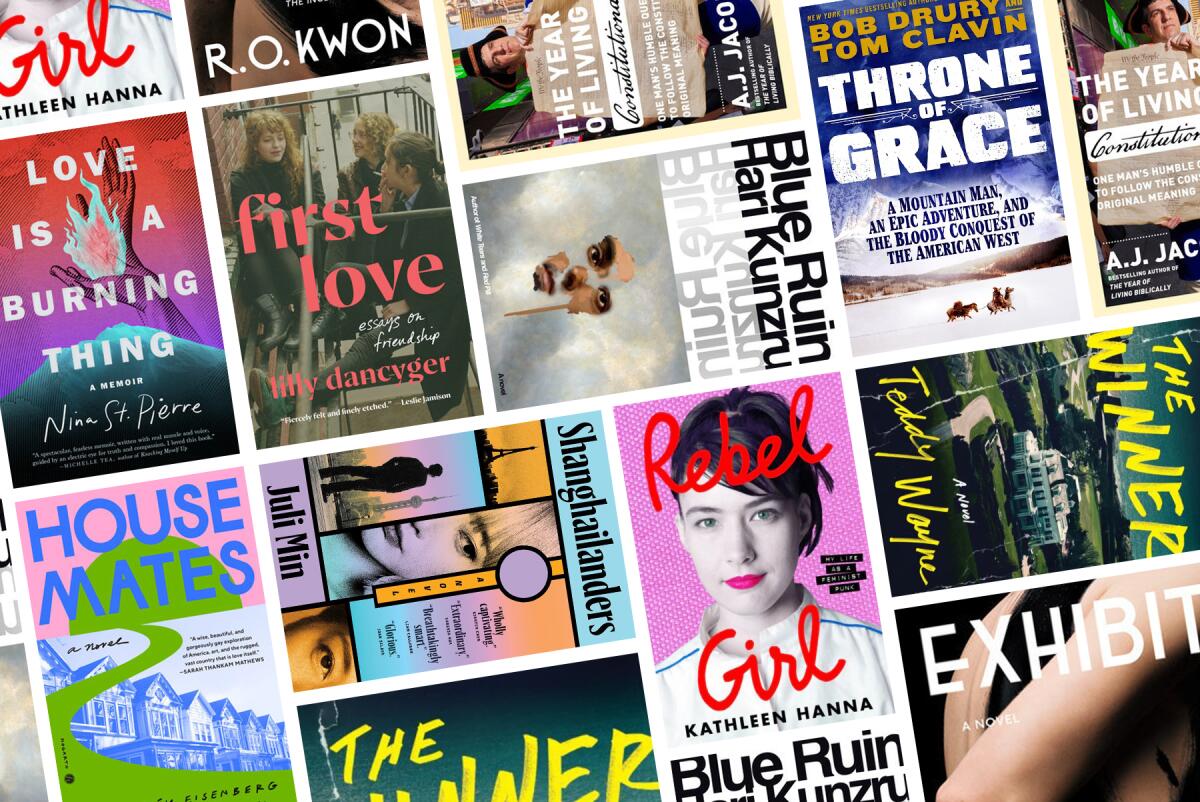
- Show more sharing options
- Copy Link URL Copied!
Critic Bethanne Patrick recommends 10 promising titles, fiction and nonfiction, to consider for your May reading list.
Whether it’s first love or obsessive love or family love, May’s new releases have a lot to say about that which makes the world go ’round. However, if you’re disinclined to pick up a love story, there’s also a U.S. history-based memoir, a great beach read set on Cape Cod and the autobiography of a self-titled “feminist punk.” Happy reading!
Shanghailanders: A Novel By Juli Min Spiegel & Grau: 288 pages, $28 (May 7)
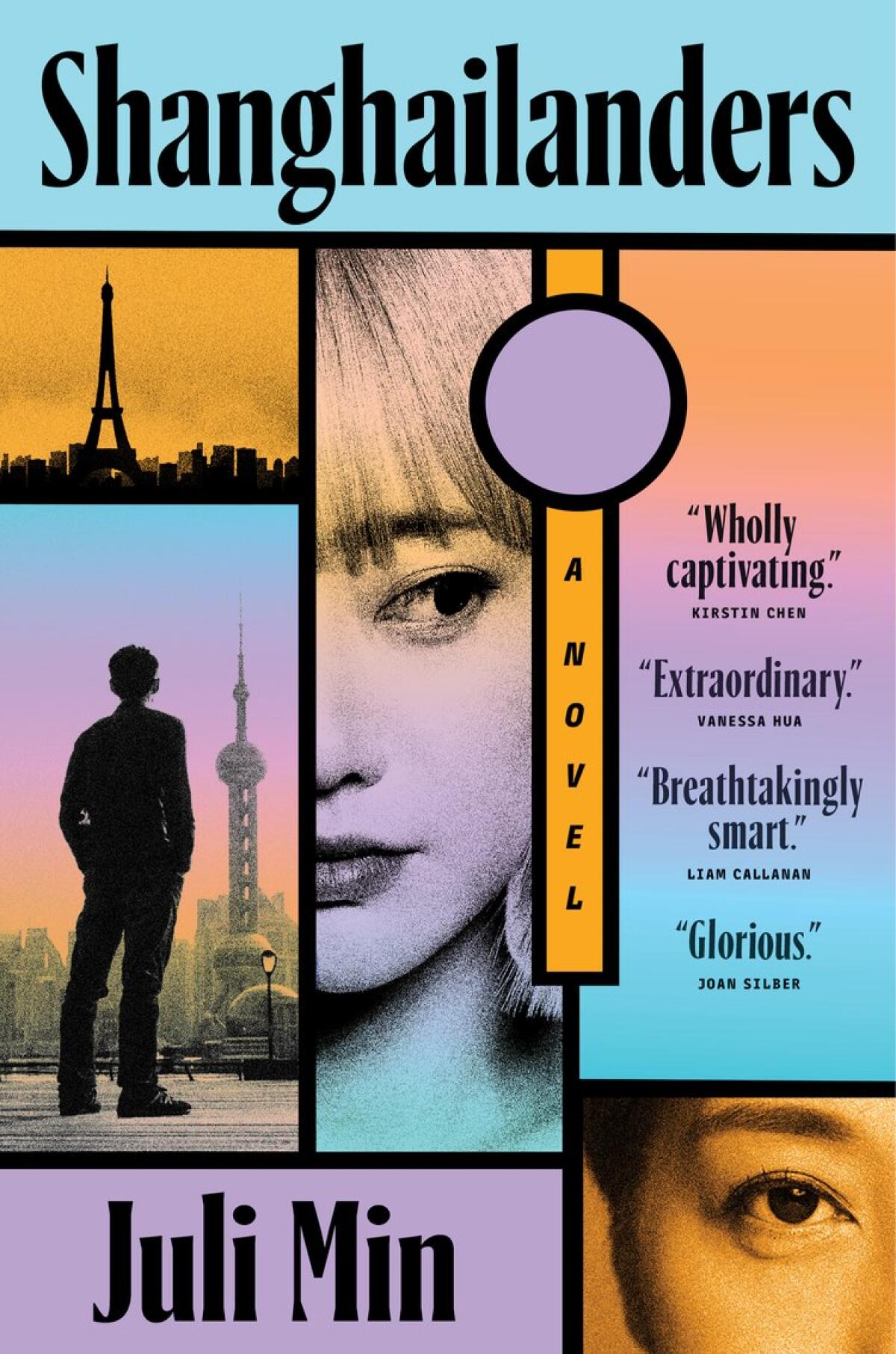
Unspooling backward from an imagined 2040 to 2014, this novel shows a Chinese family coping with 21st-century pressures and pleasures across three continents. The Yangs — father Leo, mother Eko and eldest daughters Yumi and Yoko — will interact with the “baby” of the family, Kiko; a long-suffering nanny, or ayi ; and a cab driver, in chapters that spiral back to a denouement as sophisticated and affecting as Leo, “a real Shanghai man.”
Blue Ruin: A Novel By Hari Kunzru Knopf: 272 pages, $28 (May 16)

Kunzru’s novel ends a trilogy speaking to current problems of racism, right-wing politics and inequality. Struggling artist Jay is delivering groceries during the global pandemic. Not feeling well, he seeks shelter with an ex-girlfriend. Alice, whose husband was Jay’s art-school frenemy, hides Jay in a barn. But isolation of all kinds, including economic, ups the dramatic ante, and the three “friends” must contend with their choices.
Housemates: A Novel By Emma Copley Eisenberg Hogarth: 352 pages, $29 (May 28)
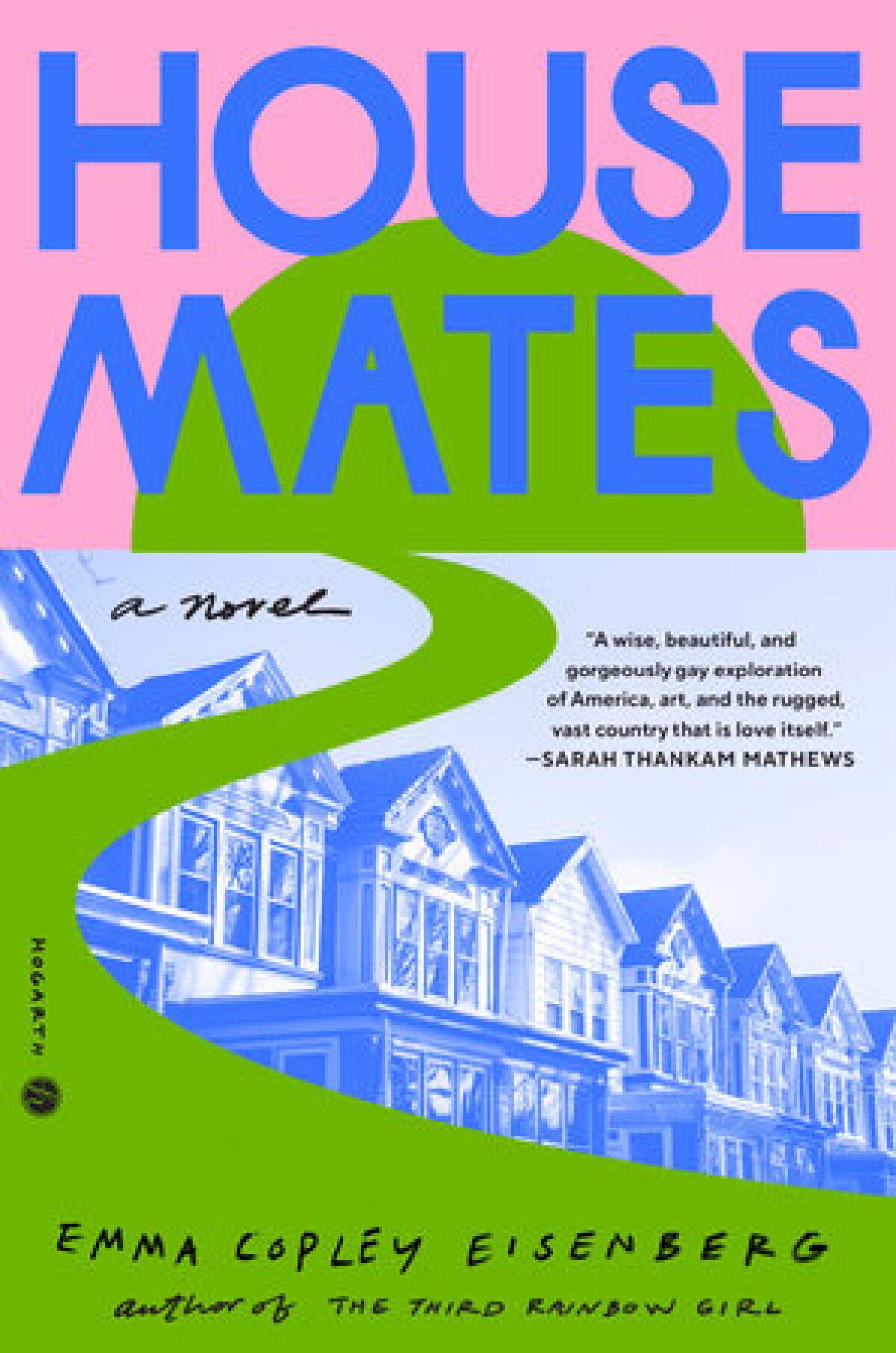
Eisenberg’s fiction debut feels like a swim in a heated pool after a long journey. Bernie and Leah, Philadelphia housemates, embark on a road trip west in order to claim some photography materials from Bernie’s onetime academic mentor. En route, the women meet all manner of characters and discuss all kinds of topics, eventually (some readers will say inevitably) falling in love with each other. They’ll never bore each other, or readers.
Exhibit: A Novel By R.O. Kwon Riverhead Books: 224 pages, $28 (May 28)

Kwon, who tackled obsessive faith in her debut, “The Incendiaries,” and obsessive intimacy in the anthology “Kink,” coedited with Garth Greenwell, here explores the landscape of obsessive desire between the married woman Jin Han and the ballet star Lidija Jung. The author elegantly uses Jin’s belief that she is cursed by an unquiet spirit as a means of expressing the torment Jin feels being divided between safety and ecstasy.
The Winner: A Novel By Teddy Wayne Harper: 320 pages, $30 (May 28)
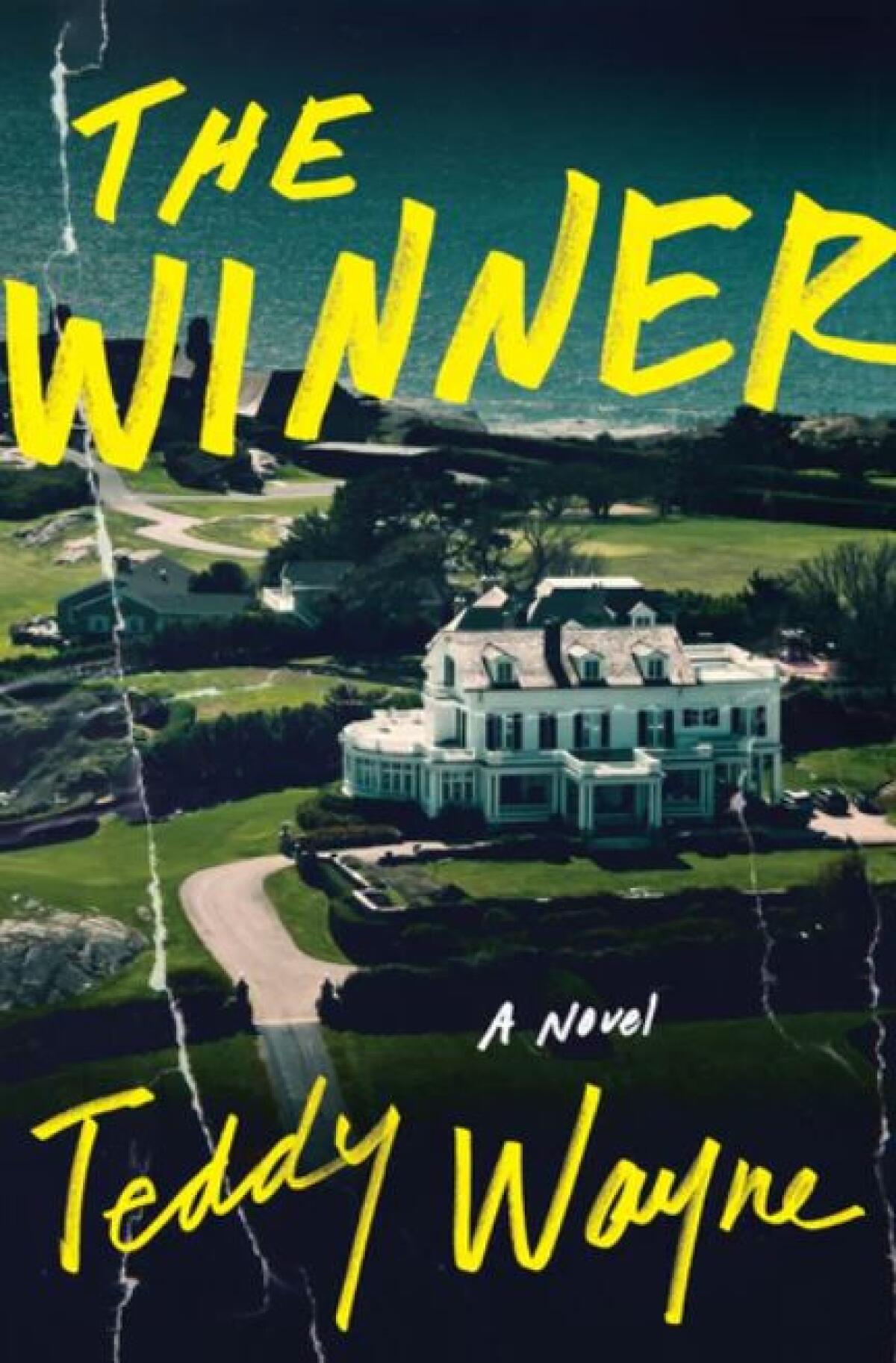
The author sees this novel as a departure from his usual work. But readers will see that even if “The Winner” has a more propulsive plot, it ties in with Wayne’s novels “Kapitoil” and “The Great Man Theory” as it also centers on socioeconomics. Conor O’Toole lands a job as a tennis pro in a wealthy community near Cape Cod and thinks he’s living a dream, juggling affairs with two women — until he hits a metaphorical foul shot.
First Love: Essays on Friendship By Lilly Dancyger Dial Press: 224 pages, $28 (May 7)
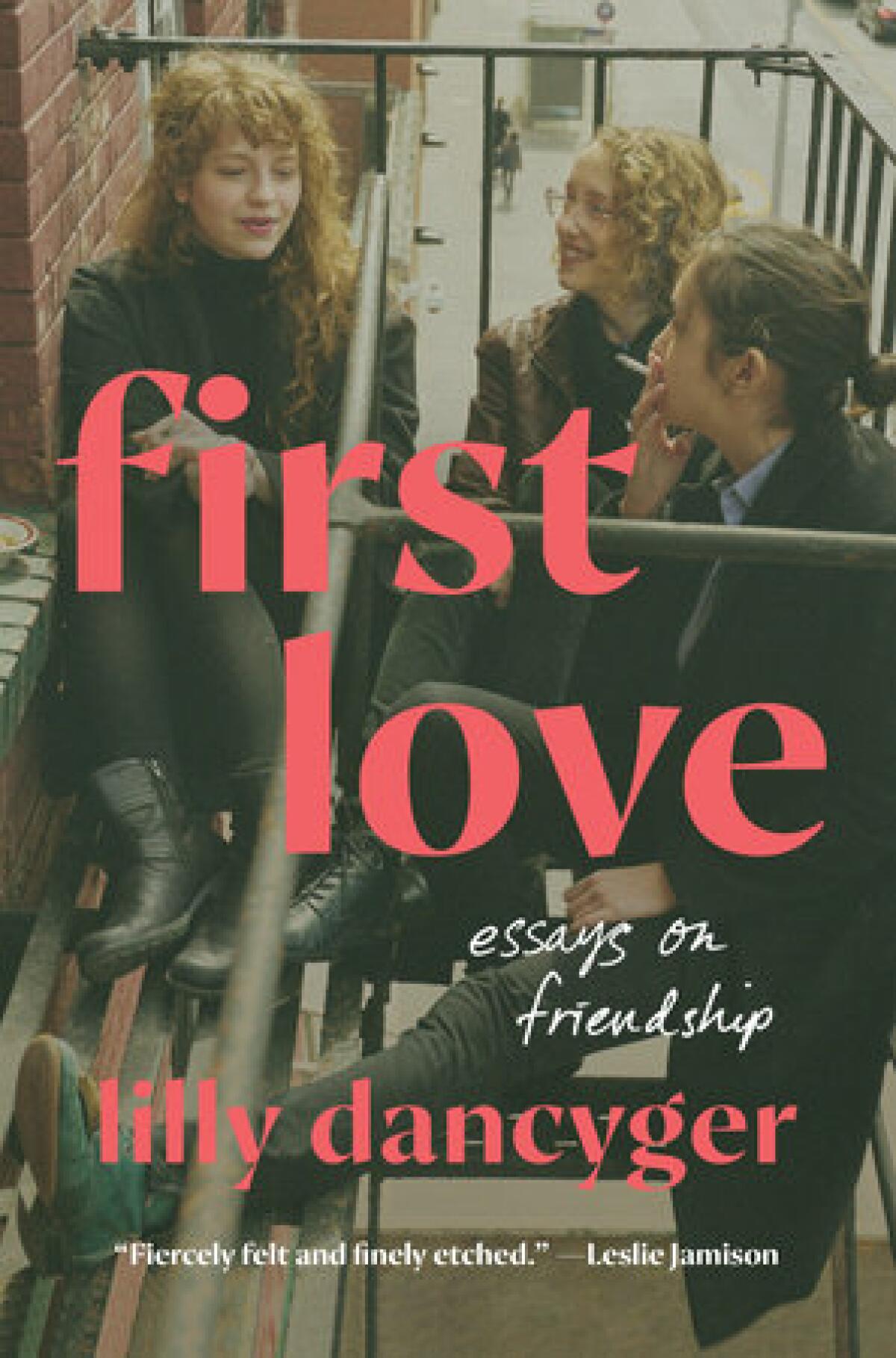
Dancyger, who has written about women and anger (“Burn It Down”) and her parents’ addiction (“Negative Space”), turns to the friendships that have sustained her. From childhood to adolescence and on to adulthood, the author’s intense bonds with other women, based on commonalities as varied as kinship, substance abuse or caregiving, place these essays integrating personal experience and cultural allusions alongside Leslie Jamison’s work.
Throne of Grace: A Mountain Man, an Epic Adventure, and the Bloody Conquest of the American West By Bob Drury and Tom Clavin St. Martin’s Press: 368 pages, $30 (May 7)
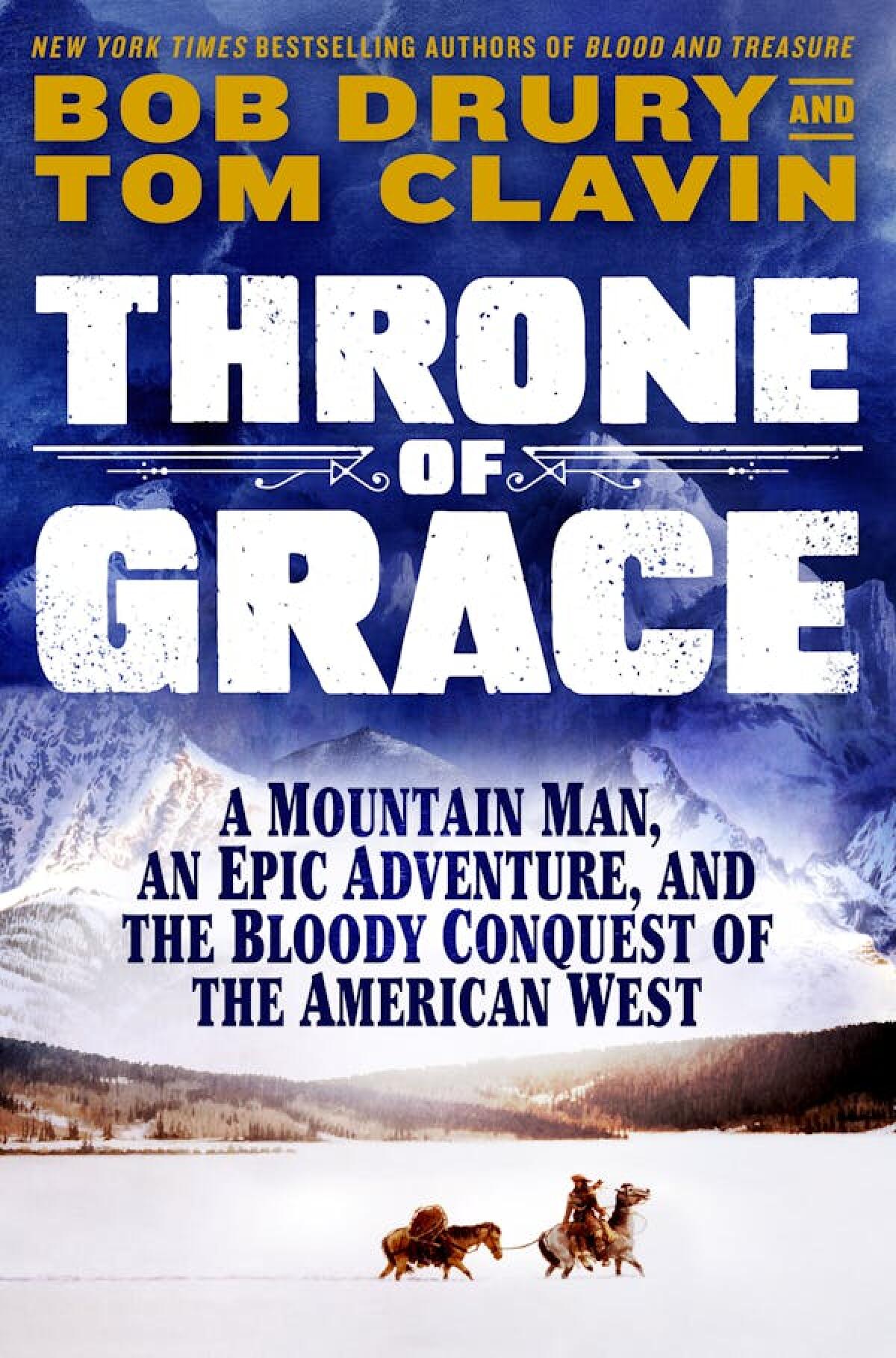
Jedediah Smith might be one of the most important, and one of the most overlooked, 19th century explorers in our nation’s history. Authors Clavin and Drury, who last wrote “Blood and Treasure,” about Daniel Boone, are correcting that oversight. Here they use Smith’s own journals, among other resources, to capture the adventures of a man who was the first white settler to see much of the territory between the Rocky Mountains and the Pacific Ocean, as well as parts of Mexico.
The Year of Living Constitutionally: One Man’s Humble Quest to Follow the Constitution’s Original Meaning By A.J. Jacobs Crown: 304 pages, $30 (May 7)
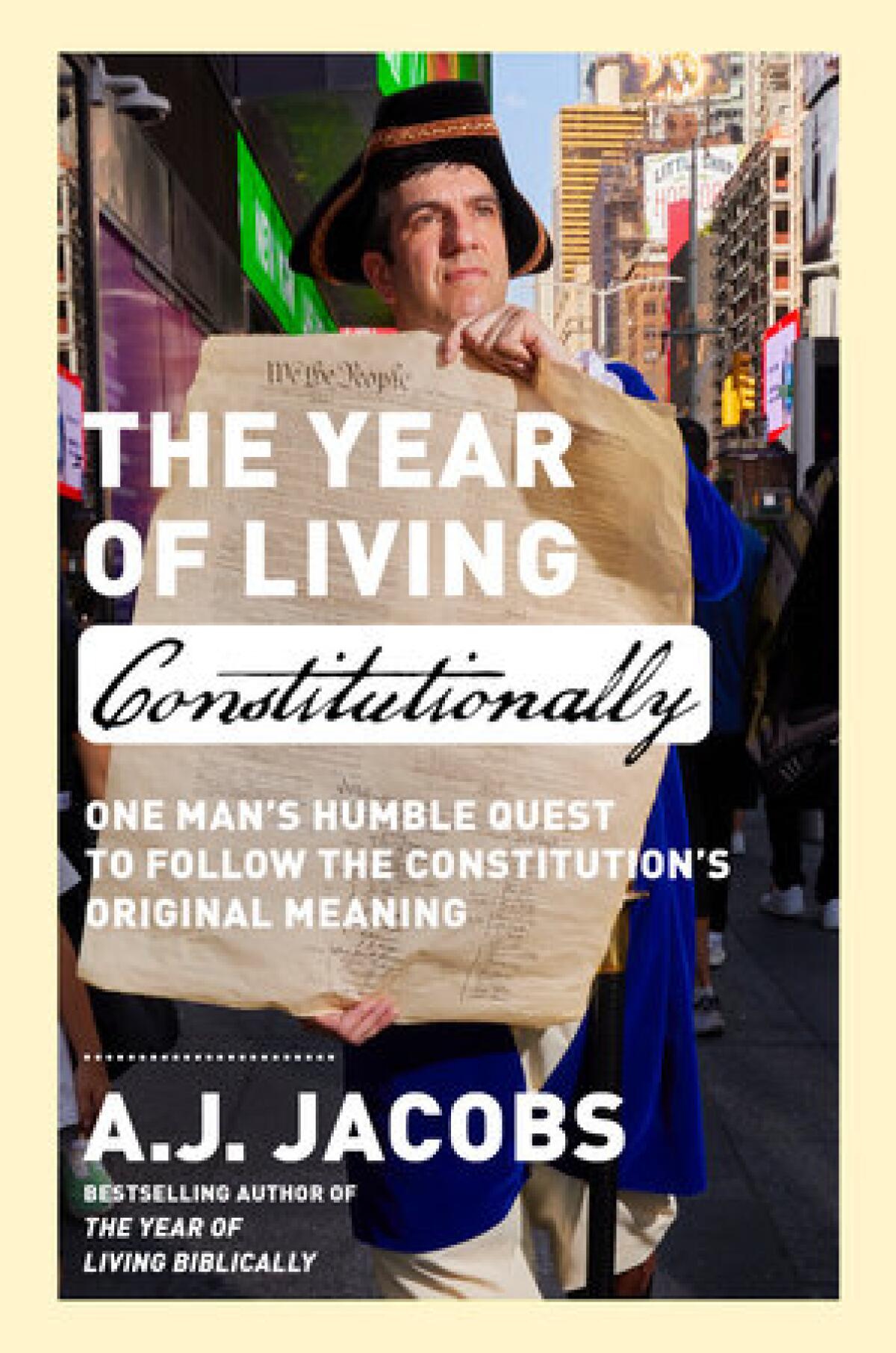
Father of the stunt memoir (“The Know-It-All”) Jacobs examines those we call our Founding Fathers in an endeavor that has the indefatigable author wearing a tricorne hat, battling Redcoat reenactors and delivering quill-written missives to strangers. He challenges assumptions about some truths we have long held to be self-evident. Oh, wait, that’s the Declaration of Independence. Time to read this book!
Love Is a Burning Thing: A Memoir By Nina St. Pierre Dutton: 320 pages, $28 (May 7)
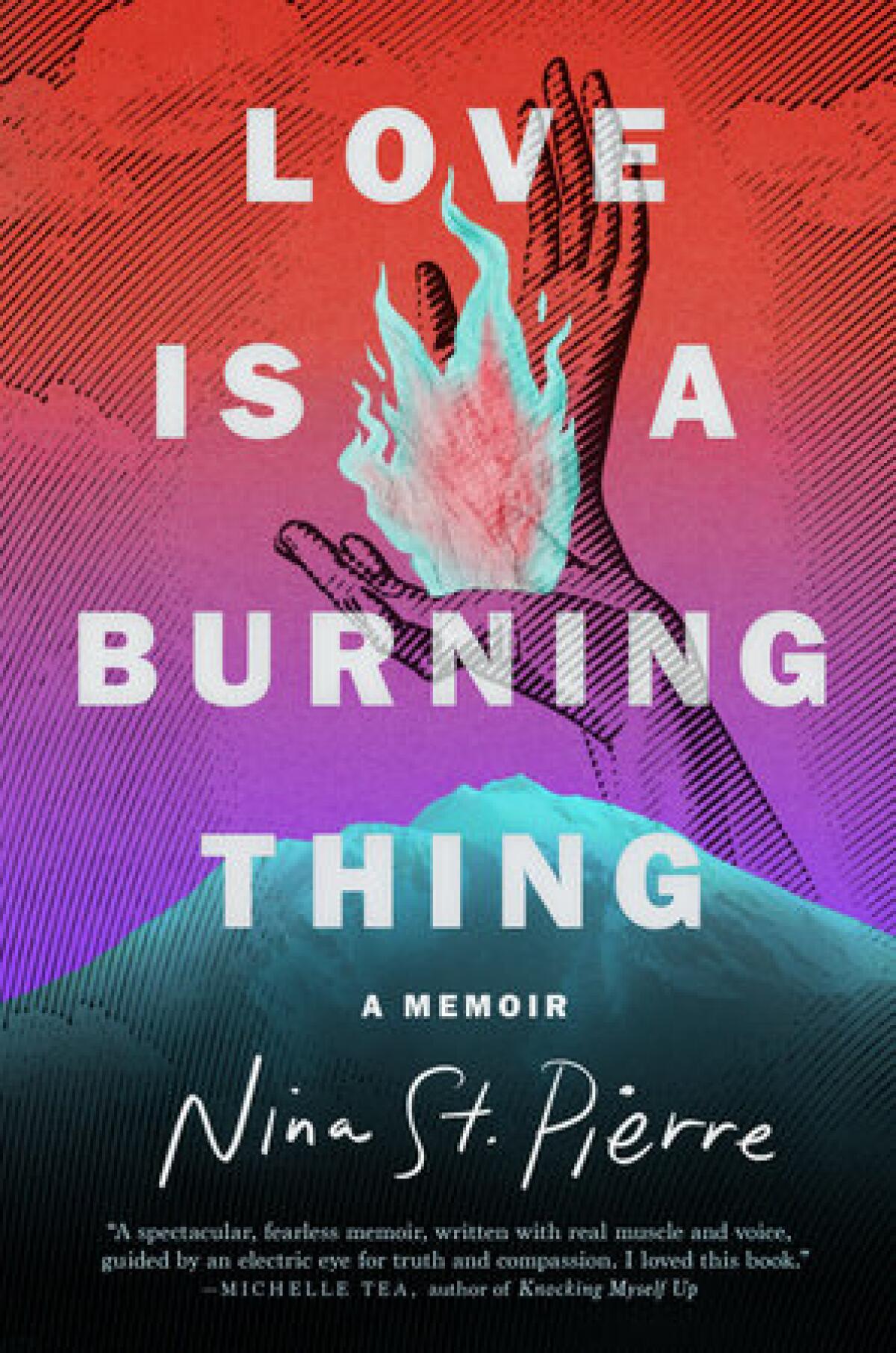
Her mother set herself on fire once, then discovered transcendental meditation. As she chased enlightenment, she moved the author and her brother all over California — until setting another fire that would result in tragedy. As St. Pierre faces her parent’s mental illness, she also investigates how and why people who lose their place in society often turn to extremes of spirituality, as well as how deep compassion can help them find real peace.
Rebel Girl: My Life as a Feminist Punk By Kathleen Hanna Ecco: 336 pages, $30 (May 14)
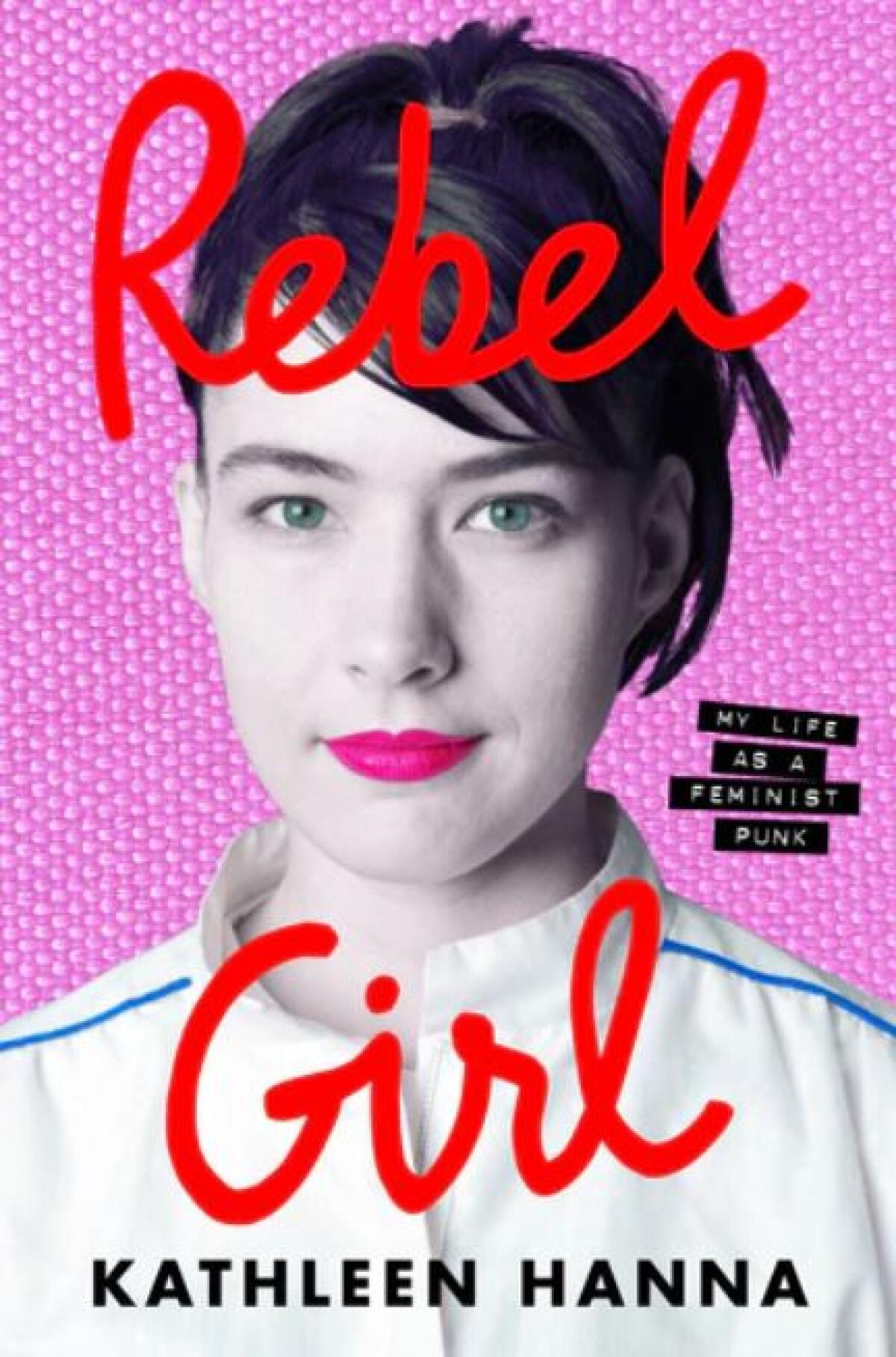
Hanna, the former Bikini Kill frontwoman and co-founder of the Riot Grrrl movement, starts with her difficult childhood and traces its influences into her future actions like “Girls to the Front” and lyrics about gender-based violence. She survived Lyme disease, married the Beastie Boys’ Adam Horovitz and became a parent. Along the way, her views have changed, but her honest, funny and raw voice has not.
More to Read

The week’s bestselling books, May 5
May 1, 2024
The week’s bestselling books, April 28
April 24, 2024

10 books to add to your reading list in April
April 1, 2024
A cure for the common opinion
Get thought-provoking perspectives with our weekly newsletter.
You may occasionally receive promotional content from the Los Angeles Times.
More From the Los Angeles Times

Time travel and surveillance state paranoia collide in a witty, thought-provoking romance novel
April 29, 2024

‘Disability Intimacy’ starts a long-overdue conversation
April 26, 2024

A disorienting, masterful, shape-shifting novel about multiracial identity
April 22, 2024

In Jane Smiley’s rock ’n’ roll novel, does good sense make good fiction?
April 19, 2024

Maybe Erik Larson Should Have Left the Civil War Alone
In “The Demon of Unrest,” present-day political strife inspires a dramatic portrait of the run-up to the deadliest war on American soil.
Maj. Robert Anderson in 1860. Credit... George S. Cook, via Library of Congress
Supported by
- Share full article
By Alexis Coe
Alexis Coe is a fellow at New America and the author, most recently, of “You Never Forget Your First: A Biography of George Washington.”
- April 30, 2024
- Barnes and Noble
- Books-A-Million
When you purchase an independently reviewed book through our site, we earn an affiliate commission.
THE DEMON OF UNREST: A Saga of Hubris, Heartbreak, and Heroism at the Dawn of the Civil War, by Erik Larson
The Civil War is one hell of a drug. It’s plentiful and Main Street-legal, but can induce hallucinatory visions when mixed with inflammatory substances. “I’m so attracted to seeing it,” former President Donald J. Trump confessed at a rally this past Jan. 6, three years after his “Big Lie” inspired followers to storm the Capitol — a feat the Southern Confederacy and its campaign to preserve slavery were unable to accomplish, even as the effort left more than 600,000 people dead in its wake.
In “The Demon of Unrest ,” Erik Larson recounts being “appalled” but also “riveted” by Jan. 6 and by “today’s political discord, which, incredibly, has led some benighted Americans to whisper of secession and civil war.”
When Larson, the reigning king of Dad History, drops a new book on the Civil War a month and a half before Father’s Day in a pivotal election year, he knows what he’s doing. Sort of. “The Demon of Unrest ” is Larson’s first book on the Civil War. And his green horns show.
Ostensibly, it mirrors his best-selling books — among them, “ The Splendid and the Vile ” and “ The Devil in the White City ” — with the same pulpy, black-and-white cover treatment and bulky page count, satisfying the collect-them-all, size-matters kind of reader.
The drama unfolds between Abraham Lincoln’s election in November 1860 and the following April, when Confederate troops in Charleston, S.C., shelled Fort Sumter and started the Civil War. During those tense five months, Lincoln hoped, despite a pro-slavery mob’s attempt to stop Congress from tallying the vote and decades of physical violence within the Senate and House chambers , that the war might narrowly be avoided.
At the start the outgoing president, James Buchanan, is maddeningly passive in the face of cabinet resignations and seceding states, including South Carolina, where Confederates would see federal forces arriving at Fort Sumter as nothing short of a foreign incursion. “They ought to hang him,” an astonished Lincoln privately remarks, bewildered by Buchanan’s talk of surrendering federal forts.
Publicly, Lincoln maintains a determined yet conciliatory posture even as Larson’s other hero, Maj. Robert Anderson, a former enslaver and the fort’s commander, is under siege by thousands of better-armed Confederate soldiers and running out of supplies. Anderson and his 80 or so men pray for the best while cornered by the worst.

The stage is set. “I invite you now to step into the past,” Larson writes, and he means it. He wants you not just immersed, but engulfed. A Larson book is like the Dead Sea: The extraordinarily dense level of details — “On the stillest nights, at 9 o’clock, Major Anderson could hear the great bells in the distant witch-cap spire of St. Michael’s Church, bastion of Charleston society where planters displayed rank by purchasing pews” — usually allows readers to float on his narrative without much effort.
I tried my best not to swim, but on more than one occasion, I almost drowned from exertion, especially in the incredibly banal final stretch. And still there was something lacking in the book’s 565 pages: Nary a Black person, free or enslaved, is presented as more than a fleeting, one-dimensional figure. Frederick Douglass, a leading abolitionist and standard of histories of the era, warrants no more than a mention.
Black people are primarily nameless victims of an antagonistic labor system that’s causing a political crisis among white Americans. At one point, to differentiate this near monolith, Larson employs the term “escape-minded Blacks,” a curious turn of phrase that suggests there were “bondage-minded Blacks.”
The flattening is all the more noticeable because so many other characters are given shape. Larson offers a cradle-to-coffin biography of the South Carolina congressman-turned-Confederate James Hammond. Lengthy passages on Hammond’s “five-way affair” with (read: sexual abuse of) four teenage nieces are followed by a short, unnervingly euphemistic account of the enslaved women he (and his son) raped and impregnated: Hammond made Sally Johnson “his mistress,” and when her daughter Louisa turned 12, he “made her his mistress as well.”
Larson’s magnolias-under-the-moonlight word choice is inadequate. Sally and Louisa were damned to Hammond’s forced labor camps, along with more than 300 enslaved people who “had a penchant for dying.” But they got Christmas off, Larson notes; Hammond “held a barbecue” and, on one occasion, “gave a calico frock to every female who had given birth.”
“Cotton is king,” Hammond declared in 1858. The phrase would come to epitomize the newly minted Confederacy’s misguided confidence in both its economic domination and the war. The greatest echo of the present day in “The Demon of Unrest” may be Larson’s newcomer ego, a swaggering disregard for the difference between the shopworn and the truly complex that leads straight into the pitfalls of nostalgia and hubris.
At his Jan. 6 anniversary rally, a century and a half after the Civil War ended, Trump suggested that Lincoln could have negotiated his way out of the conflict and avoided the killing — but only at great personal cost. “If he negotiated it,” Trump observed, “you probably wouldn’t even know who Abraham Lincoln was.” What better reason could there have been to fight?
THE DEMON OF UNREST : A Saga of Hubris, Heartbreak, and Heroism at the Dawn of the Civil War | By Erik Larson | Crown | 565 pp. | $35
Explore More in Books
Want to know about the best books to read and the latest news start here..
How did fan culture take over? And why is it so scary? Justin Taylor’s novel “Reboot” examines the convergence of entertainment , online arcana and conspiracy theory.
Jamaica Kincaid and Kara Walker unearth botany’s buried history to figure out how our gardens grow.
A new photo book reorients dusty notions of a classic American pastime with a stunning visual celebration of black rodeo.
Two hundred years after his death, this Romantic poet is still worth reading . Here’s what made Lord Byron so great.
Harvard’s recent decision to remove the binding of a notorious volume in its library has thrown fresh light on a shadowy corner of the rare book world.
Bus stations. Traffic stops. Beaches. There’s no telling where you’ll find the next story based in Accra, Ghana’s capital . Peace Adzo Medie shares some of her favorites.
Each week, top authors and critics join the Book Review’s podcast to talk about the latest news in the literary world. Listen here .
Advertisement
- Skip to main content
- Keyboard shortcuts for audio player
Book Reviews
A poet searches for answers about the short life of a writer in 'traces of enayat'.

As a young literature student in the 1990s, the Egyptian poet Iman Mersal stumbled across a copy of Love and Silence , a forgotten 1967 novel by a writer named Enayat al-Zayyat who died by suicide in her 20s — a few years before her book was released.
Mersal was taken with the book's "fresh and refreshing" language and emotional intensity; it exerted such power over her that the moment she finished reading it, she "turned back and began again... [copying] out passages, small stand-alone texts like lights to illuminate my emotional state." At the time, Mersal was establishing herself as a reader and writer, and felt the need to "personally celebrate the books which 'touched' her, as though she needed to define herself by appending her discoveries to the canon."
Decades later, she remains engaged in that project, at least where Enayat is concerned. Now an established poet living in Canada, Mersal set out to learn as much as she could about Enayat's life and death — enough, ideally, to write the other woman's life story. Although she did not uncover nearly enough to achieve that goal, she still presents the resulting book, Traces of Enayat , as a biography of sorts. It isn't. Traces of Enayat is a memoir of Mersal's search, a slow, idiosyncratic journey through a layered, changing Cairo and through Mersal's mind.
Mersal is a cool, restrained writer. Her prose, in Robin Moger's translation, slips by easily, so that her moments of flaring emotion stand out. In contrast, the excerpts of Love and Silence she includes are hot with description and feeling. In one, Enayat describes feeling "at once imprisoned by this life and pulled toward new horizons. I wanted to pull this self clear, gummy with the sap of its surroundings; to tear free into a wider world." It seems evident that Mersal chose this passage for its echo of Enayat's story. Certainly it evokes one of Traces of Enayat 's central questions: "Was it [Enayat's] decision to end her life that drew me to her," Mersal writes, "or the thought of her unrealized potential" — the wider literary world Enayat never reached? More vexing still is the question not of what draws Mersal to Enayat, but why Enayat's hold over her is so powerful. At the end of the memoir, it's still not clear.
Of course, Traces of Enayat is not designed to satisfy. It's there in the title: we're only going to get glimpses and fragments of its subject — or, really, its subjects. Mersal hides herself behind her search for Enayat; Enayat herself hides in the past. Her best friend, the actress Nadia Lutfi, remembers her vividly, but was too busy working to be fully present for some of Enayat's bitterest disappointments; Enayat's surviving relatives, meanwhile, recall her painful divorce and the rejection of her book by the publisher she'd hoped would release it, but they never had the emotional access to her that Nadia did.
Even Enayat's tomb is hidden. She turns out to be buried in a side wing of a family member's mausoleum and, after much investigating, Mersal manages to visit. This is the book's emotional high point. Mersal weeps, not out of grief but because "standing there in front of her headstone was the high point of our relationship... the tomb was the only place where she actually was. For her life, I had to return to the archive, to the memories of the living, and my own imagination, but I felt now that at last she trusted me, that she had allowed me to reach her." For the first time here, Mersal allows her interest in Enayat to transform on the page into a nearly mystical connection before moving swiftly away from the tomb and the scene. For the reader, this is an answer of sorts: Mersal's link to Enayat goes in some way beyond the explicable. We can't experience it for ourselves.
What we can experience is Mersal's investigation of Egypt after the Nasserist revolution of 1952, the context for Enayat's book and its disappearance. Enayat's work and life do not fit neatly into the prevailing narrative that "Arab women writers [of the period] were primarily concerned with nationalism, that there could be no liberation for women without the liberation of the nation." Love and Silence is about grief and romance; its author, meanwhile, had to battle sexist Nasserist divorce laws to free herself from her husband and couldn't get the court to give her full custody of her son.
Mersal pieces this story together slowly, speculating about the role of Enayat's divorce and one subsequent romantic relationship in the end of her life. She does archival work and visits the places still left from Enayat's Cairo, superimposing the post-revolutionary city Enayat lived in — full of new hopes and colonial legacies — on the contemporary one she describes. These moments are, like the book's other strands, fragments and flickers. Mersal passes over geography the way her prose tends to pass over emotion, never lingering in one place long enough to describe it in depth.
Mersal is a poet and this is, fundamentally, a poet's strategy. A poem is, more often than not, a peek through a cracked window, a fleeting experience rather than a drawn-out one. But Traces of Enayat is a full book, and the degree to which it feels swift and partial is at once a literary achievement and a frustration. In its last passage, Mersal writes that Enayat "wants to remain free and weightless." Maybe so. But by letting Enayat have what she wants, Mersal denies the reader a deeper experience of her own obsession.
Lily Meyer is a writer, translator, and critic. Her first novel, Short War , was published in April 2024.
John James Audubon was flawed. Should he get credit for his good work?
A new book, ‘The Birds That Audubon Missed’ by Kenn Kaufman, delves into the controversies dividing the birding world
For better and worse, the name Audubon has become almost synonymous with birds. The reason, of course, is John James Audubon, whose “Birds of America” project, published from 1827 to 1838, catalogued more than 400 birds in life-size prints. The works captured the avian world in a breadth and detail never before seen, turning its French American creator into a celebrated naturalist.
In recent years, questions have been raised about Audubon’s legacy, starting with the ethics of his work — the Audubon Society has conceded that he “most certainly committed” plagiarism and academic fraud. He also was an enslaver and a critic of emancipation, and sent stolen human remains to an anthropologist who used them to study racial differences.
Given this complicated biography — ably explored by naturalist Kenn Kaufman in his new book, “ The Birds That Audubon Missed: Discovery and Desire in the American Wilderness ” — should Audubon still get “credit for the good work he did, while acknowledging all that was wrong?” Kaufman asks.
Many conservation organizations are asking that question too and arriving at dissonant conclusions about whether to keep the Audubon name. Similar controversy surrounds the names of birds themselves. The American Ornithological Society, which standardizes the English-language common names of birds in the Americas, recently announced that eponymous names (those that include the name of a person) will gradually be phased out in favor of descriptive names, thus putting an end to a practice particularly prevalent in the era of settler expansion. For instance, Scott’s oriole was named in 1854 after Gen. Winfield Scott, who had nothing to do with ornithology but plenty to do with the Trail of Tears, the genocidal forced relocation of Native Americans over which he presided.
Kaufman informs these debates by going to the heart of that era. His book is a must-read for birders curious about so much that lies hidden behind the names in our pastime; it illuminates the personalities, rivalries and shortcomings of the men (no women) of European ancestry (no others need apply) who set out to outdo one another and make a name for themselves by finding and naming birds — and why some birds were overlooked in the process.
In telling these tales, Kaufman sometimes meanders. He quickly settles on Audubon as his main focus, but he has a slight tendency to go down rabbit holes. For instance, he delves into the theory that Audubon was in fact “the Lost Dauphin,” a son of Queen Marie Antoinette and King Louis XVI of France, who may have — or if this theory is correct, may not have — died in prison during the French Revolution. Audubon did not claim this title, but Kaufman nonetheless spends several pages wondering if it might be, a digression that some readers may find intriguing but others may see as extraneous.
But this is just a quibble in a book that brings together such a vast amount of information and presents it in such an engaging way. “The Birds That Audubon Missed” isn’t a dry history; it’s as alive as the birds it describes, thanks to the personal aspect Kaufman weaves into the narrative. In addition to offering his own birding adventures as a living-color counterpoint to the past, Kaufman, best known for his field guides and other books such as “ A Season on the Wind ” (2019), scatters illustrations through the text — some are by Audubon and some are by Kaufman, who boldly attempts to create new paintings in the style of Audubon. The effort highlights just how much Kaufman longs to feel something of what these naturalists of yesteryear experienced. That is where “The Birds That Audubon Missed” excels; the real beauty of the book is expressed in its subtitle, in the moments when Kaufman gives in to that longing for discovery and whispers of desire:
“When I watch a flock of sandpipers lift off from a coastal lagoon and climb into the sky, it lifts my soul — not only because of the beauty of their flight, but also because I know they might not touch down for a thousand miles. Scientific knowledge of the migrations of these birds, based on years of research, doesn’t take away from the sense of magic; it makes it stronger.”
A little later, in a passage where he describes curlews as “children of the wind,” you can almost feel yourself carried aloft with these large, dramatic shorebirds as they crisscross the globe in their seasonal wanderings. These musings culminate in a fitting conclusion: that the era of great discovery never ends if all discovery is personal. One’s own revelatory experiences in the natural world are what truly matter.
The fundamental — and unavoidable — problem with “The Birds That Audubon Missed” lies in its “great white men” focus. Kaufman acknowledges from the outset, and mentions occasionally throughout, that this is a particular brand of history stemming from a time that minimized, ignored and discounted anything that didn’t originate from an extremely narrow band of humanity. Indeed, that constitutes one of the criticisms of eponymous bird names. White explorers took credit for “discovering” birds that may have been well known to Indigenous people and then slapped some White friends’ or patrons’ names on them; some of these names we blithely continue to use.
“Our perceptions are shaped by the names and definitions we apply to things,” Kaufman notes of birds that were misunderstood because they’d been labeled and pigeonholed (pun intended) incorrectly; what’s true biologically is even more so culturally. A book exploring the Indigenous knowledge of our avifauna — one that, say, gave primacy to the Choctaw biskinik and its place in that culture, rather than defaulting to the English name of that woodpecker, the yellow-bellied sapsucker — would be welcome. But that’s another book, one that with history’s focus on the dominant narrative might be exceedingly difficult to put together.
Kaufman does an admirable job of exploring the history that’s before us. He didn’t set out to render a verdict on the naming controversies, but he does answer his own question: If we can move beyond hagiography, we can at least acknowledge what Audubon did, for good and ill. And if, as some claim, losing the names means erasing history, then Kaufman’s book is one way to cure this alleged amnesia.
Christian Cooper is the author of “Better Living Through Birding: Notes From a Black Man in the Natural World” and host of the National Geographic TV show “Extraordinary Birder.”
The Birds That Audubon Missed
Discovery and Desire in the American Wilderness
By Kenn Kaufman
Avid Reader. 384 pp. $32.50
More from Book World
Love everything about books? Make sure to subscribe to our Book Club newsletter , where Ron Charles guides you through the literary news of the week.
Best books of 2023: See our picks for the 10 best books of 2023 or dive into the staff picks that Book World writers and editors treasured in 2023. Check out the complete lists of 50 notable works for fiction and the top 50 nonfiction books of last year.
Find your favorite genre: Three new memoirs tell stories of struggle and resilience, while five recent historical novels offer a window into other times. Audiobooks more your thing? We’ve got you covered there, too . If you’re looking for what’s new, we have a list of our most anticipated books of 2024 . And here are 10 noteworthy new titles that you might want to consider picking up this April.
Still need more reading inspiration? Super readers share their tips on how to finish more books . Or let poet and essayist Hanif Abdurraqib explain why he stays in Ohio . You can also check out reviews of the latest in fiction and nonfiction .
We are a participant in the Amazon Services LLC Associates Program, an affiliate advertising program designed to provide a means for us to earn fees by linking to Amazon.com and affiliated sites.


COMMENTS
This post can simply guide you the best to figure out every Reading answer without trouble. Finding IELTS Reading answers is a step-by-step routine and I hope this post can assist you in this topic. Cambridge 13 Reading Test 4 Passage 3: The headline of the passage: Book Review. Questions 27-29: (Multiple Choice Questions)
Overview. The "Book Review" passage of the IELTS reading section includes a reading passage related to task 2 with three distinct question types, appropriate answers, and explanations. By utilising this practice exam, you can evaluate your performance, correct your mistakes, and devise a plan to complete the reading test in the allocated time.
IELTS Academic Test - Passage 12: Book Review reading with answers explanation, location and pdf. This IELTS reading paragraph has been taken from our huge collection of Academic & General Training (GT) Reading practice test PDFs. CONTENTS + Book Review. The Happiness Industry: How the Government and Big Business Sold Us Well-Being ...
Welcome to this IELTS Academic Reading Practice Test for Book Review Reading Answers. In this test, you can practice your reading skills and test your comprehension abilities through a book review passage. The test will include a set of three types of questions: multiple-choice, summary completion, and yes/no/not given. You will have 18-20 ...
March 20, 2023. 'Book Review'- Reading Answer Explanation- CAM- 13. Here are explanations of the Questions of passage named 'Book Review', which is from the Cambridge 13 book. The Questions that have been asked are 'MCQs', Blanks and Yes/No/Not Given. You will find the locations of the Reading Answers, Keywords ( highlighted and ...
READING PASSAGE 3. You should spend about 20 minutes on Questions 27-40 which are based on Reading Passage 3 below. Book Review. The Happiness Industry: How the Government and Big Business Sold Us Well-Being. By William Davies 'Happiness is the ultimate goal because it is self-evidently good.
Book Club Discussion Questions Our 3,500 Reading Guides include Discussion Questions, Book Reviews, Author Bios, and Plot Summaries.. Use the SEARCH box (title or author) If you don't find a specific guide for a book, take a look at our Discussion Tips & Ideas.. And remember to check out our other book resources:
In boxes 37-40 on your answer sheet, write. YES if the statement agrees with the views of the writer. NO if the statement contradicts the views of the writer. NOT GIVEN if it is impossible to say what the writer thinks about this. 37. Vargas' style of writing is typical of crime fiction.
Updated On Oct 05, 2023. Recent IELTS Reading Test with Answers - Free PDF. Download. The Academic passage 'A Book Review' is a reading passage that appeared in an IELTS Test. Since questions get repeated in the IELTS exam, these passages are ideal for practice. If you want more practice, try taking an IELTS reading practice test.
Cambridge IELTS 13 - Cambridge 13 reading test 4 answers - saving the soil reading answers, book review reading answers
a. The answers are explained with lots of very convincing calculations. b. But Mark does not die in the storm, and he has been left behind. c. I would recommend this book to all audiences. d. Without the character of Mark Watney, this book would only be a scientific look at survival on Mars. e. This diary style makes the character of Watney ...
Answers and Explanations for Cam 13 Reading Test 4. 1. FALSE. Question: Clippers were originally intended to be used as passenger ships. Key words: clippers, originally, passenger. At the beginning of paragraph 2, we find the statement: "The fastest commercial sailing vessels of all time were clippers, three-masted ships built to transport ...
Bonus tips for writing a book review. Let's wrap up with a few final tips for writing a compelling review. Remember, this isn't a book report. If someone wants the summary of a book, they can read the synopsis. People turn to book reviews for a fellow reader's take on the book. And for that reason... Have an opinion.
The real value of crafting a well-written book review for a student does not lie in their ability to impact book sales. Understanding how to produce a well-written book review helps students to: Engage critically with a text. Critically evaluate a text. Respond personally to a range of different writing genres.
8 It is difficult to understand why music therapy is undervalued. Answer: NOT GIVEN. 9 Sacks held little skepticism when borrowing other theories and findings in describing reasons and notion for phenomena he depicts in the book. Answer: YES. 10 Sacks is in a rush to use new testing methods to do treatment for patients.
It is a fantasy, but the book draws inspiration from the Second Sino-Japanese War and the Rape of Nanking. Crime Fiction Lover reviews Jessica Barry's Freefall, a crime novel: In some crime novels, the wrongdoing hits you between the eyes from page one. With others it's a more subtle process, and that's OK too.
Reading comprehension exercises — online, free, & adaptive. Fits K-12, ESL and adult students. Easily track progress for the entire class.
This section offers reading practice to help you understand texts with everyday or job-related language. Texts include articles, travel guides, emails, adverts and reviews. Each lesson has a preparation task, a reading text and two tasks to check your understanding and to practise a variety of reading skills. Make a start today.
Cambridge IELTS Vocabulary Cambridge IELTS 13 Reading Test 4: Book Review. The Happiness Industry: How the Government and Big Business Sold Us Well-Being By William Davies. Happiness is the ultimate goal because it is self- evidently good. If we are asked why happiness matters we can give no further external reason.
Book Review Question #1. It's easy to forget which books we've read afterward, that's why I recommend keeping a log of your books right after you finish reading. You can see at first glance what you've read. You're able to notice if you are missing any books in a series and the order of said series.
The former N.F.L. player has been living with A.L.S. for more than a decade. Sharing "the most lacerating and vulnerable times" in "A Life Impossible" was worth the physical and emotional ...
IELTS Reading Practice 106: Book Review. 1430. By IELTS Practice Online. The Happiness Industry: How the Government and Big Business Sold Us Well-Being. By William Davies. 'Happiness is the ultimate goal because it is self-evidently good. If we are asked why happiness matters we can give no further external reason. It just obviously does ...
Book Review IELTS Reading Answers with Explanation. Luyện tập đề IELTS Reading Practice với passage Book Review được lấy từ cuốn sách IELTS Cambridge IELTS Practice Test 13 - Test 4 - Passage 3 với trải nghiệm thi IELTS trên máy và giải thích đáp án chi tiết bằng Linearthinking, kèm list từ vựng IELTS cần học trong bài đọc.
Suggested reading from critics and editors at The New York Times. Our recommended books this week include two very different kinds of memoirs — RuPaul's "The House of Hidden Meanings ...
The book then skips ahead to 2021 and lodges us in the perspective of Nick, Lily's son. It's by far the most plodding and prosaic section, giving us chapter and verse on Nick's teenage years ...
Books 'Knife' Review: Salman Rushdie's Answer to Violence The novelist delivers a brave and stoic book about the gruesome attack he suffered in August 2022.
The author sees this novel as a departure from his usual work. But readers will see that even if "The Winner" has a more propulsive plot, it ties in with Wayne's novels "Kapitoil" and ...
The stage is set. "I invite you now to step into the past," Larson writes, and he means it. He wants you not just immersed, but engulfed. A Larson book is like the Dead Sea: The ...
Poet Iman Mersal's book is a memoir of her search for knowledge about the writer Enayat al-Zayyat; it's a slow, idiosyncratic journey through a layered, changing Cairo — and through her own mind.
Kaufman informs these debates by going to the heart of that era. His book is a must-read for birders curious about so much that lies hidden behind the names in our pastime; it illuminates the ...